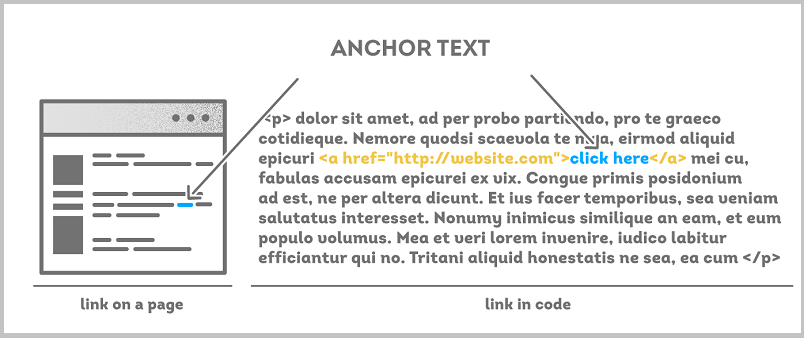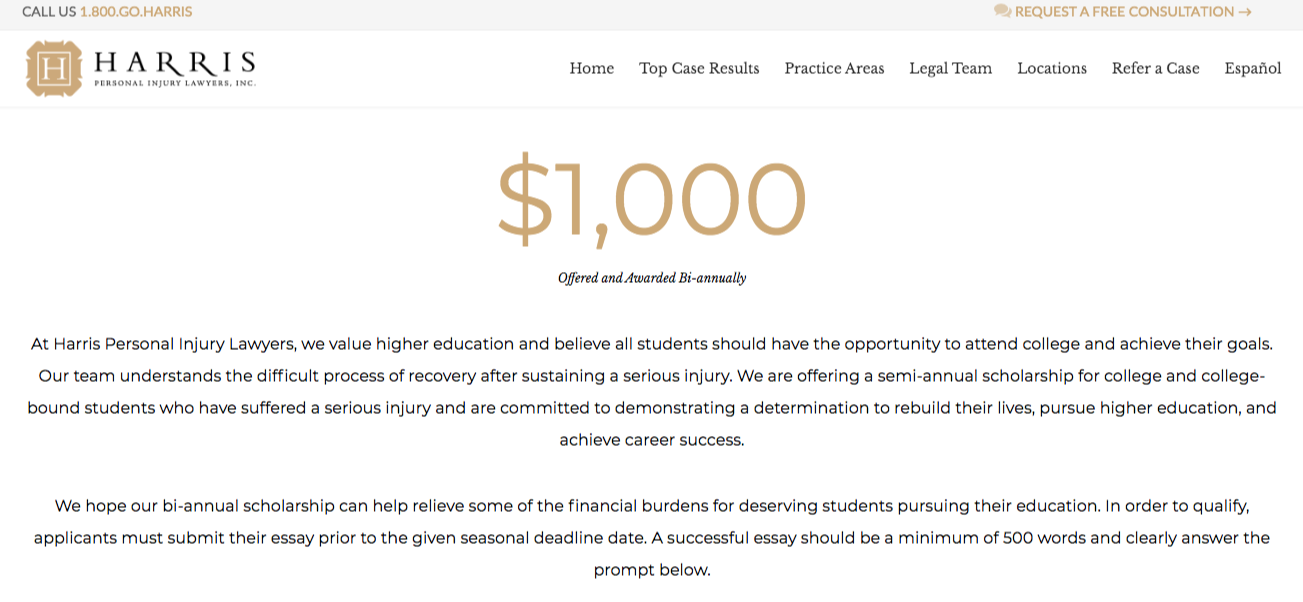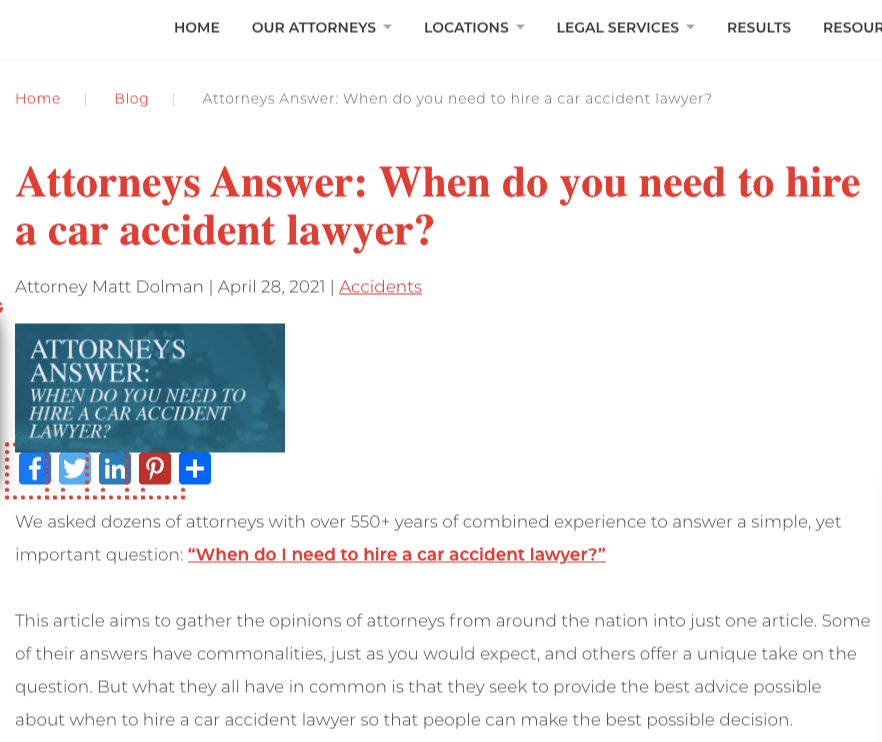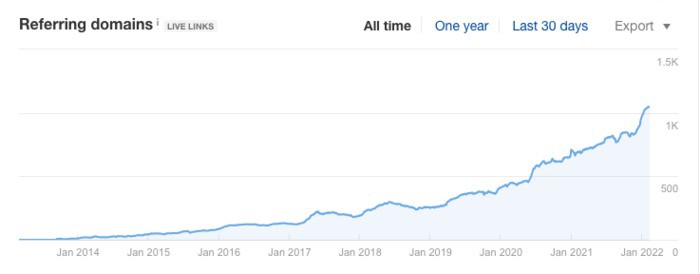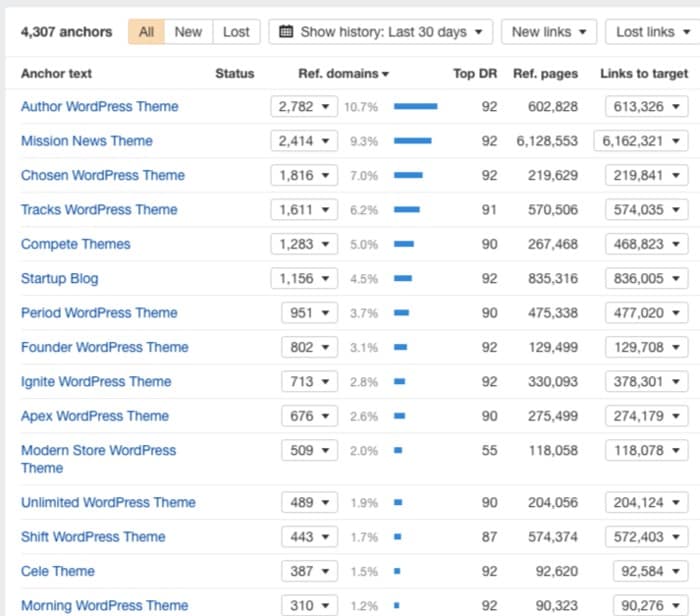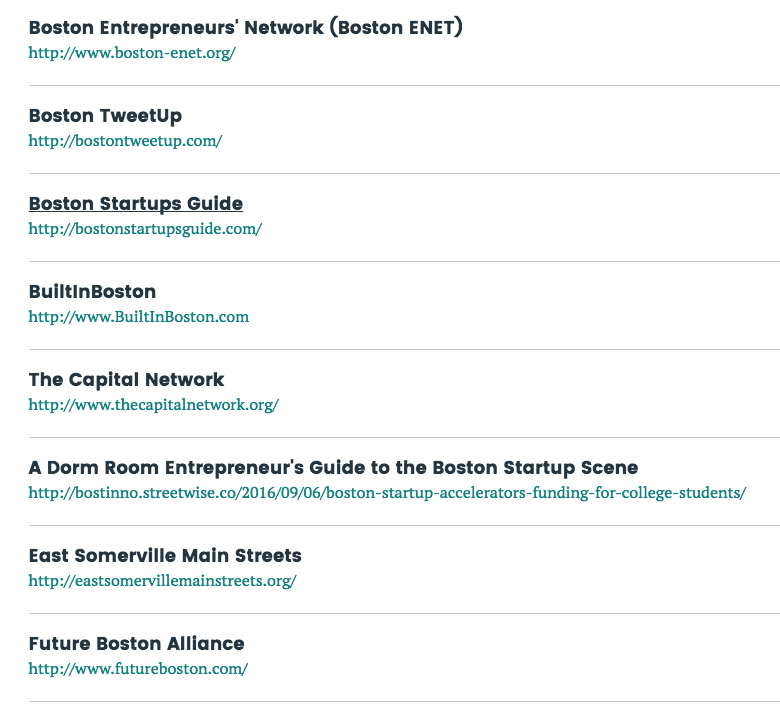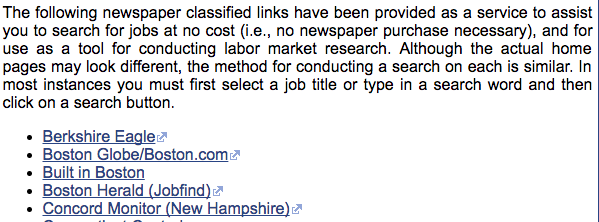Anchor Text: The Definitive Guide
What is an anchor text?
An anchor text is a clickable text that appears as a hyperlink and links to a web page. It tells search engines what the linked page is about, and its usage is an important factor in SEO. Anchor texts should be descriptive and relevant to the linked page's content to help users and search engines understand the page better.
This is an anchor text guide for beginners and advanced SEO and link-building practitioners.
What are the types of anchor texts?
The types of anchor texts are exact-match, partial-match, branded, naked link, generic, and images.
SEO-friendly anchor text is that which clearly describes the linked-to page's content and context, and the surrounding content should provide additional context. It is recommended to use various anchor text types to appear natural to both users and search engines. Remember that excessively using exact-match or other manipulative types can lead to penalties by search engines.
To simplify things, let’s say I want to rank for the term, “link building” and I’m publishing a post for another link building blog with a link to my web page.
If I’d use these types of anchor text, here’s what the link with each type of anchor text looks like.
Exact match anchors – the anchor text is the target keyword you’re trying to rank for.
I’ve shared at SharpRocket a post about link building that includes all actionable tips you need to get quality backlinks for your website.
Partial match anchors – the anchor text contains the target keyword or keyphrase you’re trying to rank for.
I’ve shared at SharpRocket a post about actionable link building tips you need to get quality backlinks for your website.
Branded anchor text – the anchor text is the name of the brand.
I’ve shared at SharpRocket a post about link building that includes all actionable tips you need to get quality backlinks for your website.
Naked URLs anchors – the anchor text is not a word or phrase but the URL of the page or domain itself.
I’ve shared at SharpRocket a post about actionable link building tips. See it here: URL
Descriptive anchors – the anchor text is a description of what the page or URL is all about, it may or may not include the target keyword.
This post at SharpRocket explains what link building is all about and 101 link building tips that includes the exact step by step processes to apply each of those tips.
Generic anchors – the anchor text is a generic phrase that does not include the target keyword.
I’ve shared at SharpRocket a post about link building that includes all actionable tips you need to get quality backlinks for your website. If you want to check it out, click here.
LSI anchors - the anchor text is a synonym or related word or phrase of the target keyword you’re trying to rank for.
I’ve shared at SharpRocket a post about off-page SEO that includes all actionable tips you need to get quality backlinks for your website.
Image anchors – the anchor text is the alt text of the image.

Google Penguin in 2012 and 2023 Forward
Before the Google Penguin update, websites could build massive article directories and guest post links with ~100% exact match anchor texts. This was not a problem for SEOs as they can automate everything, from prospecting link opportunities to putting these links into their desired pages, not considering the relevance between linking pages.
Private blog networks weren’t a big option for link builders then, too, since the usual massive spammy link building tactics were already enough to get website ranking results.
But then Google Penguin came in 2012, which affected websites in different industries. As you can see in the image below, it shows a few statistics of niche websites that were hit back then.
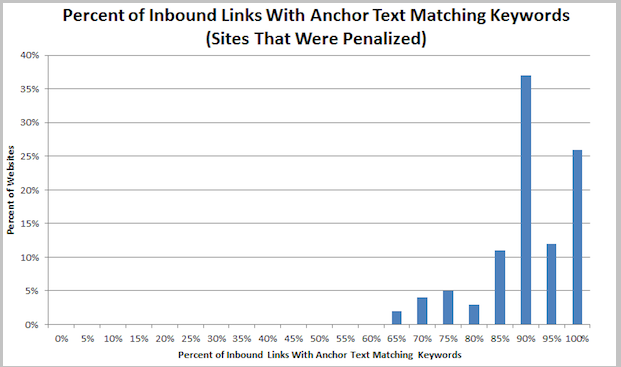
Anchor Text Usage
Anchor text usage on all inbound links is one factor Google considers in determining if a page should be penalized and demoted in its organic rankings.
Aggressive anchor text or too much exact match anchor text on all inbound links for a certain page isn’t a normal activity to think about. Websites with all backlinks with more than 50% exact match anchor texts, “payday loans” for example, are questionable to be natural in their backlinking method.
Source Website
Google’s Gary Ilyes has been tweeted/asked questions on Penguin 4.0 since its launch last September 23, 2016. One point he made is how Google Penguin targets a specific page. He clarified that it’s not just about the link, but rather the “source site” where the link comes from is what they also consider.
Questionable or penalized websites have much more risks to give to you when acquiring links.
To ensure you’re only building high-quality sites, check out the site’s organic traffic data if the linking site has a history of organic drop. This organic drop is a possible sign of Google penalties.
SEMRush can aid you with this task, so have someone check the site’s estimated organic data.
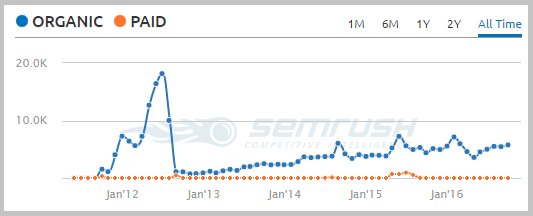
More Granular
The granular attack of Penguin on pages that need to be demoted in its rankings isn’t any newer to the search engine optimization community (in Penguin 2.0, it seemed to be on page-level and keyword-level concerns already). The only thing that becomes clearer here is the word “more”, which we should all consider as we work on the website’s link acquisition campaigns.
It’s just that Google considers page-to-page or a few website parts as its consideration for penalties. In that sense, you shouldn’t be confident enough to think that the spammy link building tactics you are doing right now won’t hurt your website’s health in the future.
More Google Penguin 4.0 Resources:
9 Anchor Text Optimization Best Practices
1. Avoid Acquiring Backlinks With Too Many Exact Match Anchors
I’ve worked with a lot of SEO agencies and digital marketing agencies all over the world, catering to 100+ clients throughout my SEO corporate experience, and there’s one thing people are still confused about:
Are exact match anchors good for my rankings?
When you answer them “YES” right away, they’ll defend you with their “NO”s and just tell you to use generic anchor texts, like click here and go to this site, because they think this is the best anchor text strategy.
Wrong.
Exact match anchor texts aren’t bad at all.
Ryan Stewart had an interesting short case study of how he could rank for Miami SEO after he published a guest post on Ahrefs with the exact match anchor text: “Miami SEO”.
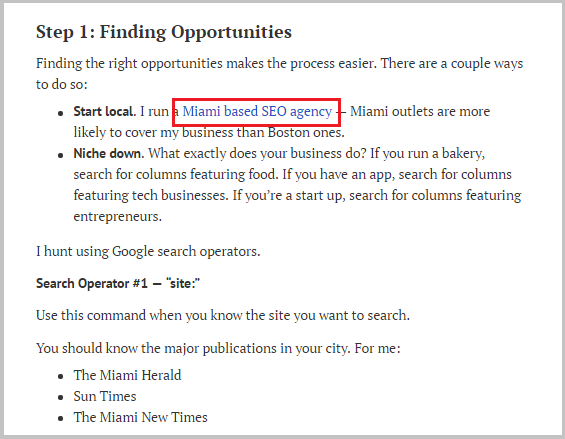
You don’t have to consider the anchor text distribution percentage in your backlink profile - say 3 or 5 percent.
You can test for yourself building one or two backlinks to your page with an exact match anchor text.
Don’t be afraid. Your site won’t get penalized with 1 or 2 backlinks. After all, if you have hundreds or thousands of backlinks, those 2 exact match anchor text links account for less than 1%.
Check how the site will react to those two backlinks and see what movements your page will take you (e.g. from position 40 to position 12). You’ll then also see how tight the competition is for the target keyword you’re trying to rank for.
2. Focus on Various Link Types
It’s so easy to be stuck with the idea of anchor text ratios. While running other SEO activities like technical audit, content creation, and outreach, you still have to think about establishing a natural backlink profile.
Instead of getting a headache with that issue, focus on the link type. After all, why must you create a list of anchor texts with exact/estimated percentages if you’re aiming for a natural link profile?
That itself is unnatural.
A natural link profile is composed of backlinks with different link types.
Here are some examples of different link types.
1. Community-based link
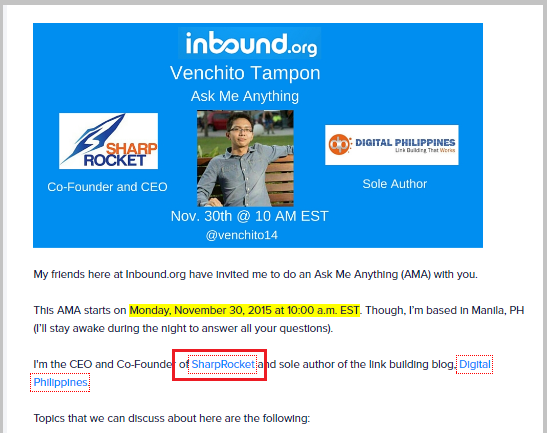
2. Referential link
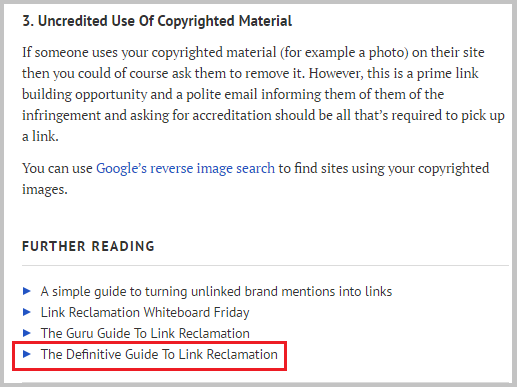
3. Blog comment link
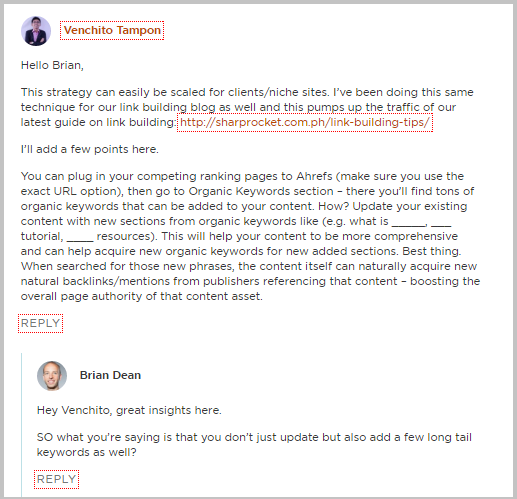
Don’t focus too much on anchor text variations, but ensure that you get various backlink types for your website.
Note: There’s one exception here, I’ve seen websites that focus only on contextual (both earned and built) and resource types of links, and they didn’t acquire directory or citation links but are still dominating SERPs. But if you’re into local SEO, combining those contextual and resource links with local-centric profiles/association/directory links is a must.
But if your site gets directory and citation links with a few to zero contextual backlinks, that looks unnatural.
3. Optimize Clicks Using Descriptive Anchor Texts
If you are still thinking about what anchor text strategy to use for your link building campaign, let me give you one simple tip.
If you are reaching out to bloggers in your industry (assuming it is a linker outreach approach), let them choose anchor texts.
They wouldn’t tell you what anchor texts they chose. They’d only give you a heads-up if they have linked to your page, and you’ll see the anchor texts yourself.
Most of the time, backlinks built using the linker outreach method are in descriptive anchor texts. The advantage of that anchor text is that it encourages user clicks.
While links can help increase rankings, their other purpose is to drive referral traffic.
Letting bloggers choose how and in what section of the linking pages they’ll add anchor texts with backlinks to your webpage affects the number of visitors those referring sites will drive back to your site. Backlinks placed on a higher position of the content have a high chance of more clicks.

One good example is the number of conversions (email subs) from my guest post on GotchSEO. That post itself drove 100+ impressions with 60+ converted email subscribers. That backlink is aimed to be clicked, given that it was placed under the bonuses section.
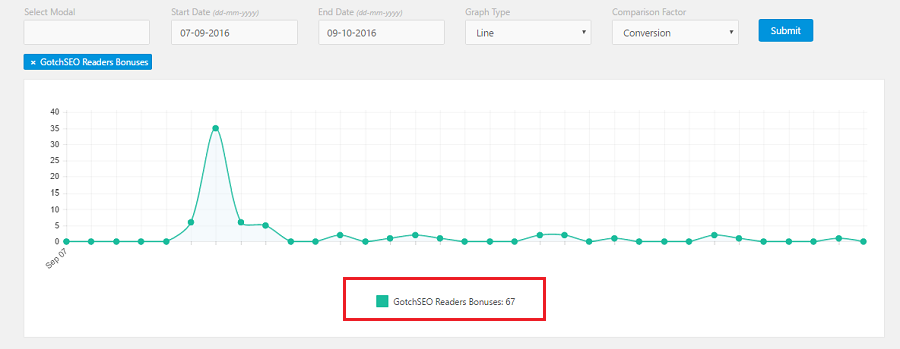
In cases where you have control over anchor text usage, i.e. content distribution on other blogs, it’s imperative to understand LSI and Co-occurrence as part of your overall anchor text strategy.
4. Understand and Use Co-Occurences
Co-occurrence s the frequency and proximity of similar keywords across one context in content. These are topically relevant keywords but not exactly the same as your ranking keyword.
Instead of frequently using your ranking keyword as your anchor text to be an exact match, what you can do is place your target keyword near descriptive anchor texts.
One good example of this is co-occurrences within links to Kaiserthesage. Here are a few examples:
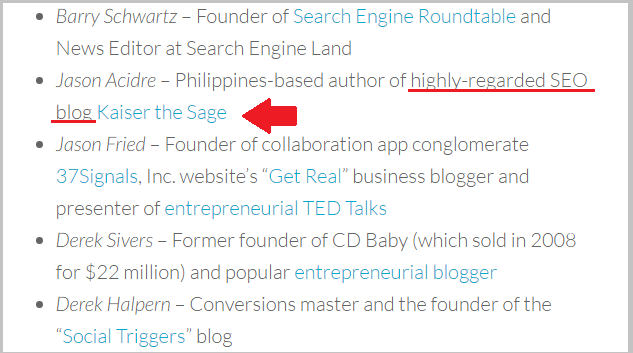
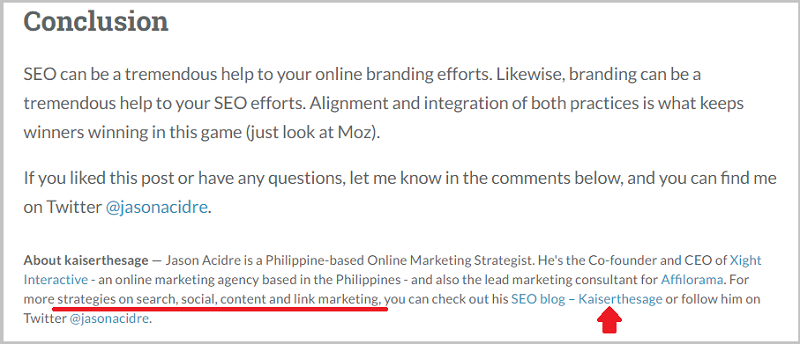

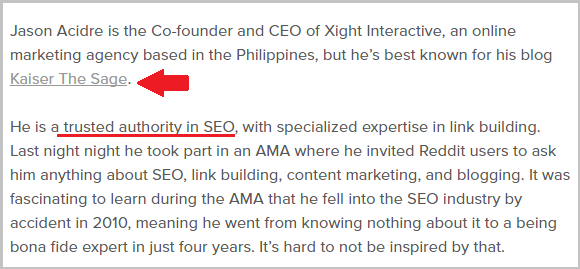
Google understands the relevance of a link without having to use exact match anchor texts all the time. Adding co-occurrences to linking pages can help search engines fully identify the context theme of your website with its linking web pages.
5. Find New Organic Ranking Keywords
When a linkable asset has been ranking for several long-tail keywords, finding untapped match keywords your content isn’t primarily catering to would be strategic.
You tend to rank these keywords (or had some impressions on SERPs) because search engines have highly perceived your content as worthy to rank for pages 3 or so.. (may not be visible on the first two SERPs pages).
The advantage when monitoring new keywords is that you can upgrade your content to cater to new audiences or be more desirable to rank for newly found organic ranking keywords by adding some topical sections to your piece.
What’s the implication of this to your anchor text link strategy?
If you’ve added a new section in your content piece to service those new organic keywords, it’d be additional anchor texts to use for internal and external manual link building. This will add more trust and authority to your content and help it dominate searches for those newly found organic keywords.
6. Search For Related Phrases and Instagram Trends
There is no such activity of finding new ranking keywords to add to your current list of target anchor texts, as you don’t want to use them all for exact match link strategy.
However, when trying to manually add descriptive anchor texts to internal linking pages and build linking pages (i.e. guest posts), you have to know what keyphrases are thematically relevant to your target keyword. Thus, it’d be easy for you to write robust content with LSI keywords and strategically do co-occurrences on links.
Two simple ways to find related search phrases of your target keywords.
First, do a straight Google search for the exact keyword or key phrase you’re trying to rank for. You can try two different searches. One is with quotes. The second is without. See at the bottom of search pages related search phrases Google provides based on the keyword you entered.
Second, just type in your keyword and wait for Google to suggest more specific/relevant search phrases. You’ll find out that some of them aren’t included in your keyword list from Google Keyword Planner or other common keyword research tools you use. They don’t need always to have a high search volume to decide whether or not they are good to target for content pieces.
If you ask me, where is this going? The answer is adding more keyphrases for your anchor text link strategy to be used for LSI keywords for internal and external content assets and to be better at co-occurrences on backlinks.
7. Optimize Content Using Content Gap Monitoring
I’ve been discussing how to find new organic keywords ranking in your content because these are useful for upgrading your content to its next version (or to 10x content if it hasn’t been achieved yet).
While you can simply focus on your content’s search results performance alone, you’d want to try seeing new organic keywords of similar content pieces your competitors normally produce.
The only difference between this process, which I’d like to label as “Content Gap Monitoring” with the typical “content gap analysis,” is that you’re doing it regularly – as part of your monthly SEO or content marketing activity.
SEO agencies that want to test this process out don’t have to worry about the time it’ll consume to run the entire process, as it is scalable through the use of Ahrefs as our primary content gap monitoring tool.
The first step is to find similar competing content. Only choose content assets that are specifically ranked for your target keyword. If you’ve done a robust competitor keyword research analysis as your first SEO initiative, you can skip this part already.
The second step is to monitor new organic keywords competing for similar content assets. Go to Ahrefs, then click on Alerts - New Keywords.
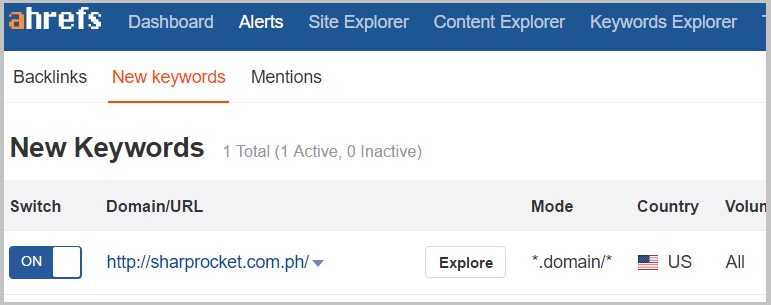
Click add alert button in the right section.

Choose URL as its mode, so you’ll only receive a list of new organic keywords that a specific page has been acquiring, not the whole domain. For volume, the default, “All” is good, so you can also see low-volume keywords.
For email frequency, it’s your decision whether to receive those organic keyword-centric emails weekly or monthly, but I highly recommend you go with weekly to upgrade your existing content for potential ranking keywords as sooner as possible.
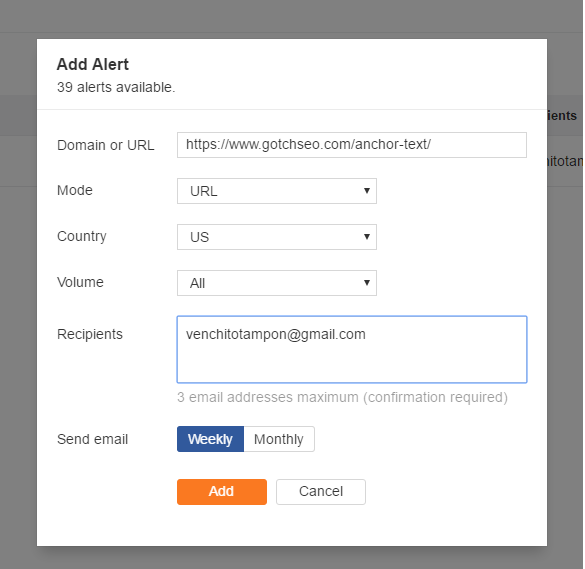
8. Backlink Audit on Exact Match Anchor Texts Links
With the recent Google Penguin update (most SEOs believe that it is indeed real-time), our activity to continuously monitor our site’s incoming links and make sure there aren’t any negative SEO isn’t any more a tedious task for us (SEOs/link builders).
If you have read posts on Google Penguin’s specific effects on SEO activities, there’s no need to make serious efforts to remove existing bad/toxic links to your website, as Google tends to devalue them anyway. So if a site has been receiving new low-quality links from a Negative SEO attack, for example, the efforts now shouldn’t be focused on removing those types of links but on continuously acquiring new high-quality backlinks for your site (this posts of mine on how to get backlinks and actionable link building strategies will help you a lot).
What’s the implication of this to my anchor text diversification?
In cases where those incoming toxic links are on exact match anchor texts, you don’t have to focus on removing them from your backlink profile but on driving new high-quality backlinks to your site. Since websites are dealt with granularly, those bad links won’t affect your site as a whole, only on parts that should be affected.
Nonetheless, a link audit is still a must. Google states that bad links are simply being devalued. The possibility of needing to disavow more links is unlikely. However, if you have a lot of unnatural links and never disavowed them, you need to disavow them. It may be why you’re still not recovering from the penalty.
You still have to do some groundwork for disavowing bad links. But keep in mind that while doing it, the focus shouldn’t just be there but more on helping your site continuously acquire good links to boost your site’s health over time.
If it’s real-time, your site can easily recover (some have proven this to happen to some fully/partially-recovered sites), and there’s much more work now to be put into higher-level link acquisition.
9. Convert High-Quality Exact Match Anchor Texss To Branded Links
Other posts on link audit (which I highly suggest need to be updated) discuss managing exact anchor text links by converting them into branded links.
In my experience, filtering your exact match anchor texts based on their quality should be everyone’s link builders/SEOs’ first initiative.
Don’t spend time converting low-quality exact match anchor texts to branded links, as these will be devalued (if it’s a negative SEO attack) or if they’ve been built by your past SEOs (do a link audit and link removal/link disavow).
What you have to focus on now is checking on only existing high-quality exact-match anchor text links. These links shouldn’t just be any type, i.e. directory or any massive link type, but only editorial links that are manually built, i.e. guest blog posts.
Whether or not these high-quality exact-match links are affecting parts of your website, you should still be converting them into branded links (as possible as you can), by manually reaching out to web admins to whom you’ve contributed guest posts in the past. Ask them if they are capable of changing those exact matches to branded types of links. This should help some parts of your site not to be negatively affected by real-time Penguin.
Now It’s Your Turn…
How do you diversify your backlinks' anchor texts?
Or maybe you have a question about implementing any of the insights in our above list?
Either way, leave a comment quickly below.
I'll be more than happy to reply to comments and answer questions.
So if you have a question, insight, or new tactic, leave a comment right now.
Anchor Texts Frequently Asked Questions
What is anchor text vs keywords?
Anchor text and keywords are two important elements in SEO. Keywords refer to the words or phrases you want to rank for on your webpage, while anchor text is the clickable text in a hyperlink that leads to another page.
In other words, the anchor text provides context to the link and helps search engines understand what the linked page is about. Using descriptive and relevant keywords in your anchor text is crucial to optimize your webpage's ranking.
What is the content of anchor text?
The content of anchor text refers to the words that make up the clickable link. It gives users and search engines context about where the link will take them. Using relevant and descriptive anchor text is important to improve the user experience and help search engines understand the page content. Keep it brief, clear, and concise for maximum impact.
How to Do Local SEO Keyword Research
Undoubtedly, keyword research is one of the most important aspects of any SEO campaign, local or otherwise. Uncovering relevant, high-traffic keywords that you can realistically rank for is essential to the success of your local SEO efforts.
Unfortunately, keyword research can also be one of SEO's most difficult and time-consuming parts. If you're not careful, it's easy to get lost in the sea of data and come up empty-handed.
In this post, we'll share some tips and tricks on how to do local SEO keyword research the right way. By the end, you should have a solid list of keywords to target to improve your local SEO.
In this article, you'll learn:
- What is local keyword research?
- Why is local keyword research important?
- How to Do Local SEO Keyword Research (5 Steps Using Ahrefs)
- How to Track Local Keyword Rankings
What is local keyword research?
Local keyword research is the process of locating high-traffic, relevant keywords that you can rank for in your local market.
Unlike traditional keyword research, which focuses on general, broad keywords, local keyword research is all about finding keywords specific to your geographic area.
For example, if you're a plumber in Los Angeles, you'll want to focus on keywords like "plumber Los Angeles", "emergency plumber Los Angeles", and "24 hour plumber Los Angeles".
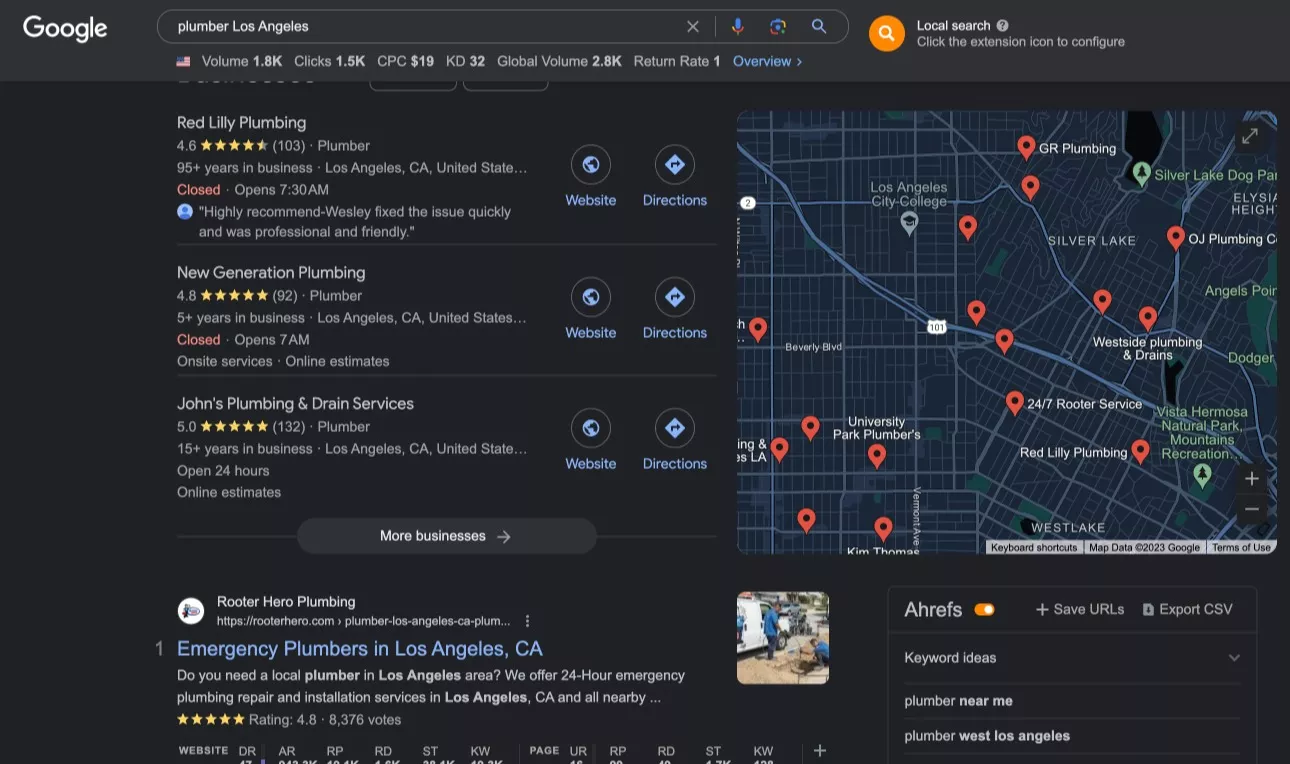
Not only are these keywords relevant to your business, but they're also specifically targeted to users in your city. This makes them much easier to rank for than general keywords like "plumber" or "emergency plumber".
Why is local keyword research important?
If you want your business to be visible in the local search results, you need to be ranking for local keywords. Here are a few other reasons why local keyword research is important:
Local keywords are more relevant to your business.
Think about it this way: when someone in your city is searching for a business like yours, they're not going to type in "plumber". Instead, they will type "plumber Los Angeles" or "emergency plumber Los Angeles".
If you're not ranking for these keywords, you won't appear in the search results. And if you're not showing up in the search results, you won't get any traffic (or customers).
Local keywords are generally more relevant to your brand because they're specifically targeted to users in your city or region. This makes them a valuable asset to any local SEO campaign.
Local keywords are easier to rank for.
Local keywords are generally easier to rank than general, broad ones. This is because there's less competition for these keywords.
For example, we are targeting "coffee shop in San Jose Del Monte Bulacan" for our brick-and-mortar business in the Philippines. Given that the keyphrase is so specific, it only took us weeks to rank on the first page. See below:
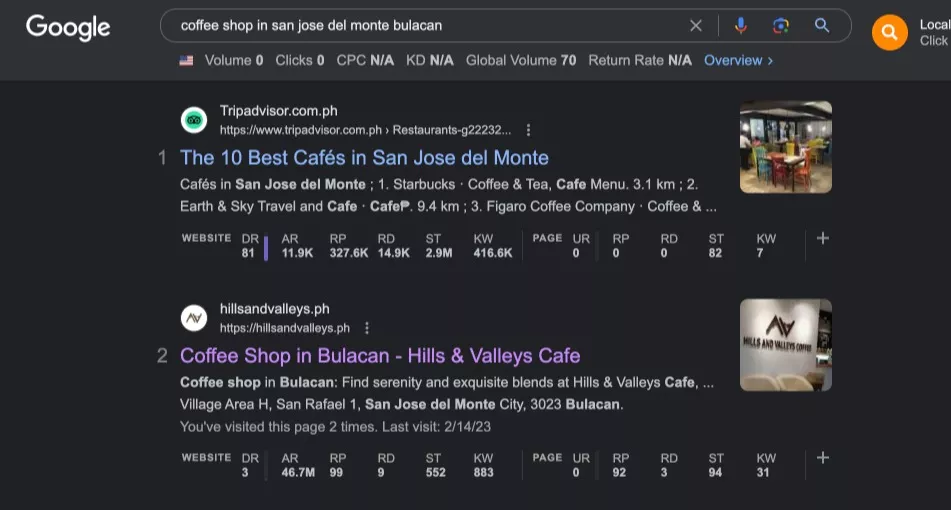
This is good news for your business. It means that, with a little effort, you can rank for local keywords and start getting traffic from the search results.
Local keywords are more likely to convert.
Not only are local keywords easier to rank for, but they're also more likely to convert. This is because users who search for these keywords are usually further along in the buying cycle.
They know what they need, and they're specifically looking for a business like yours in their city or region. This makes them much more likely to convert than someone just searching for a general keyword like "plumber".
To get the most out of your SEO efforts, you need to focus on local keywords. Now let's take a look at how you can find these keywords.
How to Do Local SEO Keyword Research (5 Steps Using Ahrefs)
The best way to find local keywords is with a tool like Ahrefs. Ahrefs is a keyword research tool that allows you to see any keyword's search volume, traffic, and difficulty.
It also has several other features that make it perfect for local SEO keyword research, including:
- The ability to see local search results
- The ability to filter keywords by location
- The ability to see the "local pack" for any keyword
Here's how to use Ahrefs for local SEO keyword research:
Step 1: Set your location
The first thing you need to do is set your location. To do this, go to "Settings" and "Location".
You can either choose your current location or set a custom location. For the purposes of this tutorial, we're going to set a custom location.
To do this, enter the city or region you want to target into the "Location" field and click "Set location".
Step 2: Enter your seed keyword
Once you've set your location, it's time to enter your seed keyword. This is the general, broad keyword that you want to rank for.
For example, if you're a plumber in Los Angeles, your seed keyword might be "plumber".
To enter your seed keyword, go to the "Keywords Explorer" tab and enter your keyword into the "Enter one or more terms" field.
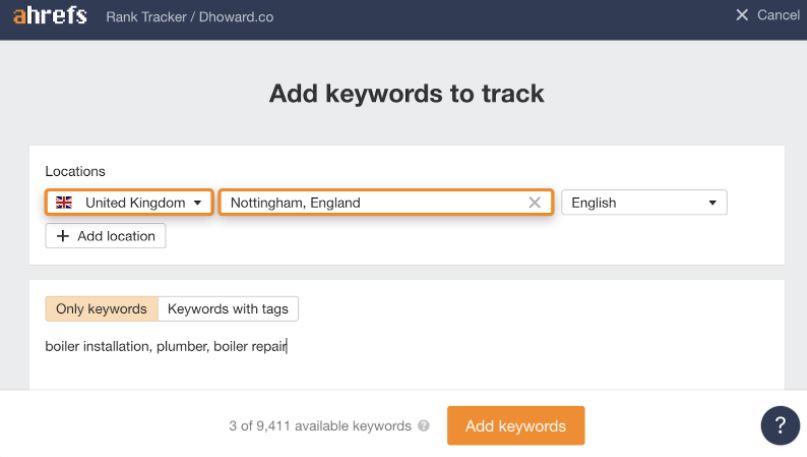
Step 3: Filter for local keywords
Once you've entered your seed keyword, it's time to filter the results for local keywords. To do this, go to the "Filter" dropdown and then click "Location".
This will bring up a new window where you can select the location you want to target. Make sure to select the same location that you set in Step 1.
Once you've selected your location, click "Apply".
Step 4: Sort keywords by difficulty
The next step is to sort the keywords by difficulty. This will help you to find the easiest keywords to rank for.
Go to the "Difficulty" column and click the arrow icon to do this. This will sort the keywords from easiest to hardest.
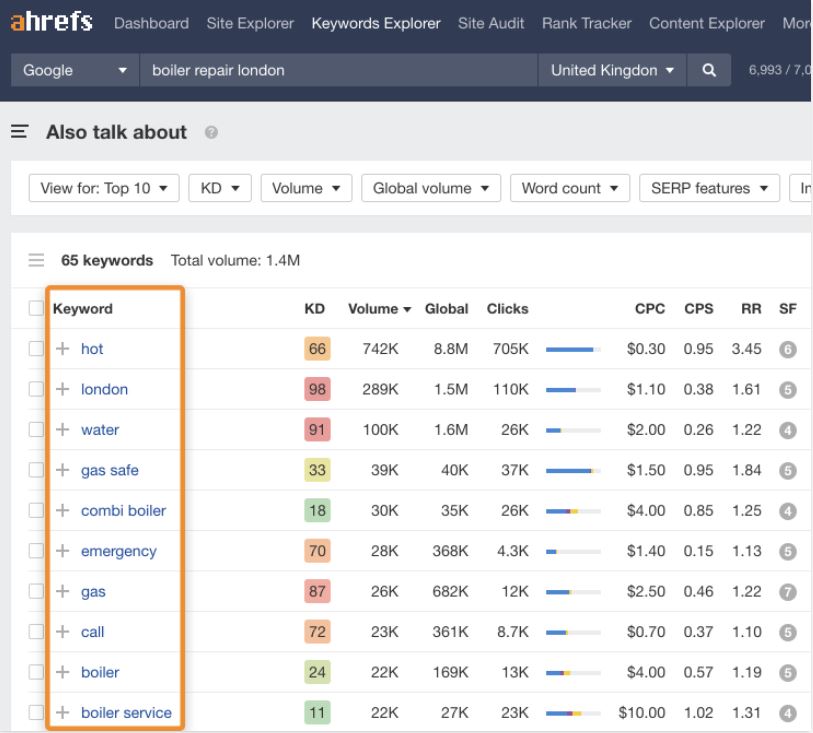
Step 5: Choose your target keyword
Once you've sorted the keywords by difficulty, it's time to choose your target keyword. You will focus on ranking for this keyword in the search results.
How to Choose Which Keywords to Use
When choosing a target keyword, there are a few things you need to keep in mind:
Search volume
The higher the search volume, the more traffic you'll likely get from the keyword.
Competition
The lower the competition, the easier to rank for the keyword.
Difficulty
The lower the difficulty, the easier to rank the keyword.
Once you've considered all these factors, choose the keyword you want to target and add it to your SEO plan.
In deciding which keywords to target, the rule of thumb is usually to target the keywords with the highest search volume and lowest competition.
But that's not absolute, as there are local keywords with 0-10 or zero search volume that can generate hundreds of organic traffic to your website. See what keywords make sense for your business and content theme, and publish pages around those topics.
Other Tools for Local Keyword Research
In addition to Ahrefs, there are several other tools you can use for local keyword research. Some of the most popular options include:
- Ahrefs Keyword Explorer
- Google Keyword Planner
- Moz Local
- BrightLocal
- Whitespark Local Citation Finder
These are all great tools that can help you to find the right keywords for your business.
Next Step: Expand Your Keyword List
Now that you've found some great local keywords, it's time to expand your list.
Google Keyword Planner is a free tool that allows you to enter a seed keyword and see a list of related keywords.
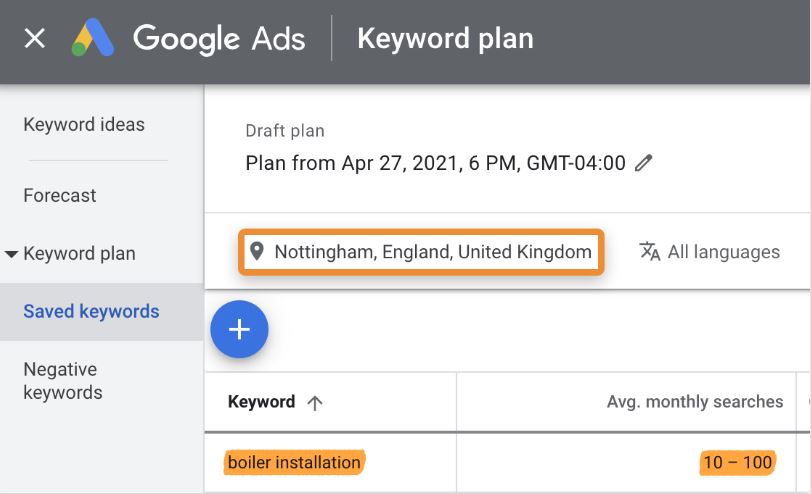
UberSuggest is another tool that can be used to expand your keyword list. It's a free tool that generates a list of related keywords based on a seed keyword.
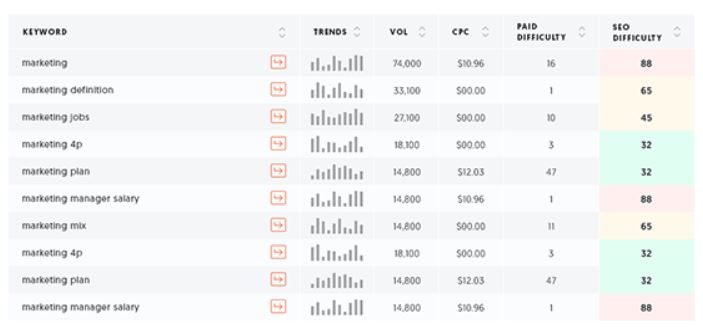
AnswerThePublic.com is a free tool that allows you to enter a seed keyword and see a list of questions related to that keyword.
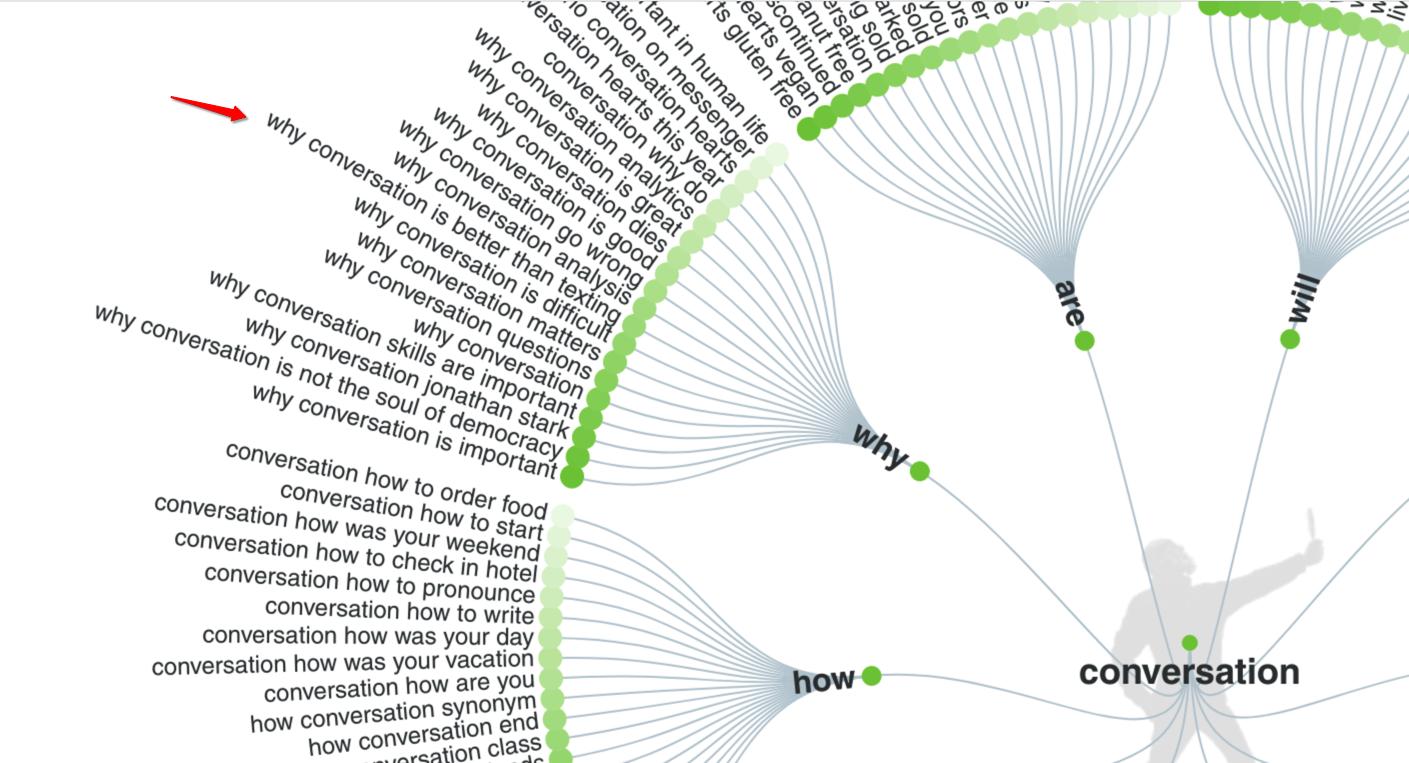
How to Track Local Keyword Rankings
Now that you've chosen your target keyword, tracking your local keyword rankings is time. This will help you to see how well your SEO efforts are paying off and whether or not you need to make any changes.
You can track your local keyword rankings in a few different ways, but the best way is with a tool like Ahrefs.
To track your keyword rankings with Ahrefs, go to the "Rank Tracker" tab and enter your target keyword into the "Enter one or more terms" field.
This will bring up a list of all the keywords you're tracking and their current position in the search results.
You can also see other important information, such as each keyword's search volume, traffic, and difficulty.
Takeaways
Local SEO keyword research is a great way to find keywords you can rank for in the search results. While there are a lot of suggested strategies, the process is quite simple.
With a little effort, you can soon start ranking for high-traffic, low-competition keywords and driving more traffic to your website.
Local SEO Keyword Research Frequently Asked Questions
How do I target local keywords?
To target local keywords effectively, start by researching popular terms specific to your target location. Use tools like Google Trends, Google Keyword Planner, and local search volumes to identify relevant keywords. Incorporate these keywords naturally into your website content, meta tags, and local business listings. Optimize your website for local searches through local schema markup and creating location-specific landing pages.
How to do location based keyword research?
For location-based keyword research, follow these steps:
- Identify your target location.
- Use location-specific keyword tools to find relevant keywords.
- Analyze search volume and competition for each keyword.
- Optimize your website and content with these location-based keywords.
- Monitor performance and make adjustments as necessary.
By conducting location-based keyword research, you can improve your website's visibility and attract local visitors.
How do I track local SEO?
To track local SEO, start by setting up Google Analytics and Google Search Console. Use Google My Business Insights to monitor your listing performance and track keyword rankings in local search. Additionally, implement tools like Moz Local or BrightLocal for comprehensive local SEO tracking. Regularly review your website's organic traffic and local pack placement to gauge the success of your local SEO efforts.
Is local SEO worth it?
Yes, local SEO is definitely worth the effort for many businesses. Whether you have a physical store or offer services in a specific area, implementing local SEO can substantially benefit your business. By optimizing your online presence for local searches, you can increase visibility, attract more targeted customers, and drive higher conversion rates.
How can I SEO research keywords for free?
There are several free SEO research tools available. Here are some of the most popular options:
- Google Keyword Planner
- Moz Keyword Explorer
- UberSuggest
- AnswerThePublic.com
- Rank Tracker
- Google Search Console
- Keyword Tool Dominator
What is included in local SEO?
Local SEO includes optimizing your website for local search engines and directories, as well as making sure your business is listed in relevant local directories.
It also involves optimizing your website content for local keywords and making sure your website is mobile-friendly.
How do I use Google local SEO?
There are a few different things you can do to optimize your website for Google local SEO:
- Make sure your NAP (name, address, and phone number) is consistent across all platforms.
- Claim your Google My Business listing and make sure it is up-to-date.
- Optimize your website content for local keywords.
- Make sure your website is mobile-friendly.
- Add relevant Schema markup to your website.
- Encourage customers to leave reviews on your Google My Business listing.
- Monitor your local SEO efforts with a tool like Ahrefs.
How do you know you need local SEO?
Wondering if your business needs local SEO? Here are signs that you need one:
1) You have a physical location
If you're a brick-and-mortar business, then you need local SEO. Optimizing your website for local search will help customers find your store when they're searching for products or services in your area.
2) You serve a specific geographic area
If you only serve customers in a specific geographic area, then you need local SEO. For instance, if you're a plumber in Los Angeles, you'll want to optimize your website for local search so that people in Los Angeles can find you when they're searching for a plumber.
3) You have an online store
If you have an online store, then you need local SEO. optimizing your website for local search will help customers find your store when they're searching for products or services in your area.
4) You're a service-based business
Service-based businesses, such as lawyers, doctors, and plumbers, need local SEO. This is because people often search for these types of services when they're looking for someone in their area.
5) You want to increase foot traffic to your store
If you're a local restaurant, you'd want to reach diners around your area. One way to get in front of your target audience is to optimize your website for local search. This way, when people are searching for restaurants in your area, your restaurant will come up in the search results.
6) You want to increase phone calls or online bookings
If one of your KPIs is to increase phone calls or online bookings, then you need local SEO. Not only does Local SEO help customers find your business, but it also helps them find your contact information. This way, they can easily get in touch with you to book an appointment or ask for more information.
7) You want to increase online sales
Who doesn't want this, right? If you're looking to increase online sales, then you need to make sure your website is optimized for local search.
8) You're not ranking in the top 3 results
If you're not ranking in the top 3 results for your target keywords, then you need to optimize your website for local search. Because 75% of people don't go past the first page of Google, it's important to make sure your website is visible in the search results.
9) You're not appearing in the Local Pack
The Local Pack is a box that appears at the top of the search results that includes three local businesses. If you're not appearing in this box, improving your Local SEO can help you get in front of more potential customers.
10) Your competitors are doing it
If your competitors are doing Local SEO and you're not, they're getting an edge over you. By optimizing your website for local search, you can level the playing field and compete with them for top rankings in the search results.
How do I find local keyword volume?
Here's how to figure out how popular your local keywords are
- Go to Google Keyword Planner.
- Select “Search for new keywords using a phrase, website, or category”
- Enter your seed keyword and location
- Click “Get Ideas”
- Scroll down to the “Keyword Ideas” section and review the “Local Monthly Searches” column.
This will give you an estimate of the monthly search volume for each keyword.
You now better understand Local SEO and why it's important for your business. If you're not already doing Local SEO, now is the time to start!
Link Building for Lawyers: 12 Strategies For Law Firms
This is the comprehensive guide on attorney link building in 2023.
The best part?
Everything on this list is working GREAT right now.
So if you want to get more backlinks to your legal website, you'll love today's list of link building strategies.
Let's dive right in…
Link Building for Lawyers: 12 Strategies For Law Firms
1. Get Easy Links From Legal Directories
Directory link building is probably the easiest way to get backlinks.
Some directories are free. Others require subscription or one-time fees.
But you don't need to submit any content. All you need is a few important details about your law firm and your website.
That's it.
So how you can get backlinks from directories?
First, make a list of all lawyer-specific directories.
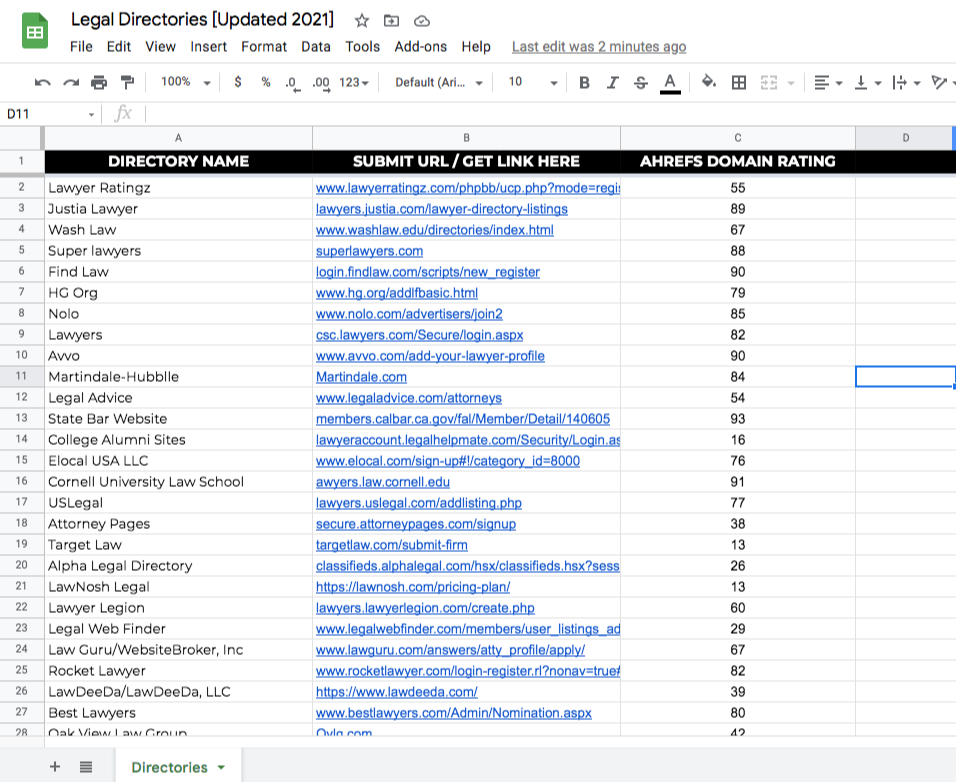
Next is to categorize them based on their type.
There are two types of directories: paid and free directories.
There are paid directories where you need to fill out a form, submit a payment, and wait for the review process of your submission. Other paid directories don't have much waiting time. You get easily approved once you submit your payment.
And free directories where you only need to fill out your basic information (Business Name, Phone Number, Practice Area, links to social profiles, and your website). Then submit. Some free directories also have an approval process.
Know that every directory is different.
Once you have a list of free and paid directories, qualify these directories based on some metrics.
You want to ensure you only get links from directories that can bring value to your law firm website.
So what are those metrics?
First, relevance.
Start with legal-specific directories.
For example, Justia Lawyers only include law firms and legal organizations listings.
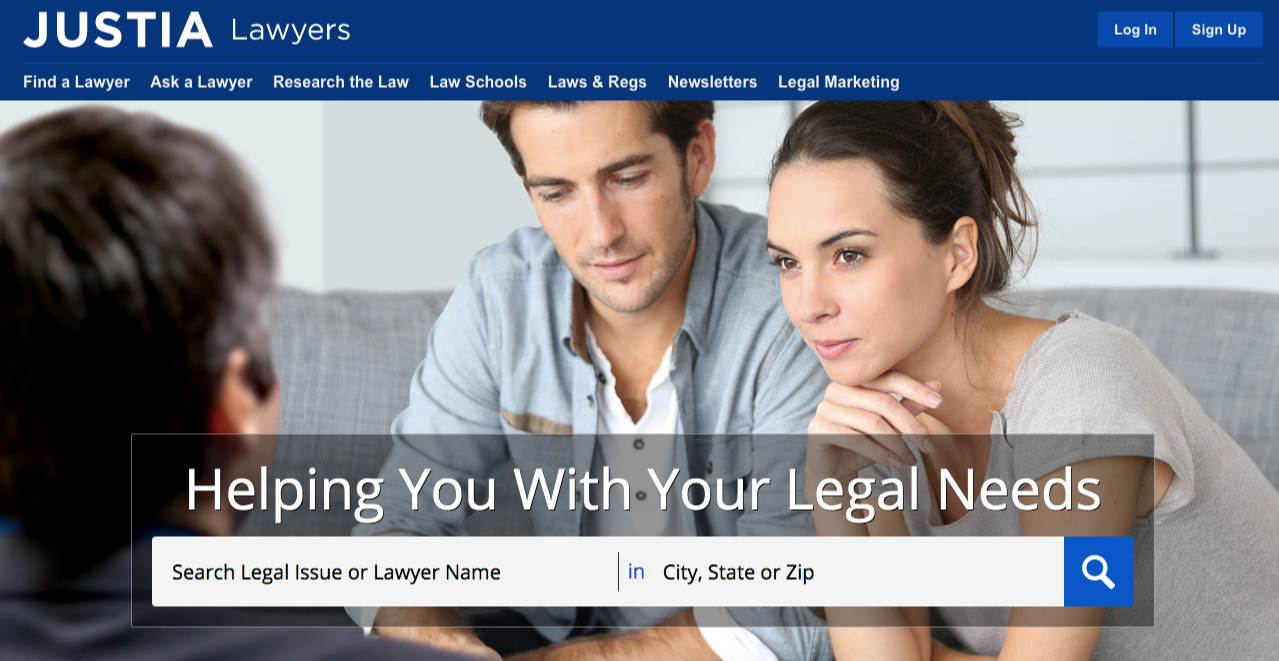
Another qualifier is Moz's Domain Rating.
I recommend getting lawyer niche directories with a minimum DA of 20.
Not too low to get NEW relevant directories. Not too high to include non-authoritative submission sites.
Once you have these details of directories on your list, decide if you'll do the submission yourself or hire a virtual assistant to do all the legwork for you.
How To Find More Lawyer-Specific Directories
If you're looking to find more directories for your law firm website, the best way is to check out your competitors' backlink profiles.
Ahrefs can help you out finding directories where your competitors have links.
Start by entering the domain in Ahrefs' Site Explorer.

Go to the Backlinks section. This will show you all the websites linking to your competitor.
Type in "directory" in the "Include" search to only see directory websites.

There you'll surface a bunch of directories you can submit your website details and get attorney-related links.
You can check out this guide on how to use Ahrefs for link building.
2. Build Local Citations
If you want to rank for localized attorney keywords, such as "personal injury Florida", you need citations.
A local citation is any online mention of a local business's name, address, and phone number (NAP).
Citations help search users discover local businesses. These can impact your local search rankings.
Check out this updated list by Bright Local of the top local citation sites.
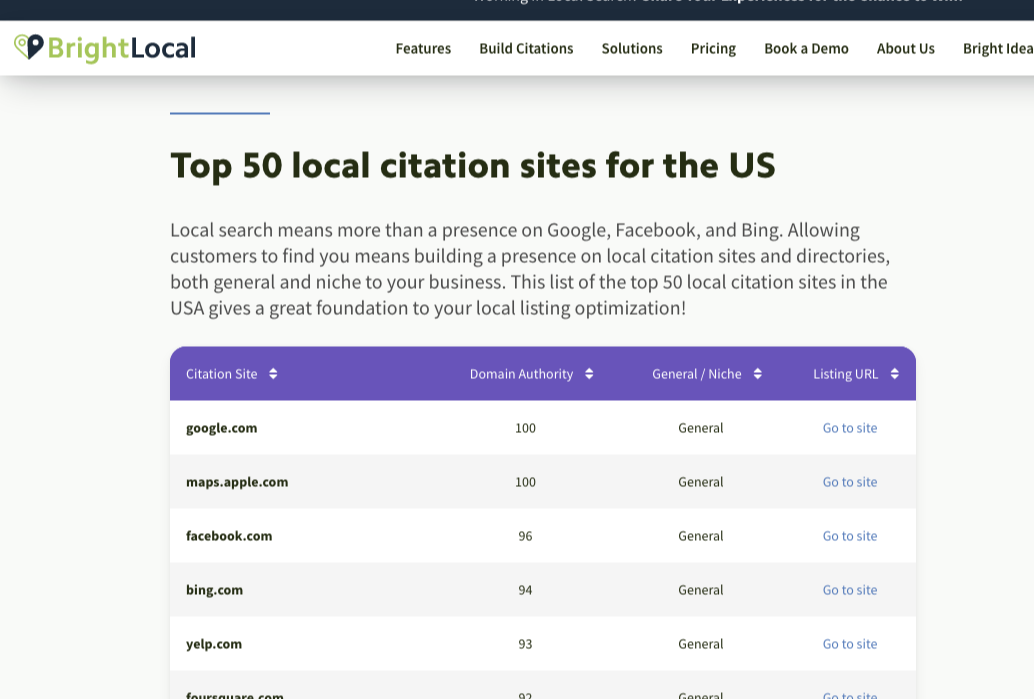
3. Offer Scholarship Programs
Scholarships are one way to get tons of edu backlinks to your website.
The reason?
Financial aid departments of universities have listings of current scholarships on their website. They keep updating those listing pages to help students find the latest scholarship programs they can apply for.
And the best thing is you aid students with their financial needs while, at the same time, getting backlinks to your law firm website from these scholarship pages.
Now here are four steps to do scholarship link building.
Step 1: Create a scholarship page
Know what you want to offer in your scholarship program.
Do you want to target law school students?
The more relevant your scholarship is to your brand, the better impact scholarship links can have on your website.
Create a page that includes all the details your target beneficiaries need to apply for your program. Details include name, award amount, deadline, rules or criteria for application, snd submission, and review process.

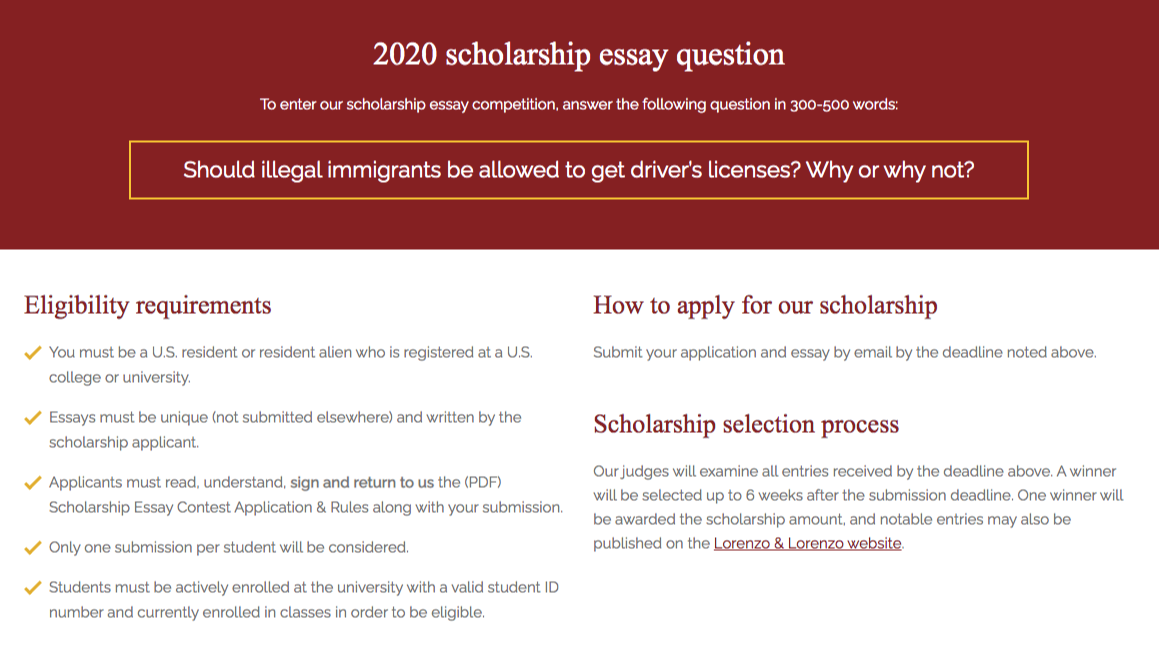
Complete all details of your scholarship program.
That way, your offer is more appealing to people who handle the financial aid department of university websites.
Step 2: Make a list of all target schools for outreach
Once your page is set up, your next step is looking for scholarship listing pages.
Typically, you'll find the financial aid department that provides a list filled with scholarship programs.
How do you find them?
Use search phrases along with Google search operators.
Here's a list of search queries that you can use for prospecting:
- "legal" ~scholarships ~financial aid
- "legal" ~scholarships ~financial aid
- "legal" site.edu ~scholarships ~financial aid
- "legal" site.edu ~scholarships ~financial aid
- "legal" site.edu ~scholarships ~financial aid
- "legal" site.edu ~scholarships ~financial aid
- "legal" site.edu ~scholarships ~financial aid
- "legal" site.edu ~scholarships ~financial aid
- "legal" site.edu ~scholarships ~financial aid
- "legal" site.edu ~scholarships ~financial aid
- "legal" site.edu ~scholarships ~financial aid
- "legal" site.edu ~scholarships ~financial aid
- "legal" site.edu ~scholarships ~financial aid
Look for the contact person who manages the scholarship listing. It could be the person in charge of the financial aid page or the school's webmaster.
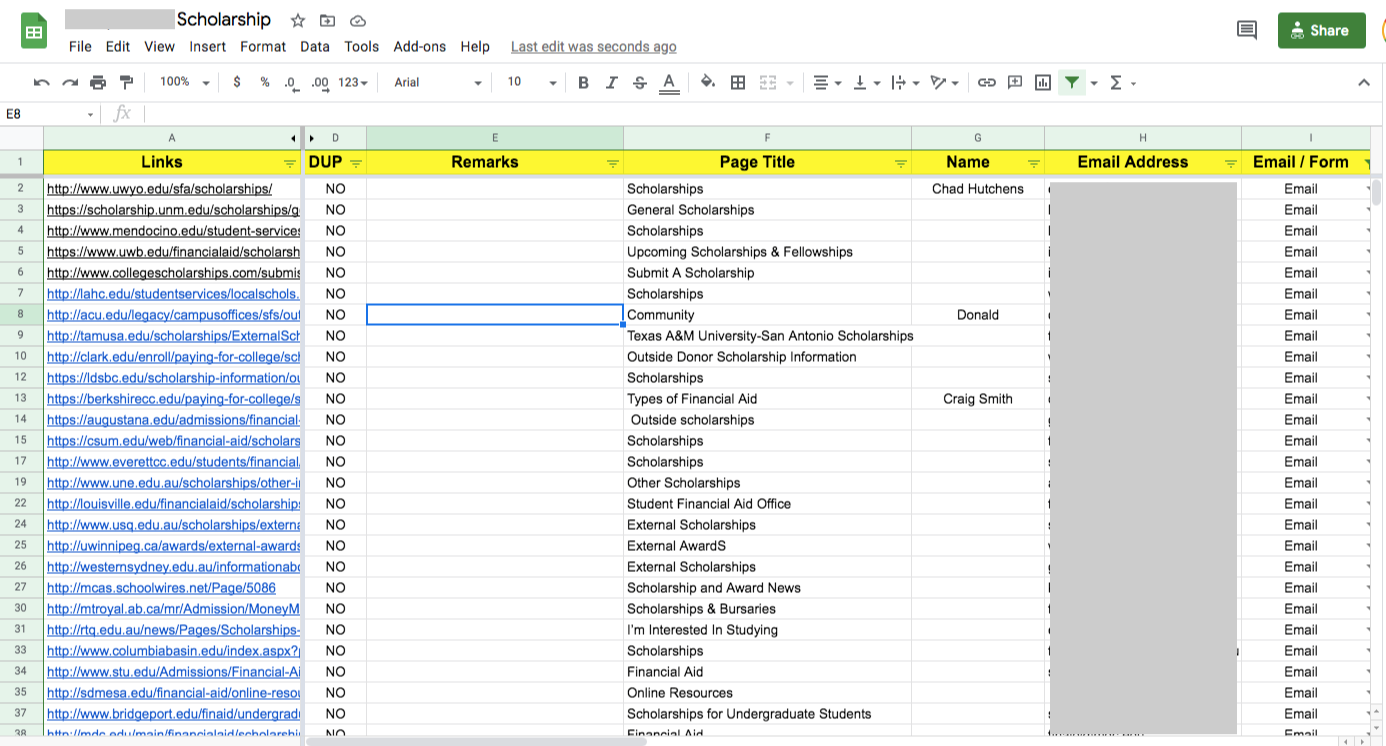
Add the contact person's name, designation, and email address (or contact form) to your list.
How To Find More Scholarship Listing Pages
Another way to populate your list is to find pages that link to your competitors' scholarship page or other relevant law firms that offer scholarship programs.
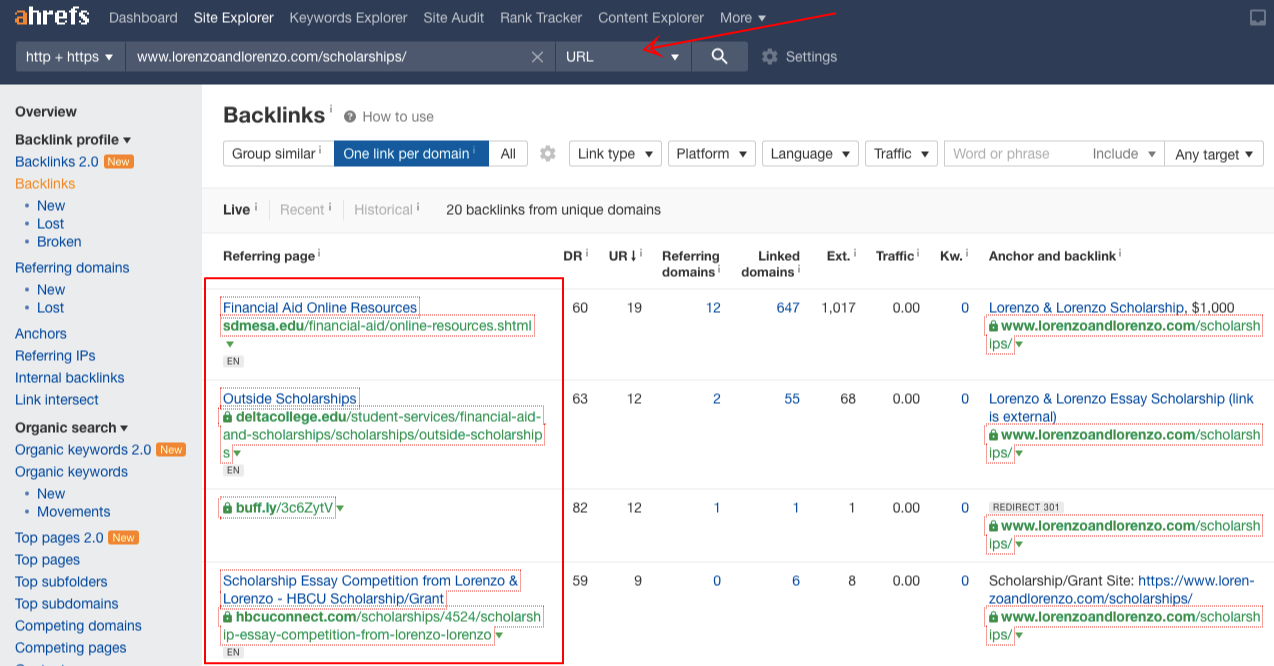
Enter a legal-specific scholarship program in Ahrefs Site Explorer. Go to the Backlinks sections to see all pages linking to the scholarship page.
Add these pages to your list.
Step 3: Reach out to your outreach prospects
Send emails to your prospects. Tell them about your scholarship, where to find it (URL of your page), and how students can apply.
Not all prospects are the same.
Some people will ask for more details about your scholarship program, so be sure, you have complete details when they need them.
Best Lawyer Scholarship Programs (2021 List)
Below is a list of the best scholarship programs in the legal space. Check them out and find inspiration for your scholarship link building strategy.
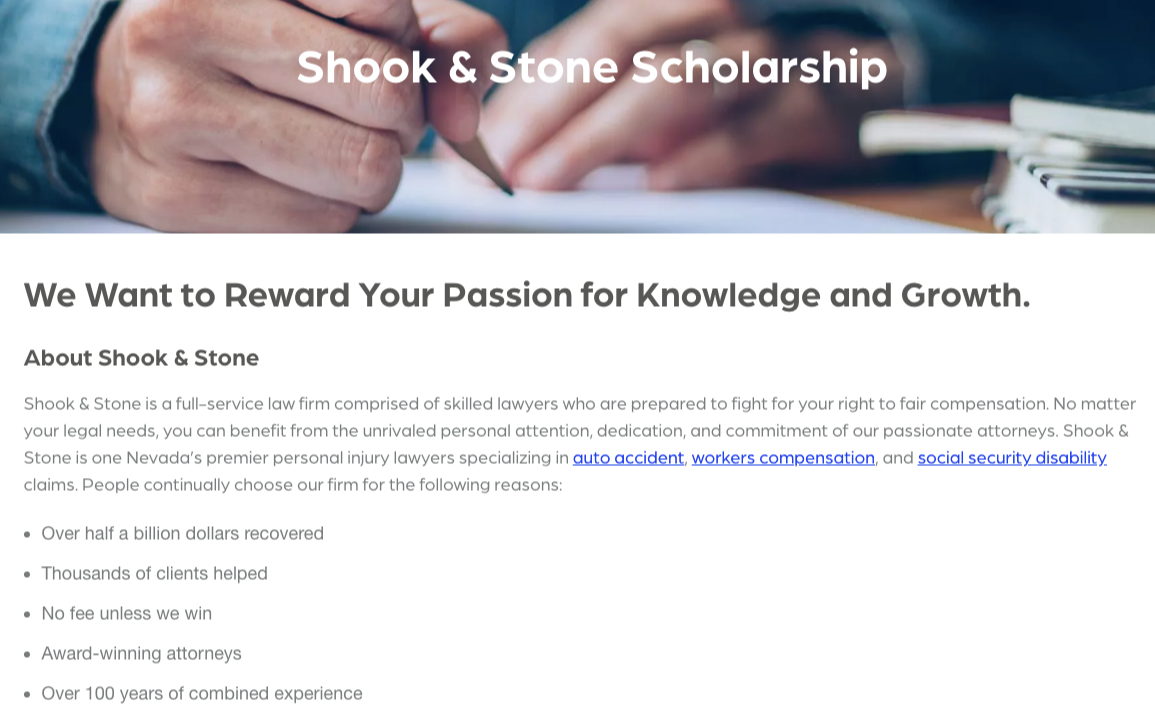
4. Create And Promote Evergreen Content Assets
There's more content published today than ever before.
According to this content study by Backlinko, 94% of online content has zero external links.
So:
How can you create content that stands out in the legal space?
The answer is:
Publish evergreen content assets.
Content that is more comprehensive than other pages related to your topic.
Content that is evergreen to be relevant and beneficial over the long term.
Creating these evergreen content assets requires a content strategy and keyword research.
Doing keyword research effectively and creating content to match topics to serve your audience.
You can do both with topic clustering.
Topic clustering is grouping your content by key topic areas, wherein there is the main page (commonly called a "pillar page") that targets a broader audience and stretches out by having support pages to cover specific topic ideas or key phrases listed on the pillar content.
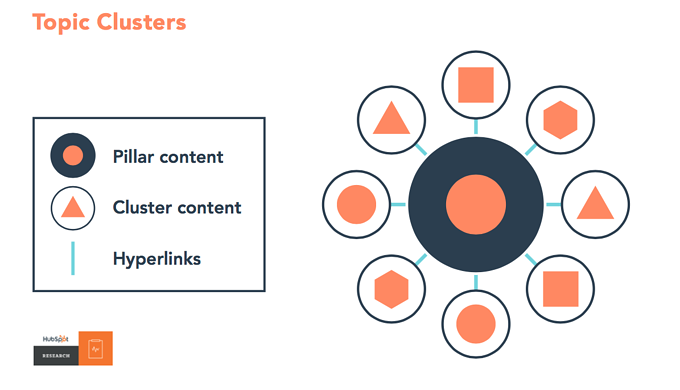 And important is having both pillar and cluster content internally link.
And important is having both pillar and cluster content internally link.
How To Create Evergreen Content Assets
Step 1: Discover Topics, Not Just Keywords
Find topics that you can address with your expertise.
My recommendation is to use Ahrefs to discover legal-related topics.
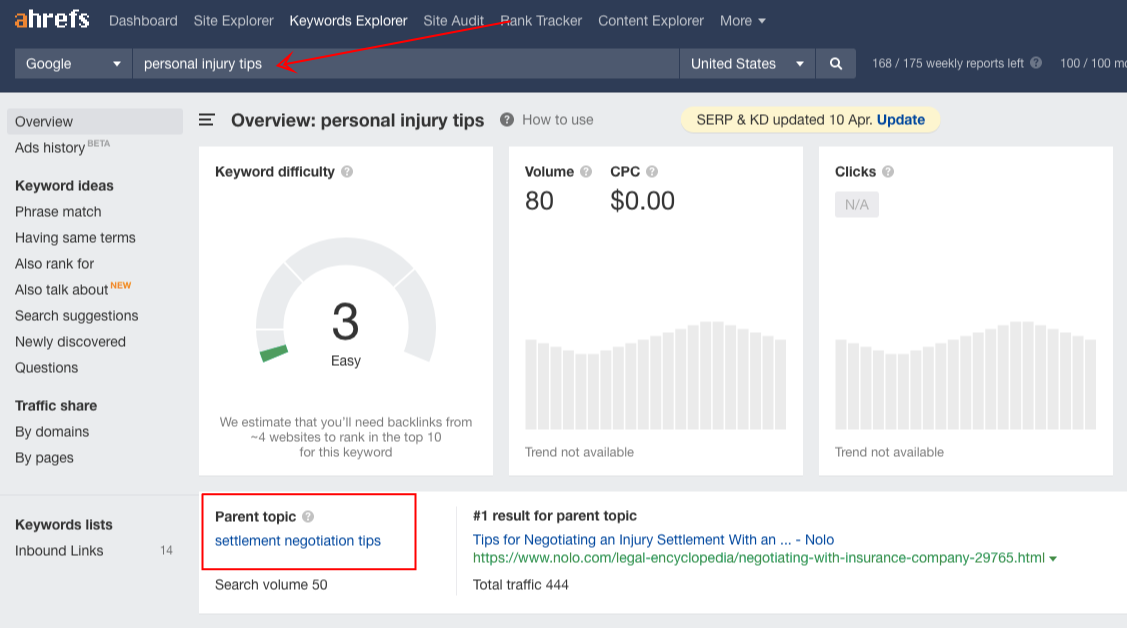
Review each keyword in the results and see which has informational content.
Check through the list and see if there are any parent informational topics.
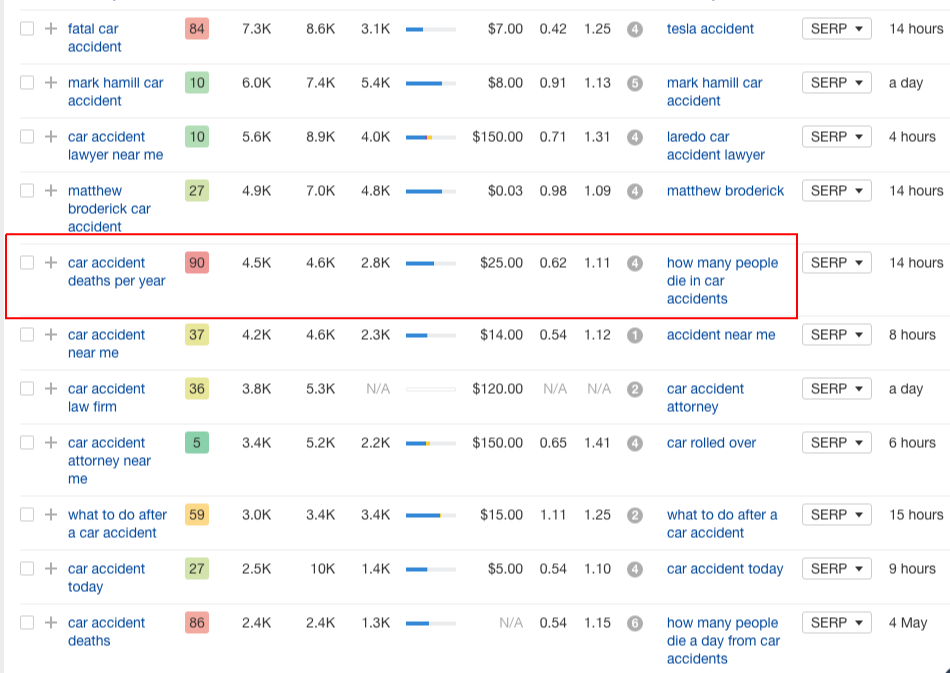
Look deeper to find more relevant topics.
Add filters if you want only to see keywords that fit your context.
For example:
- Set KD (Keyword Difficulty) to Max 40 if you know your law firm website doesn't have much domain authority to compete in the search results.
- Filter by volume. Make it only give you keywords with a search volume of 100 minimum.
- Check Featured Snippet in SERP features, which is optional, only if you want keywords with a featured snippet pack.
You can export results from Ahrefs into CSV to filter them more.
Make sure you list all the keywords with their parent topics (including all criteria you choose to consider - KD, volume, Featured Snippet).
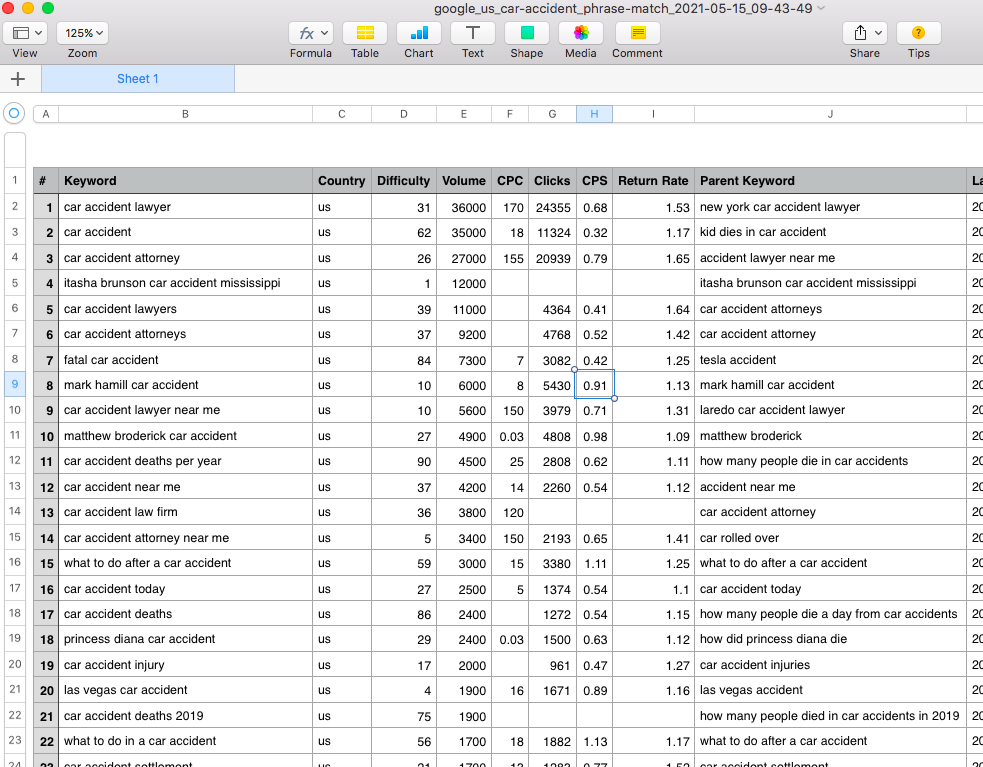
What's another important thing besides finding content topics?
It's the content type.
You want to know what kind of content piece you'll publish on your content.
Step 2: Identify Content Types That are Best For The Topic
How to know what content type suits you best for the topic?
The answer?
Look at the search results.
Because what the search results will reveal is the type of content the search engines see as deserving to rank for that topic.
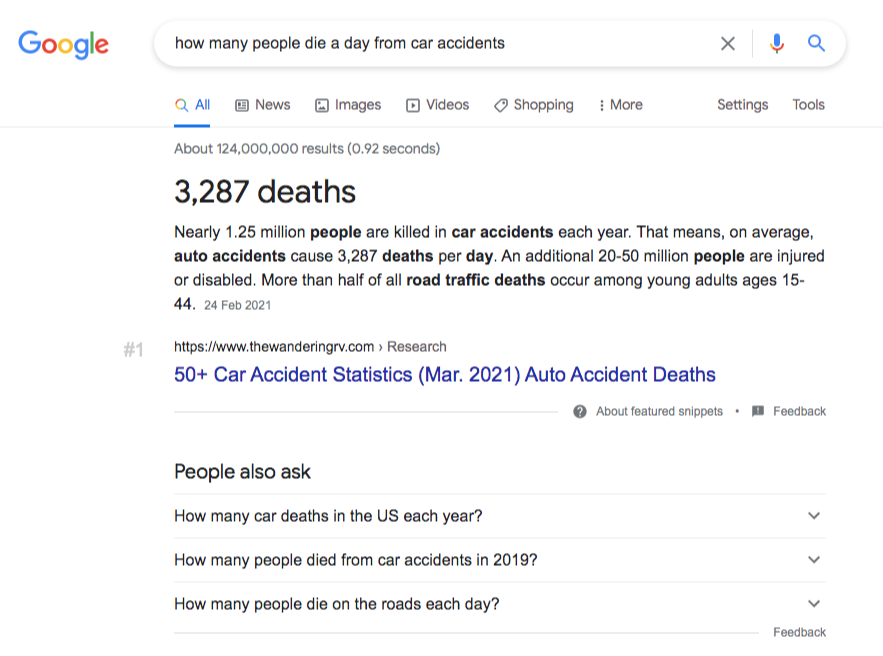
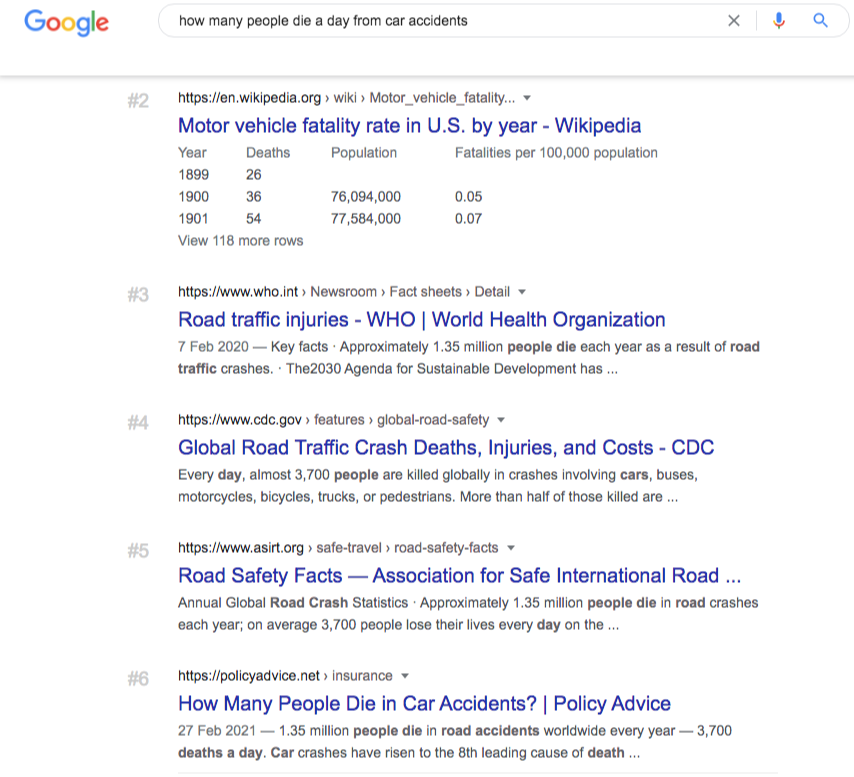
You may surface content types such as statistics ("study"), long-form content ("guides"), listicles ("best X"), or FAQ ("frequently asked questions").
Different topics manifest different content types.
Look through each search result and see the common pattern among ranking pages.
Add a "Content-Type" column to your list.
Step 3: Create Content 10X Than Its Competitors
The biggest step in content marketing is creating the content.
And to make your content 10x:
Make sure you check what's missing from your competitors. Go to each ranking page and review them.
Ask yourself, can I add something that's been missing or hasn't been mentioned from their content?
List them down.
Add internal data.
Case studies, surveys, and other content formats.
Include your own actionable insights in your post. Just make it more comprehensive.
Structure your content in a way that's easy to digest.
Here is a simple guide from Ahrefs to creating "BIG" blog content.
Step 4: Promote Your Content Assets
Everyone creates content, but only a few promote their work.
That's not you, right?
So start to promote your content assets to get more traffic and earn backlinks to your website.
But how will you do that?
Make a list of all pages that have been shared or linked to pages related to your topic.
You can use Ahrefs to find these backlink prospects.
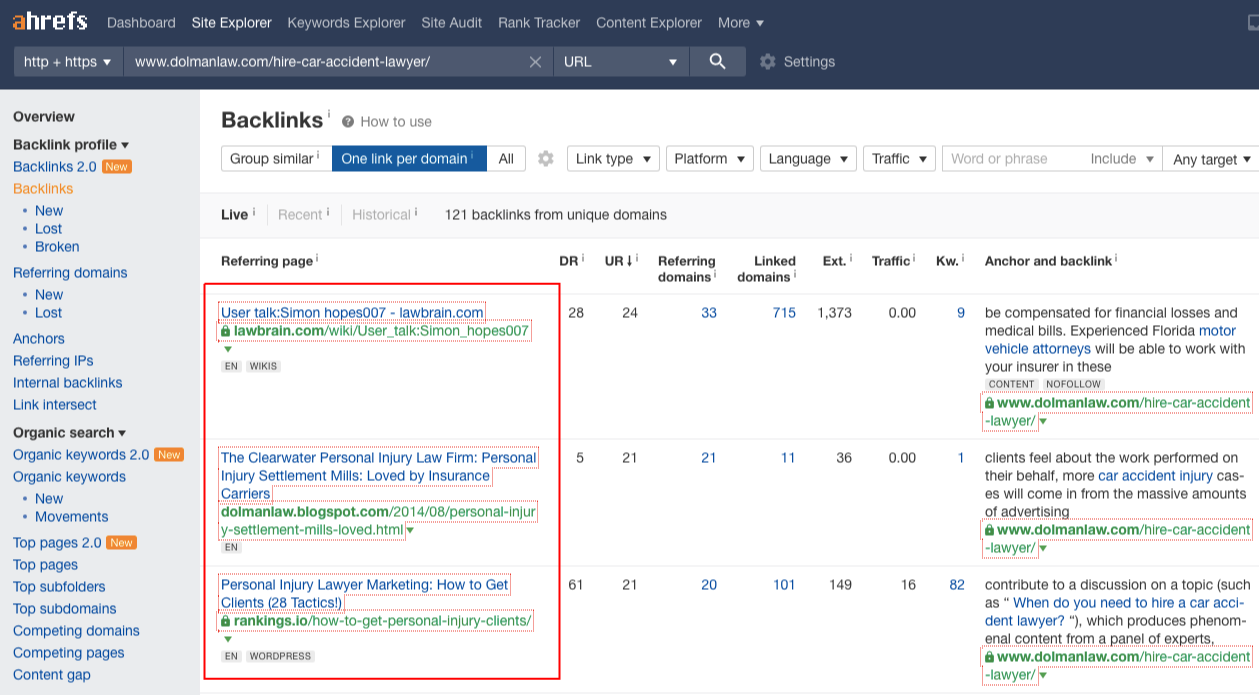
Get their contact details and start reaching out to them.
See more link building strategies that focus on content as a value proposition in email outreach.
5. Leverage Thought Leadership
Legal expertise can help you build more natural links to your law firm site.
As they say:
Educating is the best way to sell.
In doing law firm SEO services, educating is the best way to build links.
Because people want answers to their pressing needs and questions.
And they will give you links if they find value when you share your expertise.
If you're a thought leader, leverage any of these brand assets.
Publishing Books
If you or your attorney-client have published books on Amazon or any book publishing web places, consider how to use these books to get links to the legal site.
You may add direct links to your lawyer's website in author profiles.
Or have a page on your site dedicated to that book.
You may include the URL of this book page in your digital PR campaign to get traction and potential natural links from the websites of publishers and journalists.
Podcasts
Podcasting is a great way to build your brand and expose your thought leadership to a large audience of linkers (publishers and bloggers) who're likely to link to your website.
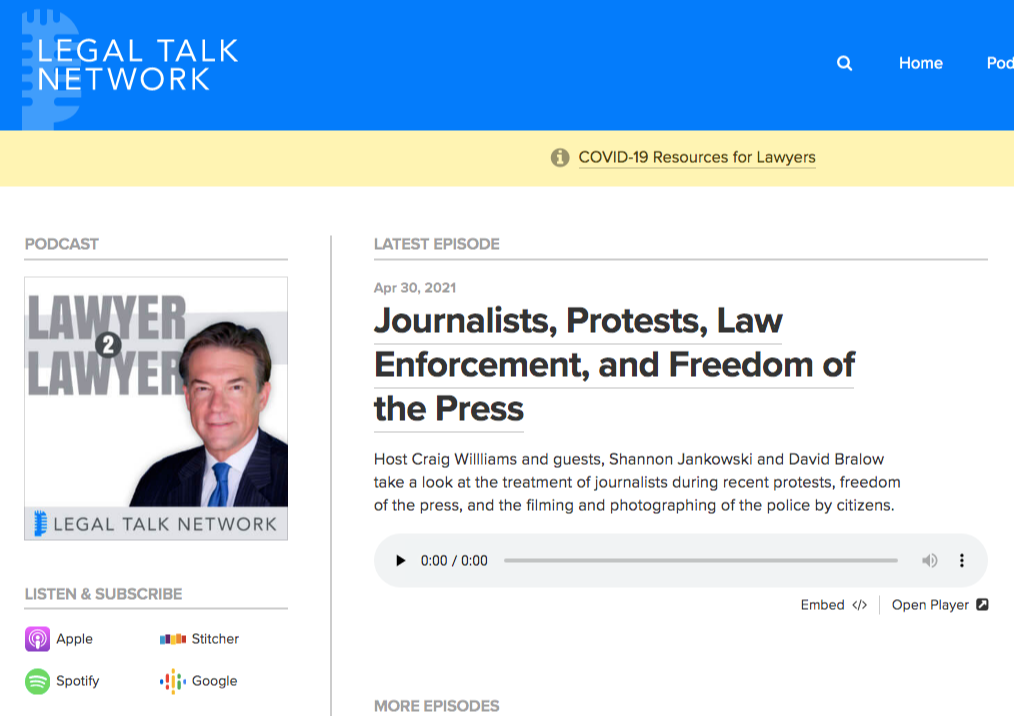
There are two ways to get backlinks from podcasting:
Start a podcast.
Get interviewed on podcasts.
You get links from podcast hosting companies through your profile pages when you start a podcast.
When you get interviewed on podcasts, you get links from podcast blog transcriptions ("show notes" or "links section").
Provide Answers To Questions
As a legal practitioner, you can help anyone interested in legal practice by answering their questions online.
Either you comment on other people's legal blogs (not your competitors) or by becoming part of a crowdsourcing post sharing a tip or two when asked for insight on legal topics.
When you comment on blogs, you don't simply drop by and spam them with comment links.
You give value to their audience by sharing your own insights or feedback points to their articles.
You want your comment to be interesting so that people are enticed to click on the link pointing to your website. This way, you get referred traffic from the website.
Discover Unlinked Brand Mentions
If you're showcasing thought leadership online, publishers and content creators might recognize you.
Search the entire web to see if you, your law firm, or any of your online assets have been mentioned elsewhere.
Some brand mentions may not have links to your legal website — these are missed link opportunities.
Take advantage of that by reaching out to people and asking them to credit mentions with links.
You can use Ahrefs to create alerts whenever someone mentions you. This way, you can quickly email to ask for a backlink (in case the person didn't give you a link).
6. Use PR Outreach
How would you feel if journalists covered your stories?
What about being interviewed as a thought leader (or expert) in the legal space?
These are things that are possible with PR outreach.
Online PR is doable. It is something SMEs, including law firms, can take advantage of, not just Enterprise brands.
One effective tool to help you with online PR is Help a Reporter Out (HARO).
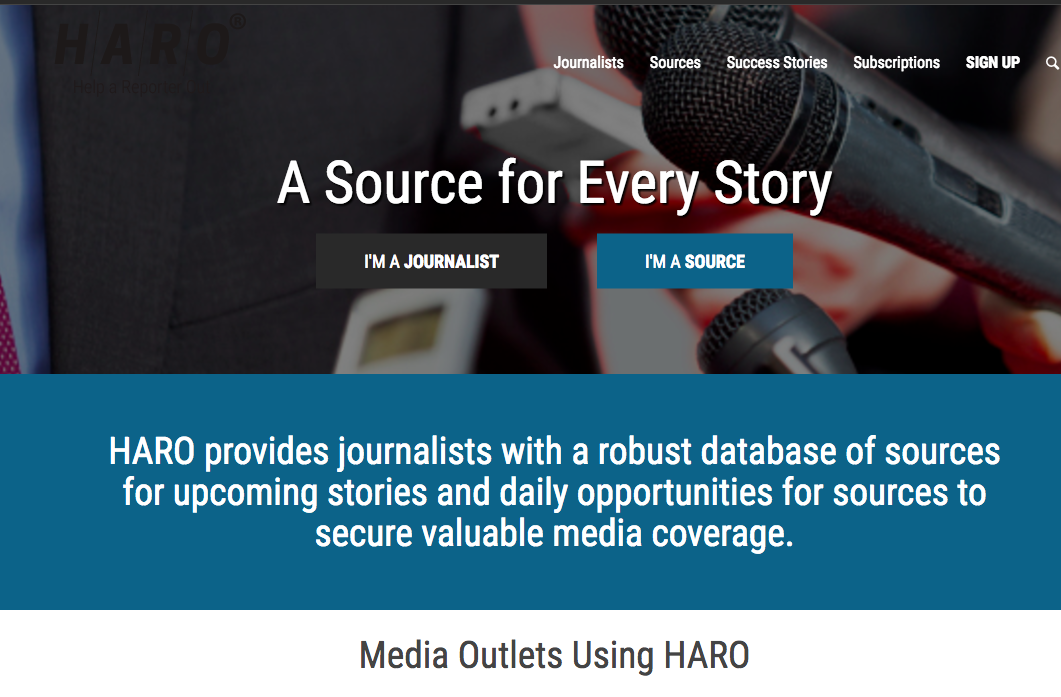
It's a simple tool that allows you to connect to journalists.
The good thing with HARO?
Because the journalists request quotes, you can get responses instead of you chasing them out on Linkedin or other social platforms.
For example, you can jump into HARO and share your insights if they require quotes in an article about new legislation or the implications of a court case currently in local news.
HARO curates requests for stories, tips, information, or quotes from journalists and puts them in one place.
This may feel like a lot of work, but if you have a process to follow and tools, you can get exposure (and links) from journalists and top-tier publishers in your space.
Here are useful resources to help you get started with HARO link building and digital PR:
- How To Write A Pitch For Digital PR In 2021: A Complete Guide
- What We Learned About Digital PR Success
- Should You Invest Big Bucks In Digital PR?
7. Maximize Sponsorship Opportunities
You can buy links ethically. How?
Not directly paying someone to give you a backlink to your legal firm site.
But by using money to support a cause of your target linkers.
Have you seen someone donate to a charity or sponsor an organization, event, or foundation?
That's what you do online.
Most non-profits and charitable organizations have their websites and dedicated pages to list logos of companies and organizations who support their cause.
For example, if a local non-profit organization has an upcoming event page, it has a section on its event page or somewhere on its website, a list of all the event sponsors.
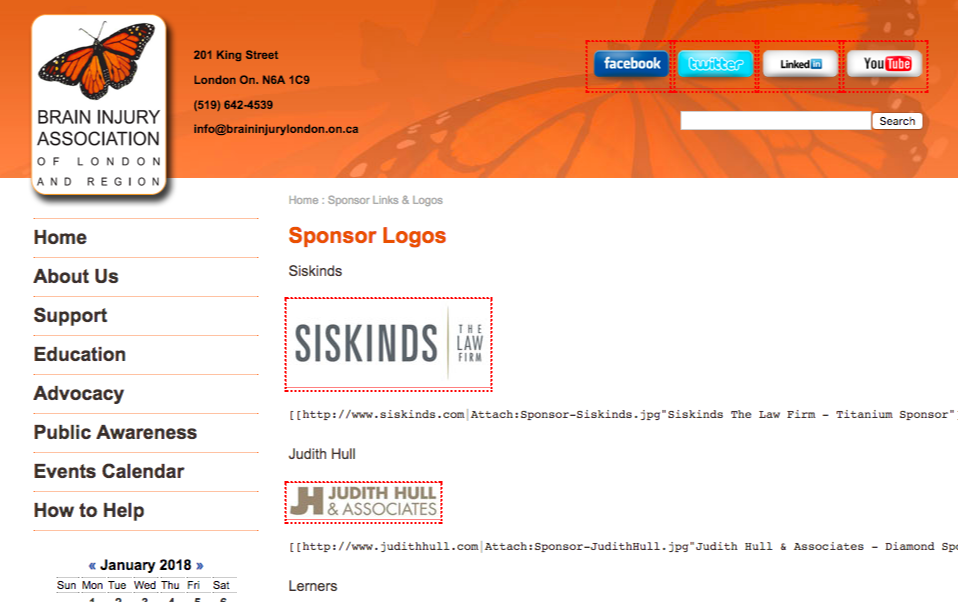
That section has a list of links to company websites.
Besides pursuing non-profit organizations, you can leverage online community websites to find sponsorships on events from local businesses.
One example is Meetup.
With Meetup, you get to see events you'll sponsor and, in return, have the exposure (and links).
You connect to the organizer and ask about their sponsorship details.
Then you decide if it's the right fit for you.
8. Publish Legal-Specific Roundups
What if you can create valuable content with lesser effort in producing it?
That's possible with:
Legal roundups.
You ask thought leaders, practitioners, or experts a question on a particular topic.
Then you curate all of the inputs into one big blog post.
What's more interesting in having 33+ legal experts talking about a legal topic?
That's what The Dolman Law Group did with their "Attorneys Answer: When do you need to hire a car accident lawyer?" roundup post.
They asked 33+ experienced lawyers in auto accident claims in Florida to answer a question most people would ask with regard to a car accident.
As of this writing, this law firm's website earned 128+ backlinks from other relevant publishers, helping their website to improve its site's search traffic.
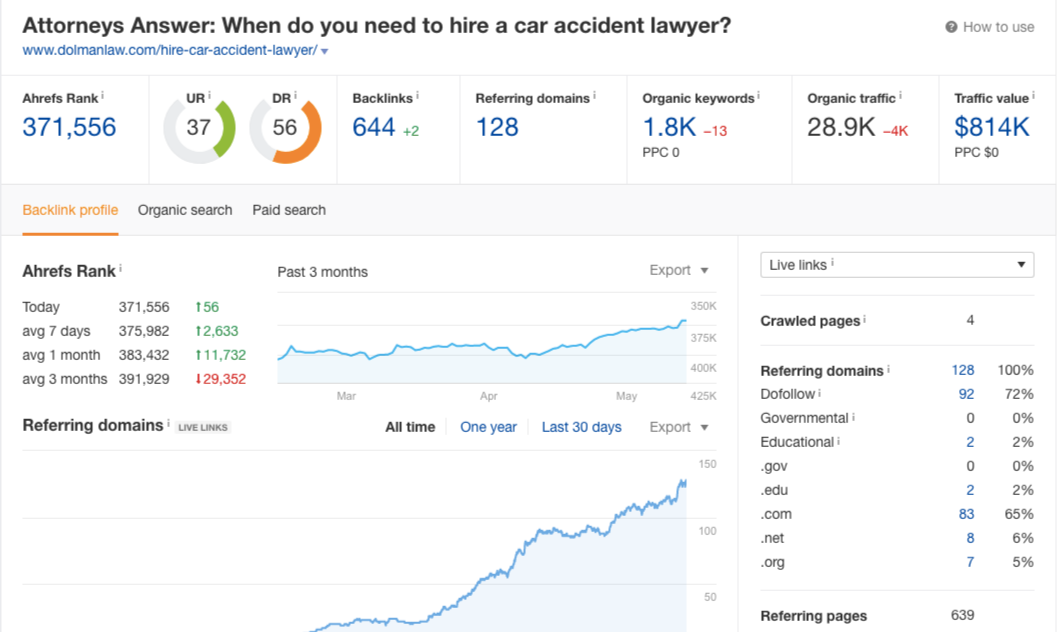
You can model what they did.
See what content topics people were looking to get insights from.
Go through each partner's legal websites and legal experts in your field to ask that question.
Compile their insights and make it a blog post.
9. Apply For Legal Awards & Associations
Any brand assets that display thought leadership and excellence in the legal space are powerful in helping you gain more backlinks to your legal website.
Do you have legal awards and associations you're associated with?
Some legal awards include:
- SuperLawyers
- National Trial Lawyers Top 100
- Million Dollar Advocates Forum
- American Association for Justice
If you're an SEO agency, ask your attorney-client if they want to be nominated in an upcoming legal award in your niche.
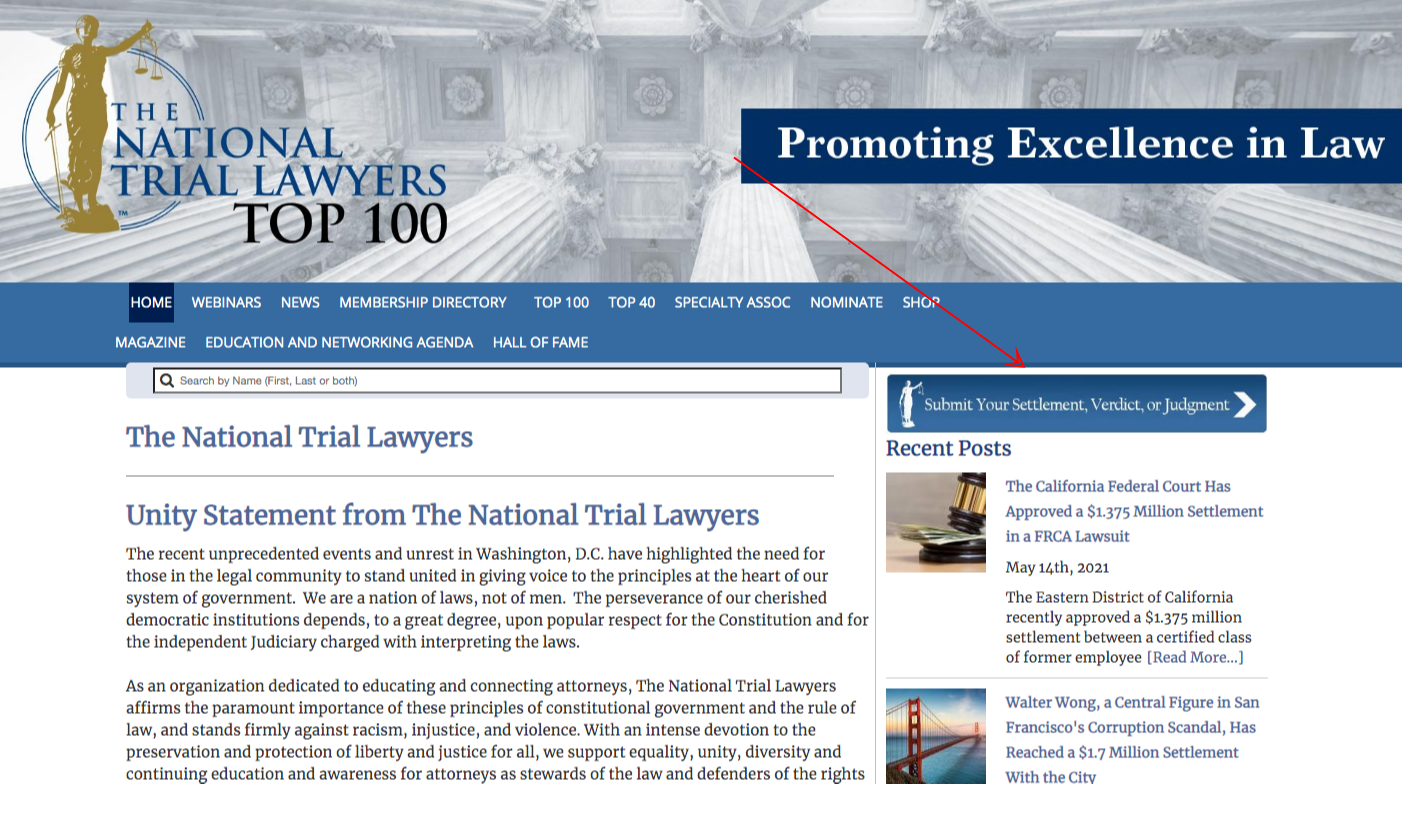
When you can do so, submit their information and other details needed by the awarding body.
Typically, award pages offer links to the websites of awardees. This is your good chance to get a backlink using this attorney link building strategy.
10. Invest In Relationship Building
One of the best types of links is links built on relationships.
Why?
Because you don't just get one link from the website but recurring links given, you continuously provide value to the person (linker).
Ask Your Peers For Links
There's never an easier way to get backlinks than to ask your friends.
Do any friends or partners in your networks have a website?
No, you don't reach out to them and say, "Give me links!".
Even if they are your friends, you still want to know what value you will offer them.
One value offer is content exchange.
This means you lend your expertise to write on a specific issue your friend's target audience will benefit from.
For example, you could write an article that speaks of a unique perspective on an issue that one of his clients might have. If you're a tax attorney and your friend is in the personal injury space, you could write an article on how personal injury settlements are taxed in her state.
You find what topics resonate with their audience — that also resonates with your brand or niche.
Give Testimonials
Testimonial link building is an easy way to get free backlinks to your law firm's website.
How's that possible?
Businesses need social proof to help their visitors convert into customers.
And testimonial is one social proof that tells their audience how good their product or service is.
Typically, business websites have their testimonials section on their homepage.
Or they have a dedicated page just for that.
Can you remember any business that provided services to you?
For example, if you hire home-based services to help you with cleaning or house chores, you can email them and provide a testimonial in exchange for a link to your legal firm website.
Check their websites and see if they have testimonials.
Reach out to them and send a testimonial quote about their service.
11. Give Value Through Reddit & Forum Link Building
Forums are not dead.
Your audience wants to get insights from other like-minded people.
The reason is:
They connect more, share their experiences openly, and are more receptive to answers and questions when they're part of a community.
Reddit is a very active social forum.
Law-related topics such as this one:
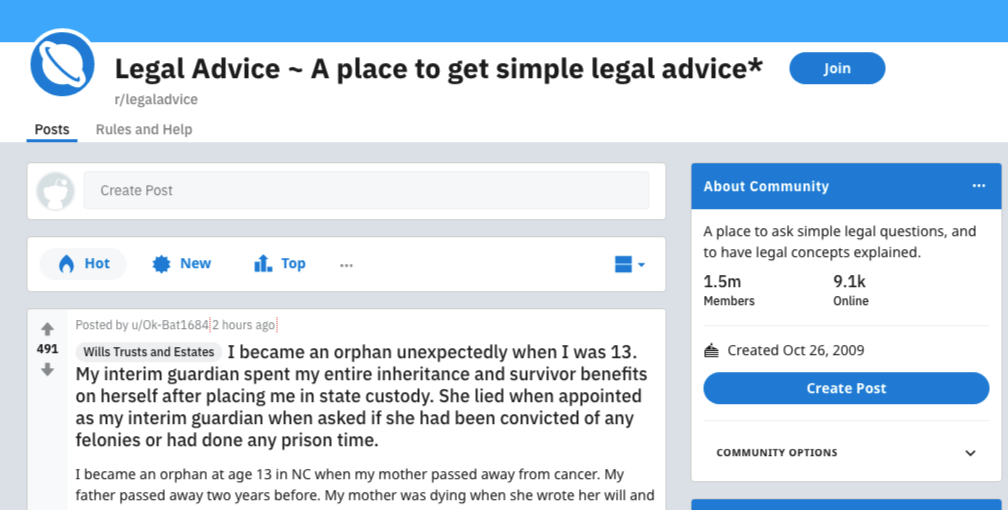
Or topics your audience engages in:
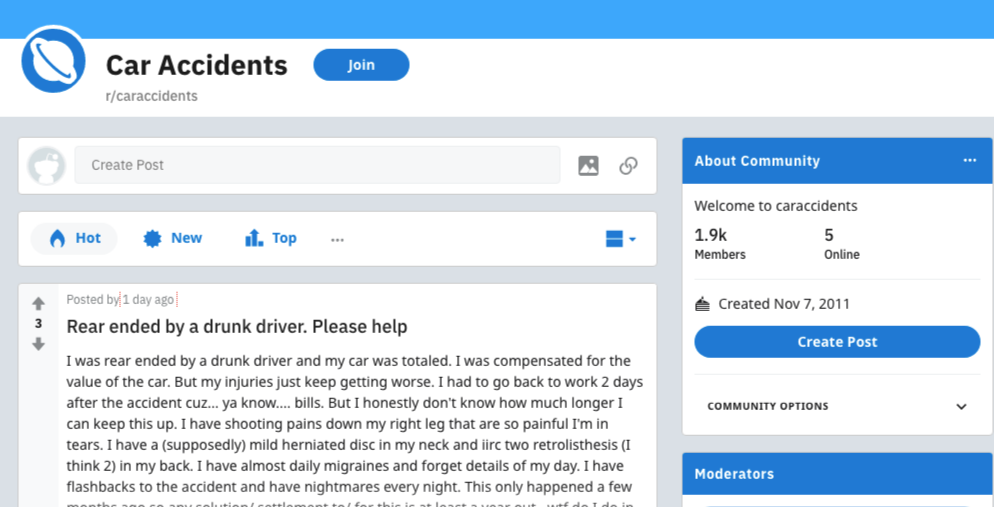
Create your Reddit profile.
Display your thought leadership by interacting with other members in subreddits.
You don't post links right away.
Participate in other discussions by responding to legal and niche-specific questions (e.g. car accidents).
Be mindful of the subreddit posting rules and regulations.
Some communities have strict rules for posting too many self-promotional links.
When it is only relevant to your audience, post links to your helpful articles.
12. Do Guest Posting
Guest posting is not dead.
Any publishers accept contributions from other authors (at some point).
Why?
Because it's free.
And if the quality of content reaches the standards of the guest blog.
How come they won't accept it?
Guest blogging offers more benefits than just links.
Branding. Exposure. Referral Traffic. Assisted conversions.
All these are long-term benefits useful for your law firm.
I've covered the exact step-by-step process of how to do guest blogging.
If you're hesitant about the effectiveness of guest blogging, check out your competitors and how they are getting backlinks today.
Some of the links they got at some point came from guest posts they contributed to other blogs.
Key Takeaways
I hope you enjoyed my attorney link building guide.
Now I’d like to hear what you have to say:
Which technique from this guide are you going to try first?
Do you want to submit your law firm website to legal directories?
Or maybe you want to leverage thought leadership to get more links.
Let me know by leaving a comment below right now.
Link Building for Lawyers Frequently Asked Questions
What is an SEO at a law firm?
An SEO at a law firm is responsible for optimizing the website by improving its search engine rankings to attract more visitors. They use techniques like keyword research, on-page optimization, and link building to increase the visibility of the law firm's website on search engine results pages (SERPs). With their expertise, they help drive valuable organic traffic to the site, ultimately leading to potential leads and clients for the law firm.
What is a good example of backlinks?
A popular example of backlinks is when a website includes a link to another website within its content. This link acts as a recommendation, indicating that the linked website is trustworthy and valuable to search engines. For instance, if a blog post mentions a helpful article and includes a link, it creates a backlink for that article. Backlinks play a crucial role in improving a site's search engine rankings.
Which backlinks should be avoided?
When it comes to backlinks, it's important to avoid certain types to maintain your site's credibility. Avoid paid links, as search engines prioritize organic and earned ones. Similarly, avoid including irrelevant press releases or low-quality directories and forum links. Also, be cautious of domains with a high spam score. By steering clear of these backlink types, you can boost your site's standing and visibility in search results.
Are backlinks legal?
Backlinks are legal and important for SEO, but buying them directly from a website without proper disclosure violates Google's guidelines. Avoid this practice and instead focus on building high-quality backlinks through organic methods like creating valuable content and building relationships with authoritative websites.
How To Do A Complete Backlink Audit (5 Easy Steps)
After conducting hundreds of backlink audit campaigns for our clients, we teach you the entire process to do it.
In this guide, you'll discover:
- What is a backlink audit?
- Why backlink audit is important?
- 5 easy steps to do a backlink audit (in less than 30 minutes)
So finish this guide if you want to know if your website is in good shape through a simple backlink audit.
What is a backlink audit?
A backlink audit is the process of assessing all the links pointing to your website. It involves identifying both good and bad links and devising a strategy to address them. You can download your list of links from Google Webmaster Tools and manually review each backlink. It's crucial for maintaining the health and credibility of your website.
In this activity, you want to ensure zero unnatural and toxic backlinks could harm your website, which could hinder future SEO initiatives or trigger a Google manual or algorithmic penalty.
Why do a backlink audit?
Performing a backlink audit is essential to ensure the health of your website. You can identify and remove any harmful or spammy backlinks by conducting a thorough analysis. This not only protects your site from potential penalties but also enhances your SEO efforts, allowing for better organic rankings and traffic.
Before you perform a backlink audit, you need to know why you should be doing it.
Here are three purposes of a backlink audit:
- Identify spammy inbound links to your website.
- Do more of what you did well in previous link building efforts.
- Get insights into your next link building plan.
Identify spammy inbound links.
You could've taken a new client, and you're unaware that their previous agency built bad links to your client's site.
Or your website has been hit by a negative SEO attack. Your competitors have done nasty things by building toxic links to your website instead of focusing on improving their backlink profile.
Either way, you want to know if you've got any spammy inbound links. You want to remove them as soon as possible as a course of action. Otherwise, you might receive a Google manual penalty, which could hurt your website's organic traffic (and conversions)
Do more of what you did well in previous link building efforts.
A backlink audit isn't just knowing the negative stuff. It also gives you the time to assess what works well and do more of them.
If you've been building and earning good backlinks, it is wise to replicate the types of links, link building strategies, and linkable content formats to improve your site's backlink profile even more.
Get insights into your next link building plan.
Backlink audit helps you assess your website's link profile against the competition.
With that, you can leverage a more cohesive action-oriented plan to outpace your competitor's backlinks and outrank their performance in search results.
Insights gathered from backlink audits help you come up with a solid future link building plan.
Backlink Audit Tools
You need tools to help you gather valuable information about your backlinks.
In performing a backlink audit, you could use any of the following link building tools (or even combine them if you have spreadsheet skills):
- Moz
- Majestic
- Search Console
- Ahrefs
- Screaming Frog
- SEMRush
- Screaming Frog
- Link Assistant
My recommended tools for backlink audits are Ahrefs, Moz, and Majestic.
It is best to invest in at least one of the mentioned link intelligence tools, as you'll not only be using them for backlink audit but for other essential link building tasks (e.g. competitor backlink research and link search).
In this guide, I'll be using Ahrefs and Majestic. So let's go about how to do a complete backlink audit in 30 minutes or less.
How To Do A Backlink Audit
Here is how to do a backlink audit in five steps:
- Get an overview of your backlink profile and of your competitors.
- Find low-quality backlinks to your website.
- Discover opportunities and methods by reviewing your backlink profile.
- Check for any broken backlinks you can fix.
- Strategize for your next link building plan.
Step 1: Get An Overview Of Your Backlink Profile and Of Your Competitors
In a backlink audit, you start from top to bottom.
This means you look from a high-level view of your backlink profile and then lean into details.
Begin by entering your domain into Ahrefs' Site Explorer to see overview details of your backlinks.
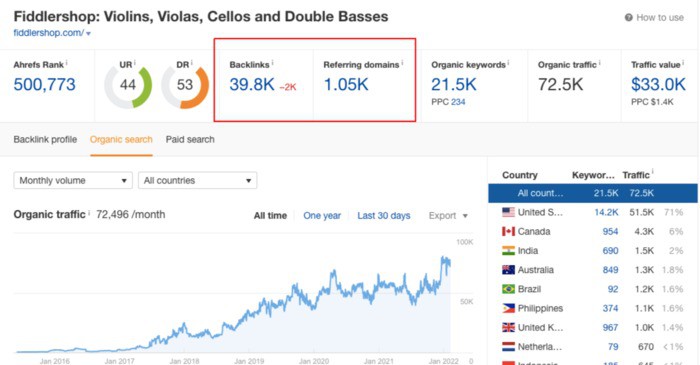
As of this writing, our example website has 39.8K total backlinks and 1.05K referring domains.
The number of backlinks and referring domains gives you a quantifiable metric for the current success of your link building campaign.
The higher your number with these numbers, the higher the domain rating you'll get for your website. More backlinks from high authority sites increase your own site's domain rating.
Sidenote: If you find an imbalance number between the two, say 1M backlinks while having only 5K+ referring domains, take a closer look at the website, as this might indicate that the site did shady link building strategies. More on this later.
Next thing to do:
Compute the average link gap between your website and your competitors.
You have to compute the average backlink gap to keep up with your competitors (or get ahead of them).
What is backlink gap?
Backlink gap is basically the estimated difference of links and referring domains between your competitors and your website.
It's not an absolute number, though, but this gives you a rough estimate of how many links you should be pursuing to get ahead of the competition.
One tool you can use to compute for this initially is Ahrefs' Domain Comparison feature.
When you enter your competitors' domains, It shows you an overview of backlink data across multiple domains at a glance.
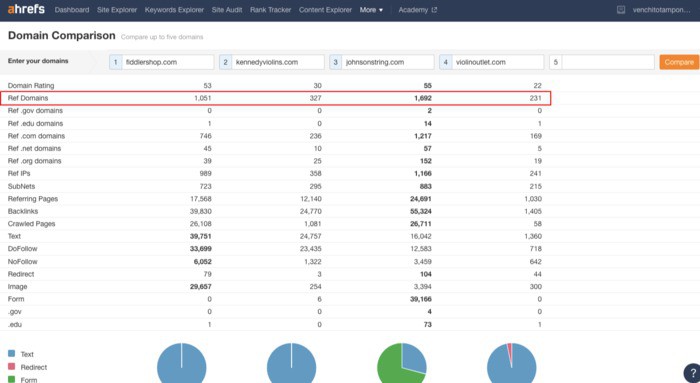
You can see directly here how many backlinks and referring domains your competitors have compared to yours.
The backlink gap isn't just about the quantity difference.
So to calculate the backlink gap, you should focus on high-quality backlinks. The easiest way to get the links' quality is by evaluating each referring domain's DR. You can do it via Ahrefs' Referring Domains report.
Once you have a list of websites and their DR, you need to export the results and see how many links are high-quality (DR > 70), medium quality (DR ≥ 30 ), and low-quality websites (DR < 30).
Sidenote: DR isn't the only metric to assess link quality. Other tools offer similar metrics, such as Moz' Domain Rating and Majestic Trustflow. But for the purposes of using Ahrefs, we use DR as our qualitative metric.
Another initiative to get a top-level view of the competition is to:
Assess your link velocity rate in comparison to your competitors.
The link velocity rate is the speed at which backlinks to your website are added over a specific period of time.
You can be so fast at a given time, which might dictate a potential negative SEO attack, or so slow that your competitors are outcompeting you regarding links.
To check link velocity, you can see the website's referring domains graph on Ahrefs' Site Explorer overview.
Sidenote: Check if there is a big burst or big drop on referring domains graph. A big burst might indicate a potential negative SEO attack, while a big drop might signal loss of links to specific pages.
Speaking of potential harm to your website, your next activity should be to:
Look for potential spam and keyword-rich anchor text in your profile.
Harmful links are easy to detect by looking at how they link to you — anchor text.
One is checking for any dodgy anchor texts and keyword-rich anchor texts.
Ahrefs provides an anchor text section of all backlinks in your profile.
A good anchor text profile must compose of branded anchor texts, as this is a natural way for other publishers to link to their external sources.
Check if there are any dodgy anchor texts:
Or high-density keyword-rich anchor texts:
Sidenote: Backlinks with keyword-rich anchor texts aren't necessarily bad. In fact, it's common to have this type of anchor text. However, if you see that the high density of your anchor texts (let's say 70 to 90%) are all keyword-rich anchor texts, consider it for a backlink audit execution.
Covered this earlier, but it's good to separate this one:
Check for possible negative SEO attacks.
Are there any big spikes or big dips in referring domains graph?
Big spikes might indicate negative SEO to your website. Other webmasters and SEOs may be trying to pull your site's organic traffic by building toxic backlinks to your pages.
What will you do then?
Ignore or disavow.
Why and how?
Read our next step. I'll get into this in a little more detail.
Step 2: Find Low-Quality Backlinks To Your Website.
This is one of the important steps in a backlink audit.
The reason you want to find low quality backlinks is to remove them (at all costs if you can).
Toxic, irrelevant backlinks could hinder your SEO growth in the future if not taken into consideration.
So how do you find low-quality backlinks?
First, know the difference between good backlinks and bad backlinks.
You can't find them if you don't know their nature and if they are considered as bad.
Good Backlinks VS Bad Backlinks
What is a good backlink?
A good backlink is editorially given.
Editorially given links are natural backlinks. These are links gained without any manipulation or even some kind of manual outreach.
You create value from the content or any other web assets, and that's why they link to you.
A good backlink is from a reliable website.
A reliable website is a website that has an intended audience. It speaks to a target market (e.g. tech-savvy people).
You'll know if a website is good when the website has a real audience (readers). If it's a blog, you can check the website's social engagement and its comment section. There you'll know that it has a community of readers.
A reliable website has good-quality content. The information isn't generated by any AI copywriting tools or spun content by getting original content and running it through a word spinner content to make it look original.
You know that the content is high-quality when you can read information from beginning to end and still understand it.
A good backlink is from an authoritative website.
Authority is relative. But it can easily be determined by a quantifiable metric such as Ahrefs' Domain Rating.
An authoritative website must have a Domain Rating (or Moz' Domain Authority) of 25 and above.
Sidenote: Some domains may have low DR given that they don't have many links yet pointing to the website. However, these low-DR websites have real authors and readers and are good sources of backlinks.
A good backlink is do-follow.
Dofollow backlinks improve link equity to destination pages, which is great for ranking websites.
While you can naturally get no-follow backlinks, you must aim for do follow backlinks, as it passes more link juice to your website.
Sidenote: Do not discount no-follow backlinks, as it makes your backlink profile natural. But if you want to maximize your outreach efforts, pursue link opportunities that are do-follow because they pass link juice to your website.
Now, it's time to know what a bad backlink is.
It's the opposite characteristics of a good backlink.
What is a bad backlink?
A bad backlink is from a spammy source.
They don't come from reliable websites.
Bad backlinks are from websites of low-quality Private Blog Network, content farms, and generic low-quality directories.
Bad backlink is from a website with rich exact match anchor texts.
A high density of keyword-rich anchor texts can harm your website. Unnatural anchor texts signal your website to be manipulating each and every manual outreach effort.
Bad backlink is from elicits websites.
Elicit websites are porn, gambling, hate, adult, and unsafe.
Bad backlink is related to spammy content.
Spammy content doesn't offer much value to its readers. Whether it is spun or AI-generated or it has grammatical errors. In other words, hard to consume for a general audience.
Bad backlink is a no-follow link.
No-follow backlinks don't pass any link juice to your website.
Now, you know exactly the difference between a good backlink and a bad backlink.
Let's get right to how you can find spammy backlinks.
How to Find Low Quality Backlinks?
1. Enter your domain in Majestic to get backlink data.
(I use Majestic this time as it gives me a more accurate spam score for backlinks through its Trust Flow).
Export all backlinks.
2. Sort links according to spam metrics.
Different link intelligence tools have different spam metrics.
Moz has its Spam Score. Majestic has its Trustflow. For Ahrefs, you can use its Organic Traffic.
Get low-quality links from the list that have either:
- Moz' Spam Score (Spam Score <8)
- Majestic's Trustflow (TF <15)
- Ahrefs' Organic Traffic (<500)
Sidenote: You may be tempted not to check high-DR (DA) websites as it seems they don't have any indication for spam. But it is best to review high DR websites but with low organic traffic.
Review websites with insignificant backlinks to referring domains ratio (e.g. 500K backlinks > 1K referring domains).
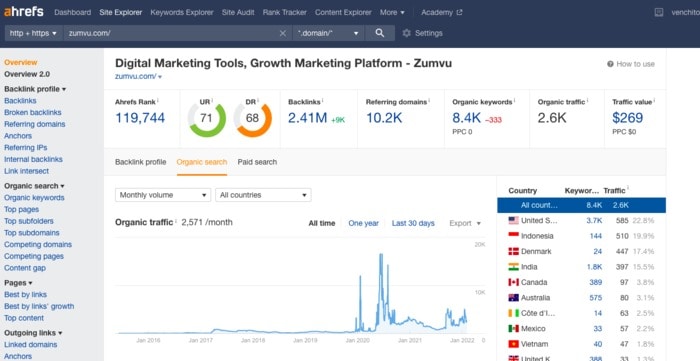
Next:
3. Check anchor texts of these low-quality links.
Dig deeper.
See if they have irrelevant anchor texts or keyword-rich anchor texts.
Make a note of these links with spammy anchor texts.
4. See their link types.
Bad backlinks are from non-authoritative websites and low-quality content (as mentioned earlier).
Check if any low-quality links are content farms, UGC (user-generated content), forums, and comments.
Also, make a note of these.
5. Manually check suspicious-looking websites.
Dig deeper and deeper.
After reviewing links with spammy anchor texts and low-quality link sources, check other websites with low spam scores.
There are other bad or spammy indications to links that are more obvious when you see the website.
Is the website full of display ads that the actual content gets difficult to read?
Does the website have a general (non-niche) audience?
Does the website have an old-school (the early 2000s) design template?
These are just a few things to look at in the backlink source to assess their link quality.
Now you need to:
6. Have a final list of websites.
This should be a list of backlinks:
- From low-quality link sources
- With irrelevant or keyword-rich anchor texts
- PBN-looking websites (old-school design template)
- From spammy content
- From irrelevant and/or elicits websites
Once you have a list, you have three courses of action:
Ignore these toxic links.
Because Google's algorithm has become so advanced in checking spammy links, they simply ignore backlinks to a website.
Especially if your website has gained authority and trust as it builds natural, high-quality links and offers readable and high-quality content.
Google will simply ignore your toxic links.
But if this is not your preferred action, you may:
Request for backlink removal.
Find all email addresses of websites hosting these spammy links.
Contact those webmasters and ask them to remove your backlink.
There are cases where they would ask you for a payment before removing your link. For me, this is not worth your money (you should've invested it in link building).
If, in any case, some won't remove your backlinks, it's time to disavow them.
Disavow
Disavow is simply telling Google that you don't count certain backlinks of your website.
To start with this, list down all domains or web pages you find to be low-quality.
Then go to Search Console and to its disavow tool.
You can check out the following guides to give more details on how to disavow toxic links:
Step 3: Discover Opportunities and Methods By Reviewing Your Backlink Profile
Backlink audit is not only about finding low quality backlinks to your website.
It is also discovering the best opportunities and methods.
Start by reviewing your backlink profile.
If your website has been successful in increasing its organic traffic. Plus, it attracts new backlinks every month.
It is best to uncover some content ideas.
How?
Use "Best by links" feature.
See which pages on your site have gained the most referring domains.
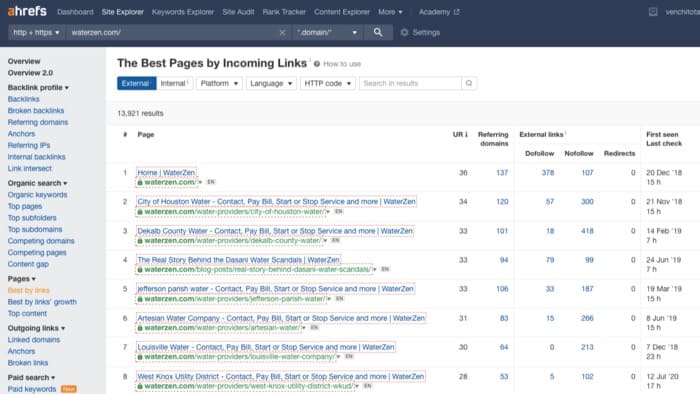
You can assess which content formats, length of content, and topics have resonated most with your linkable audiences.
From this insight, you can create similar types of content to continue the momentum of gaining new inbound backlinks to your site.
Another important discovery:
Use "Best by links growth" feature of Ahrefs to know what pages naturally attract backlinks.
The first one knows the type and topic of content that works, with or without manual outreach, to get links.
This time, it's more of getting insights into what gives your site the ability to attract backlinks, even without doing email outreach.
By link growth, you see that the page attracts new links from publishers who used it as references for their content (they see it ranking on the first page while looking for references in search).
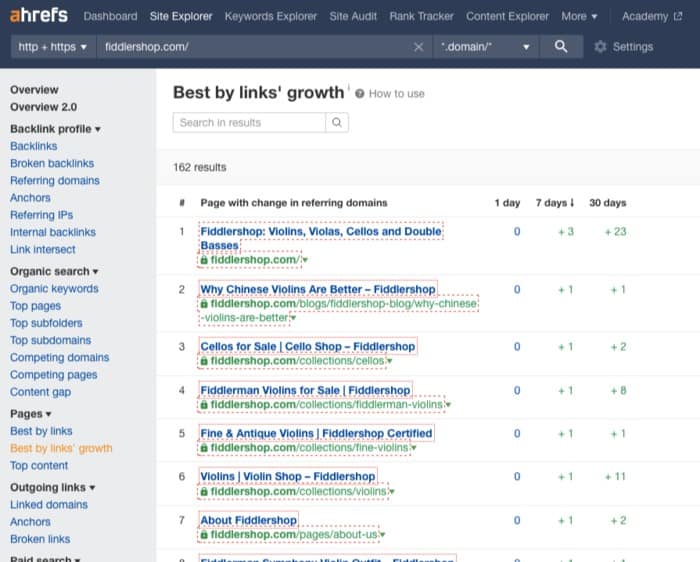
This is an important process, as you can also use it for your competitors to see what pages bring them the most backlinks.
Besides links, you also want to know this:
Know what websites bring you the most traffic.
Go to Ahrefs and view Backlinks report.
Sort websites based on Traffic.
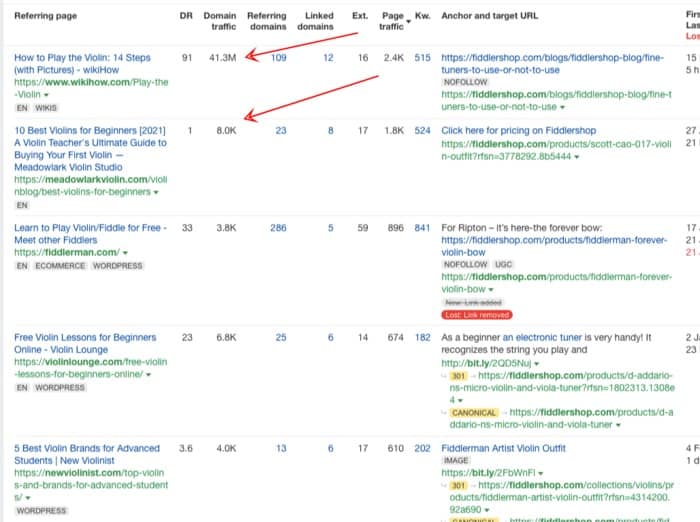
You want to know what websites pointing to your site bring the most referral traffic.
This insight leads you to improve your link building strategies.
One is to go after these publications and contribute more guest posts to increase the traffic you get from them.
Another way is to build content assets that resonate with high-traffic websites. So when you reach out to them and promote your content, you know it's something they'd be interested in linking as external sources.
Want some more actionable methods?
Read the next link building opportunity.
Discover patterns between your inbound links.
If you can identify commonalities between your most powerful backlinks, you start to understand why these people are linking to you.
Finding new backlink prospects that can help move the needle for your rankings becomes easier.
In summary, to get insights and methods by reviewing your backlink profile:
- Use "Best by links" feature to uncover content ideas.
- Use "Best by links growth" to know what pages naturally attract backlinks.
- Know what websites bring you the most traffic.
- Discover patterns between your inbound links.
Step 4: Check For Any Wasted Backlinks You Can Fix
Wasted backlinks are links that have brought value, but not giving desired link juice to your site anymore.
So what do you do about them?
Check for any wasted links and try to fix them.
How?
First:
Find broken pages of your websites with inbound links.
This is an overlooked opportunity in link building:
Pages that gained backlinks but given they are no longer function, these links are put to waste.
So, start identifying these broken pages by using "Best by links" feature of Ahrefs.
Then search for 404 pages by simply clicking the drop menu.
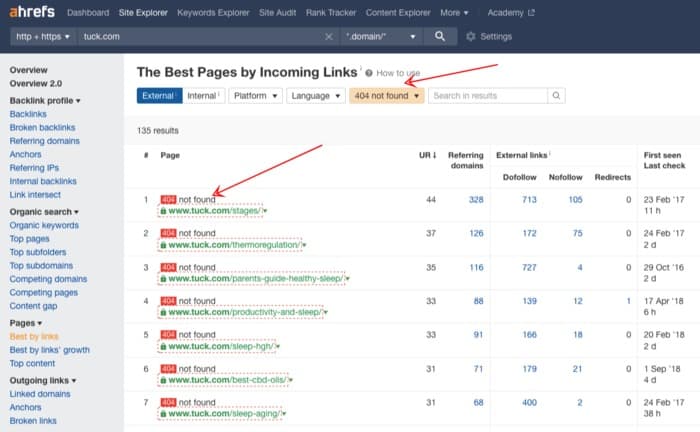
These are defunct pages with links.
Your action could be:
Redirect these broken pages to similar content on your site. This will pass link juice to your new page and, thus, help your linked-to page to rank for its target keyword.
Another plan is to create an entirely new page that covers the topic.
Once you publish your new page, you can reach out to publishers and webmasters linked to your broken page. Ask them to change their external links (from the old broken page to a new page).
Find pages with inbound links but with little to no organic search traffic.
You also want to look at pages needing internal linking to push their rankings up in search results.
How to find them first?
Once you enter the domain in Ahrefs Site Explorer, go to "Top Pages" report from Organic Search tab.
Filter pages based on Traffic maximum of 50 to only get pages that receive 0 to 50 in organic traffic.
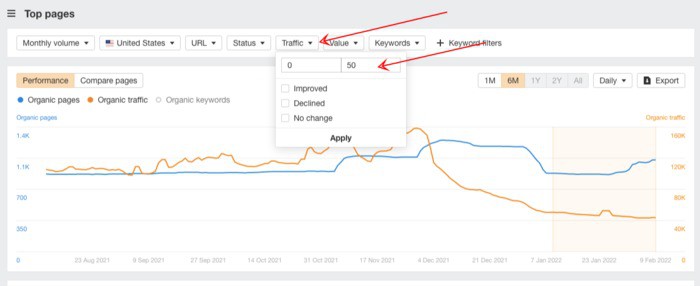
Export the results and examine them further.
Enter URLs in the Batch feature of Ahrefs so you can see how many referring domains are pointing to each page.
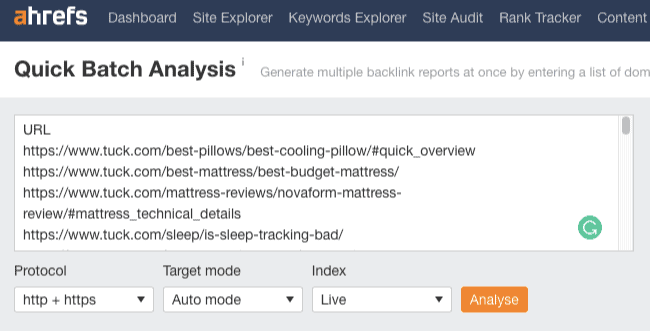
Sort the list from highest to lowest referring domains to arrive at pages with little to no organic traffic but receives a good number of referring domains.

What will you do with them?
Update and optimize this content.
Make sure on-page and off page SEO elements are added to the page. This doesn't only help the content to improve its rankings but also acquire additional inbound links.
Last thing for backlink audit:
Step 5: Strategize For Your Next Link Building Plan
After weeding out toxic links and seeing methods and more link opportunities to your website, your next action is to have a better link building plan.
This goes to say you'll think not just about the details of your website but from a view of your competitors.
Here are some tips in this last phase to make it work for your link building campaign:
Assess the right balance of distribution of efforts to your pages.
Not all pages deserve your attention if you're doing manual outreach for links.
There are only linkable assets that you can promote and could give you links from interested linkers.
Make a list of these linkable information pages.
Then, add to your list are landing pages you aim to rank for. These pages are part of your mid to bottom-of-the-funnel strategy that brings sales to your brand.
Now, you have linkable informational pages and landing pages in your list.
Here are some considerations when you decide which pages to build more links to:
What commercial pages are sitting in positions 6 to 20 in search results?
More backlinks to these pages can help improve their rankings and drive more revenue to your business. There is a huge difference in clicks from a page ranking at #1 from its competing page ranking at #6.
You can use Ahrefs to find these pages quickly.
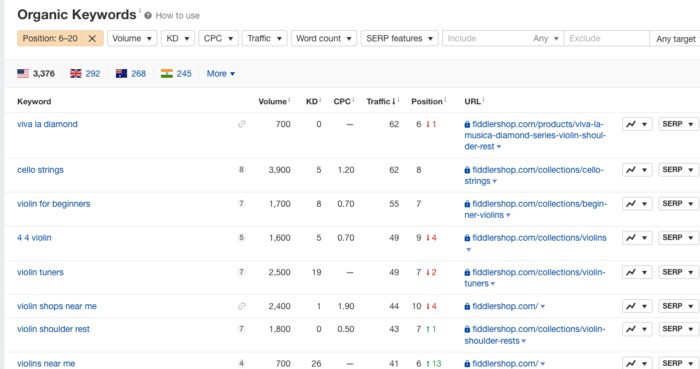
Or you can go straight to "Top Landing Pages" report.
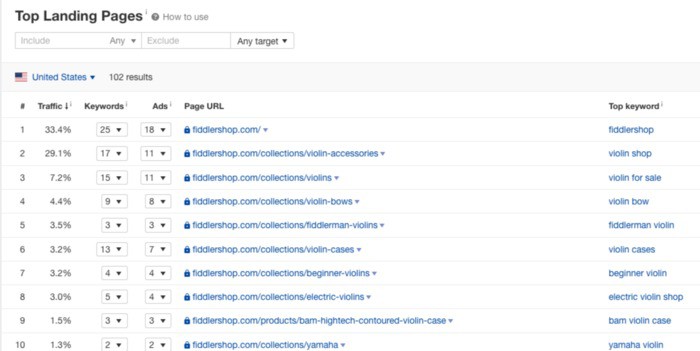
What pages are bringing you traffic but receive zero to few backlinks?
These are the pages that bring money to your website.
Building more links to these pages can drive up their rankings and increase your site's overall traffic value.
How to find them?
Enter your domain and go to "Top Pages" report.
Export the list. Then filter to less than 10 RD (Referring Domains).
Then sort the list by ascending Traffic.
Here, you'll see a list of pages with the most traffic value, but with less than 10 referring domains.
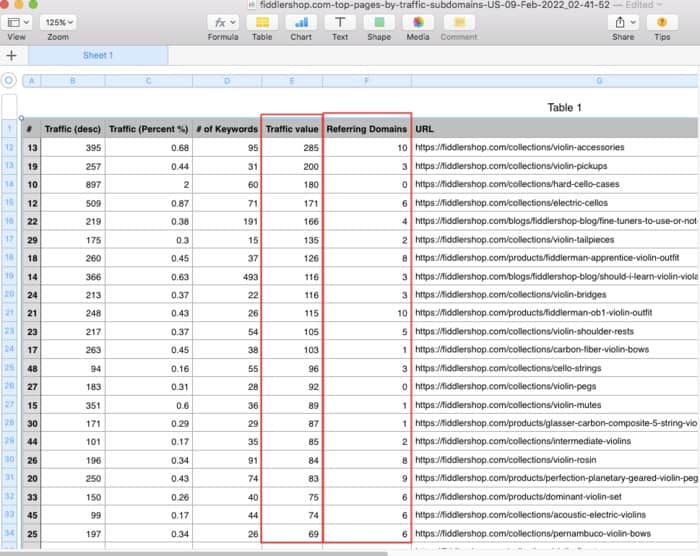
You can use our two considerations above to make a decision on which pages to push more links to.
Select pages for targeted links based on the backlink gap index. [ADVANCED]
Your next link building plan includes how to outperform your competitors.
That includes the quality and quality of backlinks you're building against them.
We've covered how to compute the backlink gap in the middle section of this guide. It is basically the difference between your site's number of referring root domains and your competitors' websites.
You can compute the backlink gap index if you want a more accurate number.
So on top of linking the root domain gap, you also compute the volume/gap ratio.
To compute this, simply divide the link gap into the search volume. See the example computation below from Garett French's guest ost on Moz.
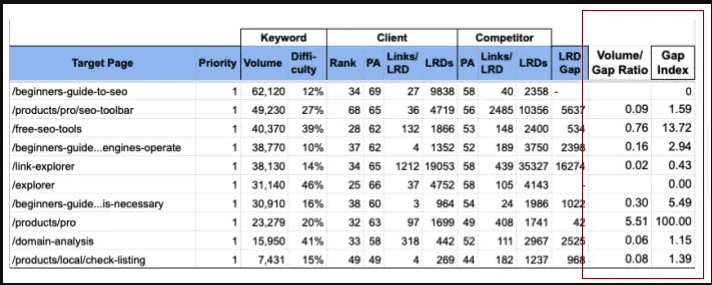
Know these two numbers: value per link VS cost per link.
Have a rough estimate of how much you spend to earn a single link.
While there are different variables to cost per link, finding a good number gives you an idea if you're spending too much.
For this section, here are good resources that exactly shows how to compute for value per link and cost per link:
Assess and Improve Your Link Building Campaign
A backlink audit aims to assess the current status of your backlink profile while identifying toxic backlinks you can remove and discovering opportunities you can maximize.
Keep this in mind. Every website is different. Some backlink audits might take days to finish; if done well, others can initially be done in 30 minutes.
Backlink Audit Frequently Asked Questions
What is backlink audit pro?
Backlink audit pro refers to thoroughly assessing all the inbound links to your website and determining their value and quality. By creating a comprehensive list of linking sites, you can evaluate each link and classify it as either beneficial or detrimental to your site's ranking and reputation. Ultimately, this analysis helps you optimize your backlink profile and improve your website's performance in search engine results.
How do I verify backlinks?
To verify backlinks, obtain a comprehensive analysis of the target's backlink profile. This will provide a breakdown of the websites referring to the target, helping you assess the quality and relevance of the backlinks. Analyzing backlinks is essential for understanding the link profile's strengths and weaknesses to improve your SEO strategies.
How do I remove harmful backlinks?
There are a few steps you can take to remove harmful backlinks:
- Reach out to the website owner: If you can identify the website owner or webmaster, you can try reaching out to them and asking them to remove the backlink.
- Use the "disavow" tool in Google Search Console: If you cannot remove the backlink through other means, you can use the "disavow" tool in Google Search Console to tell Google not to consider the backlink when evaluating your website. To use the disavow tool, you must create a list of the URLs of the backlinks you want to disavow and submit the list to Google.
- Monitor your backlink profile: It is important to continue monitoring your backlink profile to ensure that new harmful backlinks are not added. You can use a backlink analysis tool to track your backlinks and identify any new low-quality or spammy links that may have been added.
- Implement a backlink removal strategy: If you cannot remove harmful backlinks through the above methods, you may need to implement a more comprehensive backlink removal strategy. This could include using the disavow tool, reaching out to website owners, and using other tactics to decrease the value of harmful backlinks.
It is important to note that removing harmful backlinks can be a time-consuming process, and it may take some time to see the results of your efforts. However, improving the quality of your backlink profile can have long-term benefits for your website's search engine rankings.
How often should I perform a backlink audit?
It is generally recommended to perform a backlink audit regularly, as the quality and relevance of your backlinks can change over time. Some experts recommend performing a backlink audit at least once a year, although more frequent audits may be necessary for websites with a large number of backlinks or those that are facing significant ranking fluctuations.
Here are a few other factors to consider when deciding how often to perform a backlink audit:
- The size and complexity of your website: If your website has many pages and a complex backlink profile, you may want to perform a backlink audit more frequently to ensure that all of your backlinks are being properly evaluated.
- The competitiveness of your industry: If you are in a highly competitive industry, you may want to perform a backlink audit more frequently to ensure that your website is not outranked by competitors with stronger backlink profiles.
- Your overall marketing strategy: If you are actively improving your search engine rankings, you may want to perform a backlink audit more frequently to identify opportunities to build high-quality backlinks.
Ultimately, the frequency of your backlink audits will depend on your website's specific needs and goals. It is important to find a balance between conducting frequent audits to ensure the quality of your backlink profile while also not spending too much time on this task.
Link Building for Local SEO [27 Strategies For 2025]
This is the most actionable guide to link building for local SEO.
You'll learn here how to build backlinks for any local business on a shoestring budget.
Also, you'll discover some advanced strategies for 2025 (and beyond) that I never shared anywhere.
Let's get started.
1. Use Job Portals For Quick Backlink Wins
When building links for our clients, one of the first questions we ask is, “what's the existing content asset in the client’s website we can use as USP for linker outreach?”.
This question breaks the “content mental block” often experienced when strategizing what link acquisition tactics require content to create to acquire high-quality links.
Interestingly, we’ve discovered that there are existing under-utilized pages published on client’s sites that we can use to show/provide to publishers and content creators to get them to link to the client’s page.
A great example of this content is “jobs portal”.
A “jobs portal” is a directory/curation of all job positions available in a local area.
Your brand can even curate available positions for a specific industry (e.g. “tech startup jobs in New York”).

For some local brands I’ve audited, the jobs portal is inherently the first few pages published on their sites. It serves as a content hub for their local partners, like local professional organizations looking for new team hires.
The jobs portal caters specifically to the “job seekers” linkable market with a lucrative number of links pages.
Link prospecting for this strategy is pretty much the same as how you’ll normally do it for a resource page link building or broken link building strategy, but the difference is just that you are only looking for a local linkable market - “jobs links/resources pages in Boston” for example.
You can start prospecting using Google search with any of the following search queries to collect your initial set of local link opportunities:
- “job search” “resources” “CITY”
- employment” inurl:resources “CITY”
- “job hunting” resources “CITY”
- inurl:careers “CITY”
Expand your list by reverse engineering other local job portals or job board sites.
By checking which pages link to local-relevant job board sites on this page, I collected a few more tens of local links pages.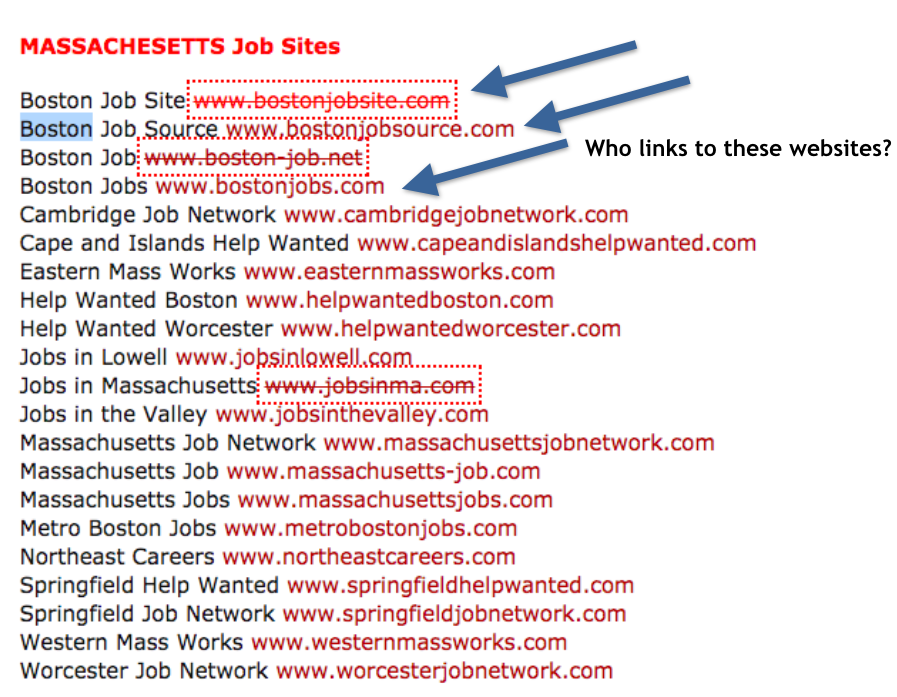
Once you have generated your list of prospects and their contact details, you can start engaging them through your outreach campaign.
Spend a few extra minutes to check if there are broken links on a prospect page.
If all links are working, simply request to be included as an additional resource on their links page.
I’ve found it helpful to add subtle changes to email copies to emphasize the local relevance of the jobs portal or any other local content pieces I’m building links to. I usually add lines for:
- The best section on the resource page to add the client’s local content
- Who is the target audience of the content?
- A few recommendations for content that serves as a social proof

With proper execution, we were able to acquire links:
2. Create Localized Visual Data
Image link building (infographic-based link building) is getting more saturated as more brands try to pick up on it. But with the right audience targeting, accurate data, and impressive design, visual data can still prove its effectiveness in getting high-value links, especially if it’s been massively promoted through different content distribution channels.
One way to get started with this approach is to find a local piece of content created by other publishers who had extensive research on a particular subject matter and transform it into a visual asset.
To give you an example, recently, we’ve been looking for a piece of content that we could well turn into an infographic.
By searching for available public data on different trusted sites, we’ve found a research study on teen dating, abuse & bullying with respondents in New York, New Jersey, and Pennsylvania.

Side note: here are a few public data sites you can source information from for your visual assets:
- https://www.data.gov/
- https://socrata.com/resources/
- https://datahub.io/
- http://data.worldbank.org/
- https://www.reddit.com/r/datasets/
We’ve checked if the public data is still relevant in the current year, as we want to get the most recent study as much as possible (the latest we consider is 2016).
One way that helped us assess the relevance and credibility of a public data piece is by looking at the version history section. For example, the research study we considered was initially published in 2012 but has been updated for 2016 (indicated in the version history section).
Then we strategize how the public data content can be turned into an infographic without cursing the target audience with knowledge.
Given that the research study has two sections: teen dating & abuse and teen bullying, we’ve decided to choose teen dating & abuse and keep the latter for future content references.

The hardest part of visual data link building is content creation.
As an agency, there are two ways to attack this: outsource to a freelancer or hire an in-house graphic designer.
We chose the latter simply because it’s time and cost-efficient.
Produced the visual data (partial image below):
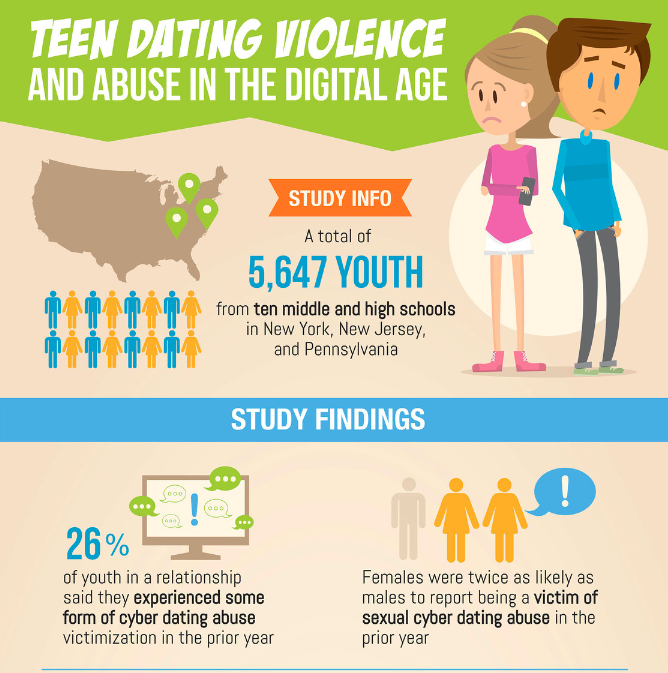
Then we spent most of our hours looking for potential link partners or content publishers interested in the content piece we produced.
We begin prospecting using the following local-centric queries in Google search:
You can also use Reverse Image Search or Tineye to find and track any local-based infographics for local bloggers and publishers who distributed these pieces on their blogs.
If you’ve been running out of prospects, you can tap other industries and look for local publishers who still cater to the targeted audience of your content.
In our case, we tapped local legal publishers with the injury/sexual harassment categories in their sections.
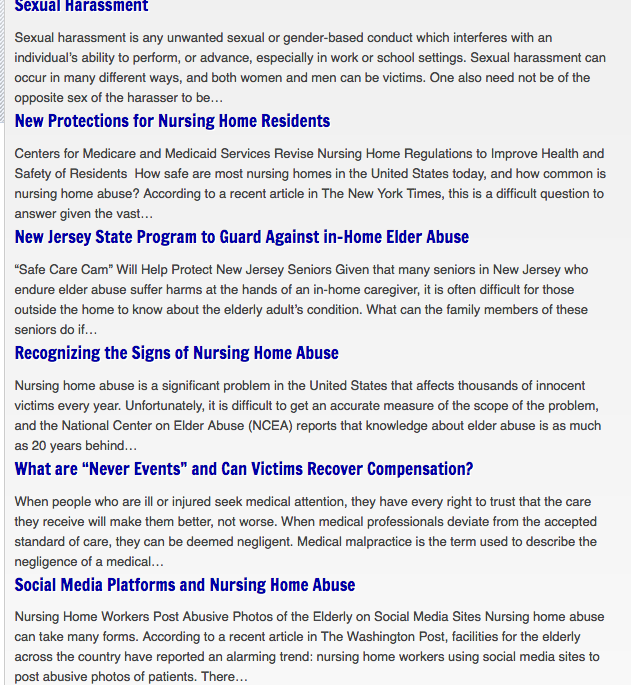
As for the outreach, make it easier for local prospects to know interesting facts about your visual data. It is best to state some numbers and your target audience to build the context, relevance, and credibility of your content piece.
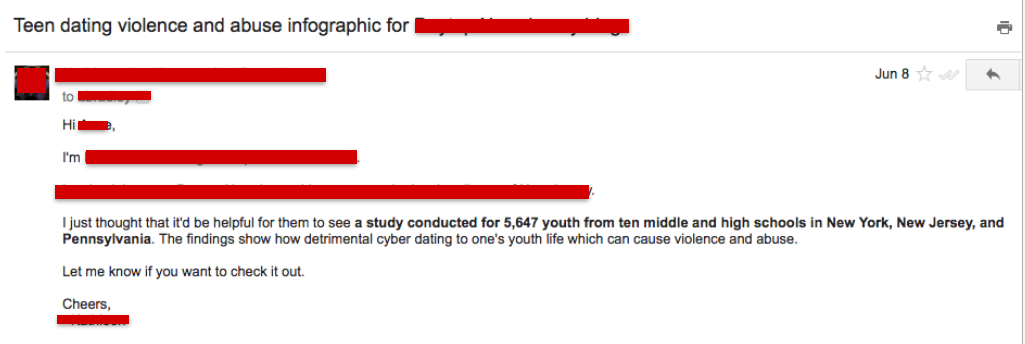
You can test the two-blogger outreach process to capture your prospects’ interests initially, then eventually send the link pointing to your visual data (or attach it to your email conversation) if they’ve positively responded to your initial pitch.
Useful Resource: The State of Backlinks for SEO in 2021: What 800+ SEOs Think About Link Building
3. Realize Opportunity In "New To An Area" Pages
For local link building, what I’ve found to be the most quantitative (high amount) in links/resource pages are those that cater to audiences relocating/living in a new area or city.
Typically, these pages provide lists of resources/references that a person new to an area would definitely find.
Here are some examples of local “new to an area” topics:
- Quality schools in [City] or finding the right schools
- Local laws in [City]
- Tourist information, local attractions, or things to do in [City]
- How to get here
- Volunteer listings in [City]
- Moving and relocation in [City]
- internet & cable
- my neighborhood
If you are marketing a brick-and-mortar business, a local attraction, a local professional organization, or a utility company (i.e. internet cable), it’s best to get your initial set of links from this type of resource page.

You can start prospecting by using “page-level” qualifier queries (which I highly recommend if you’re looking for “new to an area” topical pages) through Google search.
If you're prospecting for "things to do in [City]" pages, here are the following search queries that you can use:
- inurl:"things to do" [City]
- intitle:"things to do" [City]
- inurl:links activities in [City]
The above approach is an alternate option to the basic link prospecting queries for resource page link building (i.e. using inurl:resources OR inurl:links “keyword”). It expands your search for link opportunities that don’t necessarily have the title tag or URL qualifiers (intitle and inurl).
The next step is to reach out to webmasters of these links pages and offer your website to be included as an additional resource on the page.
I’ve found it helpful to prepare short lines/descriptions to be added to the links page along with your link. It can help remove webmasters’ burden of thinking about what texts to add that describe your brand/website (e.g. best description of your local attraction).

If you’ve executed it properly, you’ll get a link.
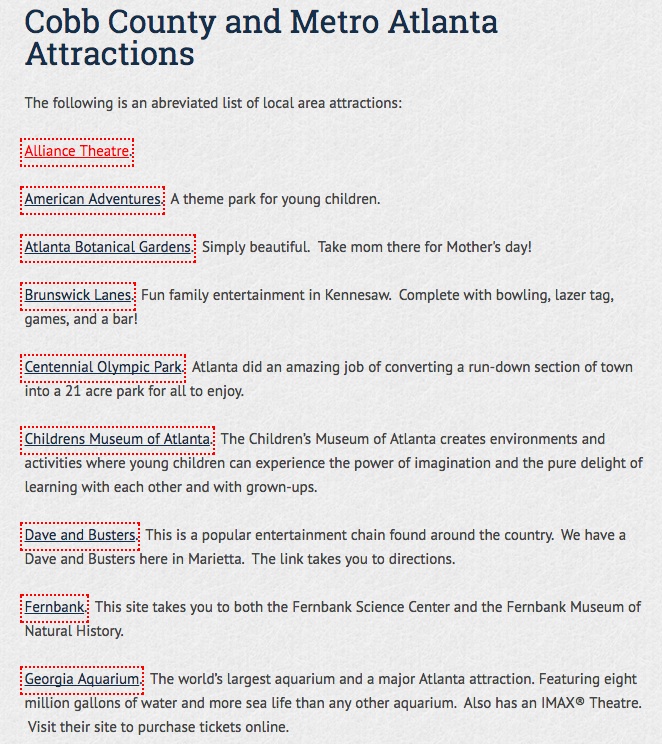
4. Get Resource Links From Summer/Off-Campus Housing [City] Pages
Summer housing/off-campus housing pages are resource lists of available housing options for students and interns in a local area.
This type of webpages can positively generate exposure to brands they’re linking out to and provide possible leads for brands’ services since the page focuses on recommending rental offerings currently available in the area.
The closest vertical that can benefit from generating high-quality links from summer housing [city] pages is real estate, particularly local apartment brands, housing, and rental services companies.
National brands with apartment rentals in different cities can also use this link acquisition technique by acquiring links from summer housing resource pages available in cities they cater offerings. The more cities they’re marketing to, the better they could take advantage of this local link building tactic.
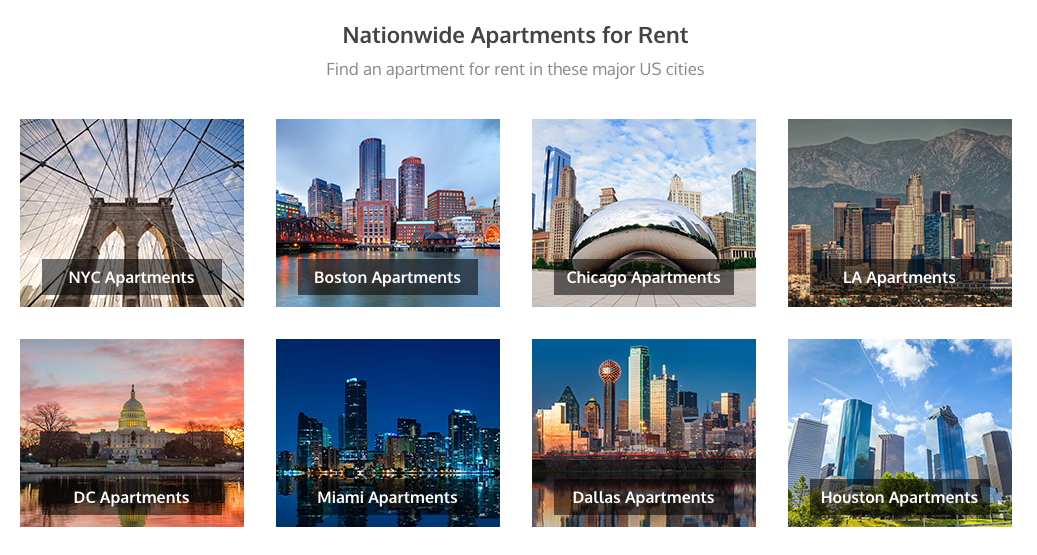
You can start this link approach by creating a list of targeted link prospects from Google search results - using any of the following search terms:
- “Off-campus” housing [city] “resources”
- “Student housing” [city] “resources”
- “Internship housing” [city] “resources”
Populate your list by checking broken domains for inbound links from summer housing pages. A simple plug to your favorite link checker tool can help quickly assess the number of unique referring domains pointing to these dead websites.
For example, this extinct site that used to be an apartment rental site has 75+ unique referring domains that include solid .edu sites links pages. A quick look at it can reveal tens of potential summer housing pages that can be added to a link list.
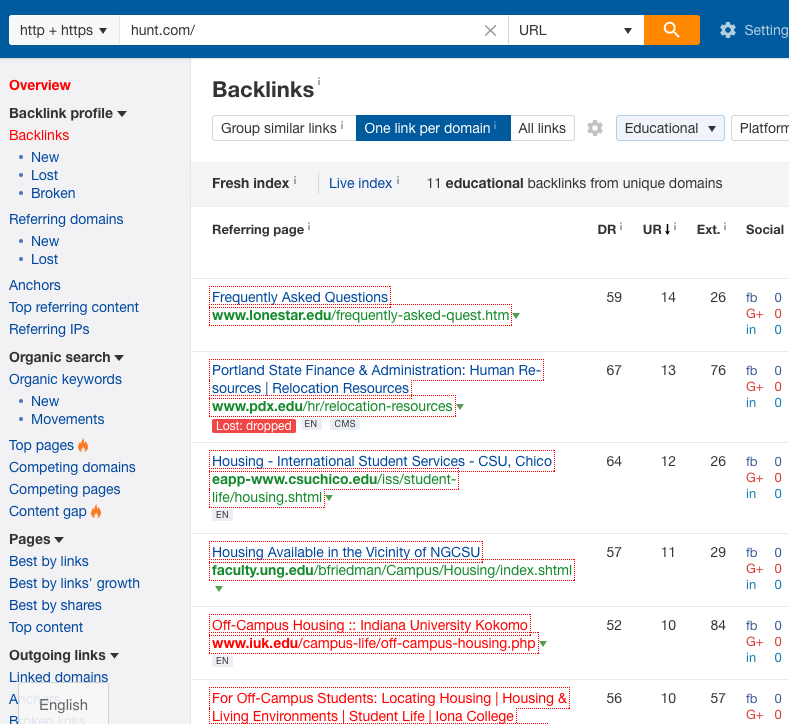
Then craft email copies you can use for your local outreach that is straightforward and easy to personalize.
Finally, acquire the link:
5. Serve FSQ With Local Content
Creating content that’s really hard to do and that is better than its competitors is definitely one of the best ways to stand out as an authority publisher in the industry and acquire high-quality in-content links from other content publishers on the web.
In addition, ensuring that the content piece has well-served its audience by providing their needs through the useful information on the page can increase the chances of building and earning backlinks from highly relevant sites.
For local content creation, here are topics that are frequently searched (FSQ or frequently search queries) by a local audience and linked to by local publishers:
- Street occupancy and moving permits
- [city] neighborhoods
- Helpful moving tips or things to do before you move
- Resources for landlords & tenants
- Homeowner resources
- Voter registration
- Address change
The main key to success in creating local content is to be succinct while being so much helpful in providing the details that the local audience needs.
Coming up with a guide that sums up all of the items mentioned above for people looking for direct information is an extremely useful content asset with a high chance of earning links from local content creators.
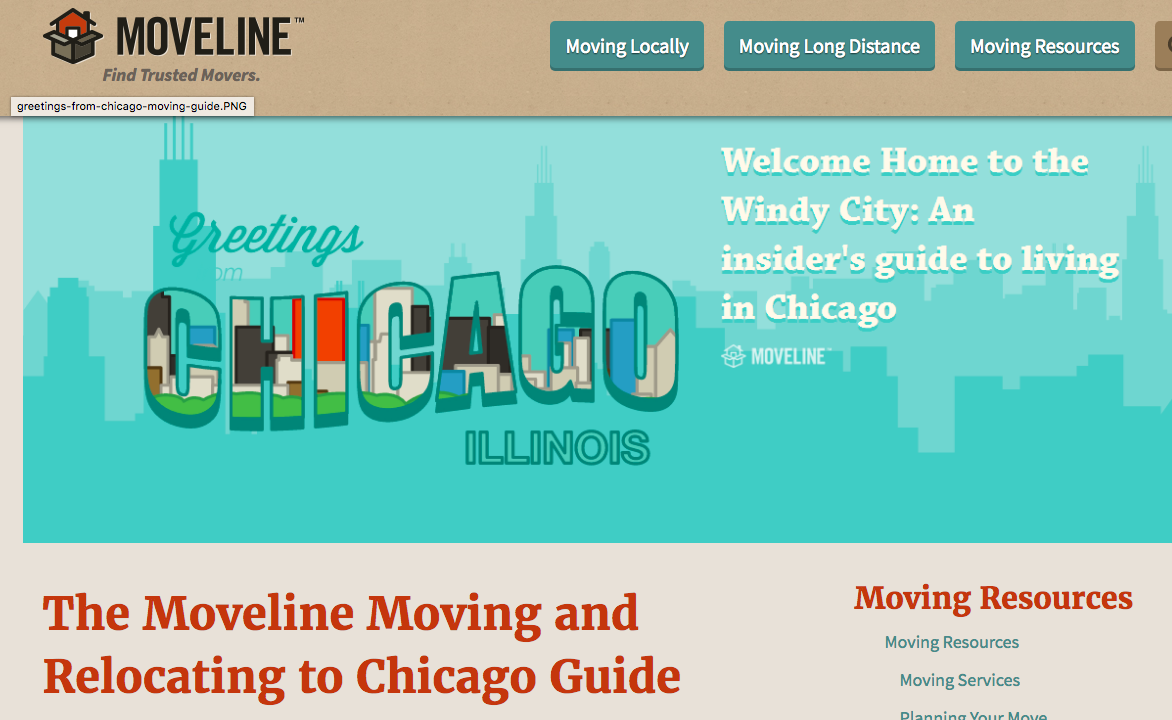
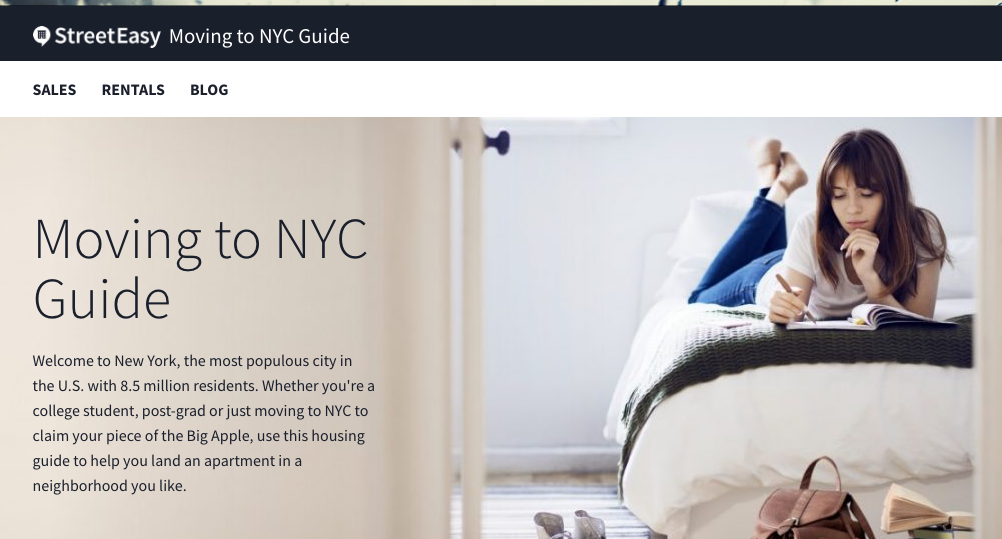
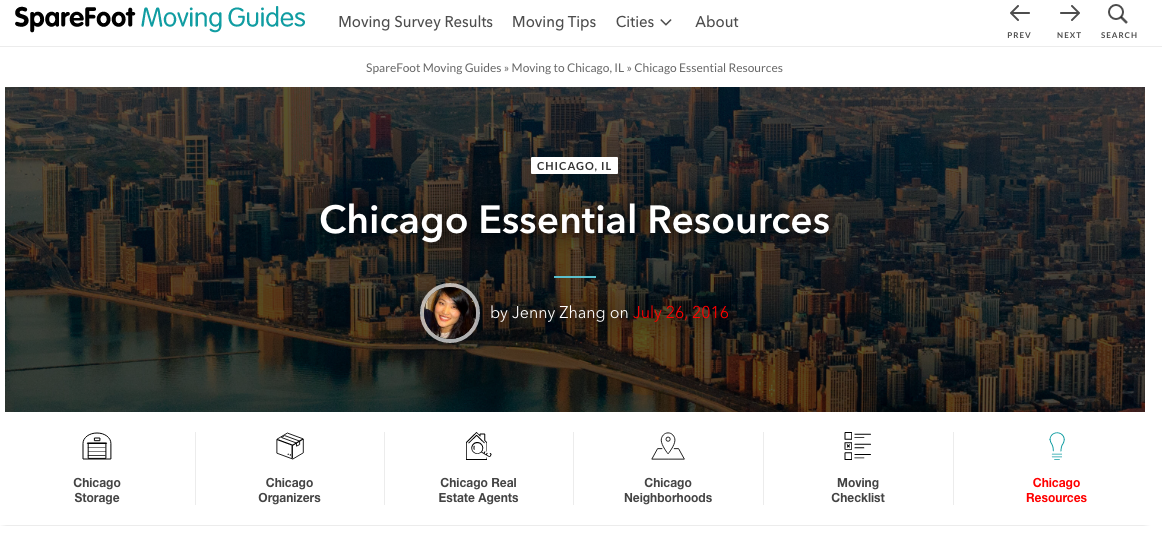
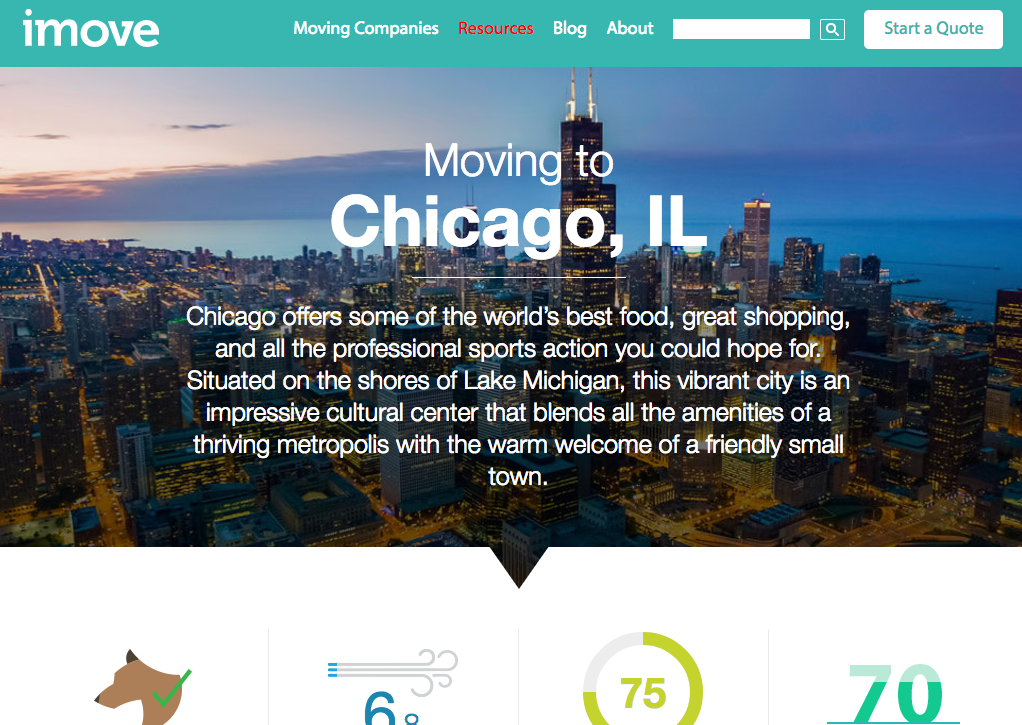
6. Seed Answers For Long Tail Online Discussions
Conversation marketing is a highly effective brand-building tool for local business owners, marketers, and an agency that markets local clients who don’t have a huge budget to spend building a strong brand presence online.
While it’s time-consuming, the amount of effort put into value-added conversations can invaluably bring momentum and exponential growth of links and drive referral traffic and potential leads for the business.
One of the best ways to start this approach is by joining online communities where your local target audience participates and looking for direct information.
For example, if you’re promoting a local attraction site, answering questions on StreetAdvisor can be an initial jump to your conversation marketing efforts.
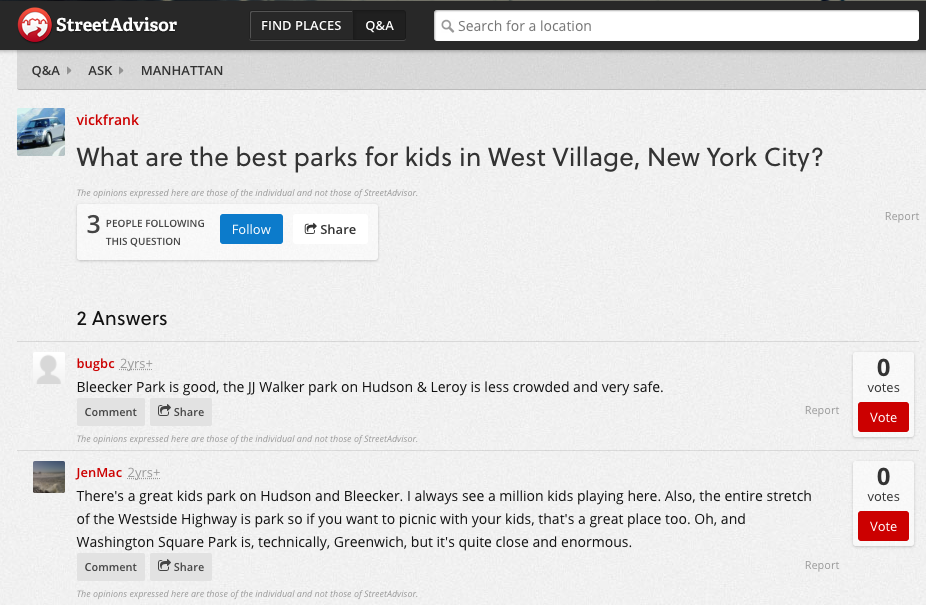
Below are some ways that you can do to leverage and scale conversation marketing for your local business:
- Do Google searches for direct questions that people are seeking to find local businesses and attractions (e.g. best [product/service] in [city/area]) and spot-on local and niche-specific forums that are currently ranking in the first two or three pages in search results - these online pages still receive a few tens/hundreds of organic traffic and may bring valuable traffic to your website.
- Choose an in-house team member with a strong knowledge of the product/service you’re offering and let him/her spend 20 to 30 minutes daily participating in local online discussions.
7. Promote Your Local Content Using Reddit
Reddit is a community news aggregator site that has its own ranking algorithm to decide which referring link deserves to be placed on the front page for a specific subreddit.
If you’re launching local content that contains a compelling story/data and design-driven images, such as infographics, then Reddit is a place that you can utilize to put more eyeballs on your content (increasing the amount of traffic you’re getting).
You can start by identifying specific subreddits relevant to your local brand. Do a Google search for site:reddit.com “keyword” OR “city,” manually check each subreddit and see if they cater to the audience with the same demographics you’re targeting.
Create a list of relevant subreddits and their current number of subscribers and online users (photo credit: Siegemedia).

It is best to take a few minutes to check referring links placed on the front page of each subreddit to assess content types (images/videos/data) that best resonate with the subreddit audience. You can add a column for Notes or Remarks in your spreadsheet to mark content formats/types.
Once you have the Reddit data to base your content upon, you can produce niche-specific content pieces that are context fit to those local subreddits.
You may want to check out this comprehensive post on creating content by building traffic sources backward from Reddit.
The next step is to customize social buttons on your content by adding a Reddit button, for example, to make it easier for Reddit users to upvote your content.
Another approach that you can make to increase the likelihood of ranking your story on the front Reddit pages is by reaching out to like-minded individuals in your industry or sharing your subreddit link with an online group of marketers to get more upvotes for your client’s content piece.
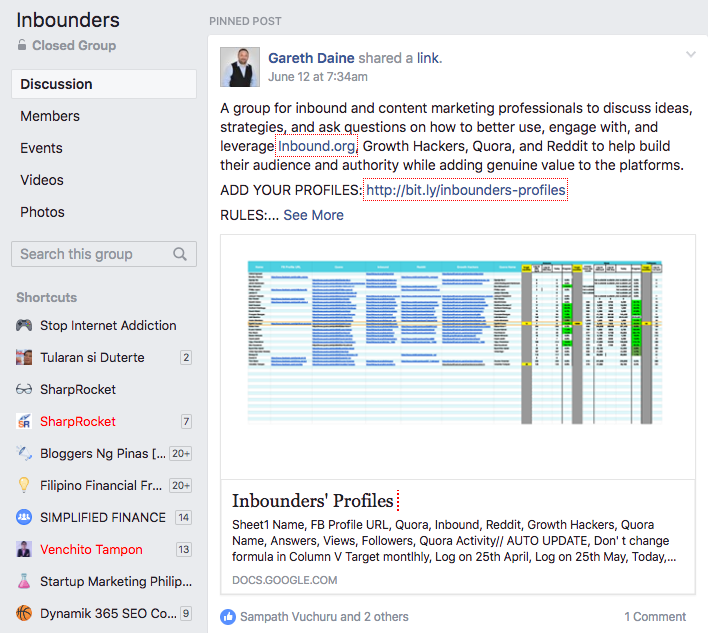
8. Use Affinity Categories For Local Sponsorships
Sponsorships are big in local SEO.
It's nothing new.
But what makes local sponsorships successful?
Answer: proper targeting of audience.
I'm not referring to types of entities: car clubs, event organizers, town clubs, charities, and forums.
But I'm referring to your:
Potential customers.
Most local sponsorships target any local audience but not those who purchase their offerings — products/ or services.
One way to know the right market segment for local sponsorships is:
By identifying affinity categories.
Affinity categories are users likely to be ready to purchase your products or services in the specified categories.
You can find these categories in Google Analytics:
Audience > Interests > Affinity Categories
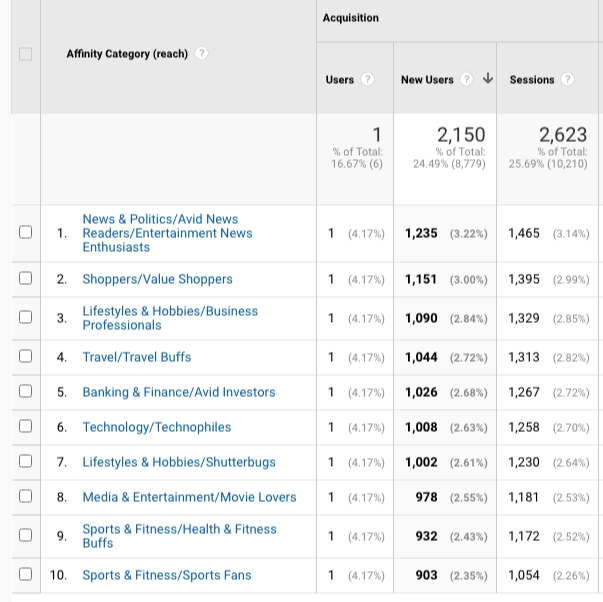
These are specified categories your potential customers are also interested in.
You're not just getting any sponsorship link from a local website.
But you benefit from directly putting your local sponsorship to potential customers.
Pro Tip: Zipsprout has reliable link building services that directly target local sponsorships.
9. Publish Review-Type Guest Posts For Local Vendors
Guest posts are everywhere.
But instead of doing it the traditional way for local link building.
Why not try this one?
Modified shoulder guest post.
You may not be familiar with this, but it's so simple.
Here's the process:
Identify local vendors.

You may partner with these brands as part of your operations and marketing.
In other words, you've used their products or services to grow your business.
Pitch to them, not guest posts.
But a case study or a review.
The first section of the article shares about your brand — a topic, and you include the link back to your website.
Then in the second part, you showcase how that local vendor has helped grow your business.
Simple.
10. Build Vendor Partner Links
Your vendor partners are the best sources of links.
Why?
Because they know you, they're likely to make your requests. And that includes — links.
So think about who is your vendor partners.
If you run a restaurant, you may source bread from a local bakery, or your ice cream could come from a homemade mom-and-pop shop.

Have a list of all products you sell as a brand. Then check your vendor partners for each food (for example).
Then see if they have local stores.
Do eCommerce link building by going through their "vendors list" pages.
Reach out to them and ask for links.
11. Get Low Hanging Fruits From Competitors
Competitor link analysis is nothing new.
You check who links to your competitors. Make a list of them and try to get backlinks from those pages.
In local link building, you start your search with your target keywords in Google Maps and organic search.
Then, it's time to discover some low-hanging fruits.
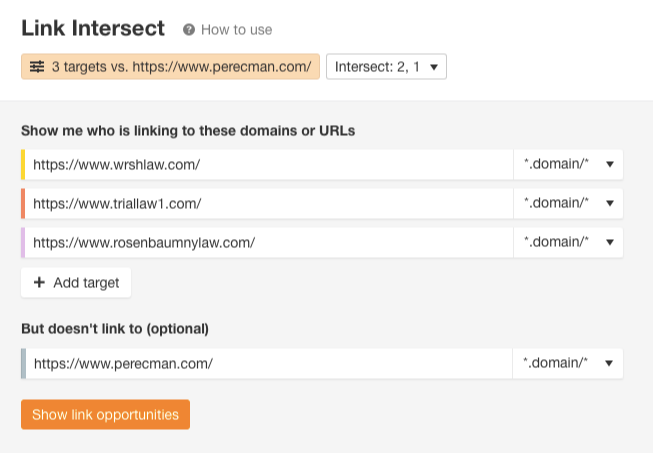
Put in your competitors' domains. And include your website as well — but it doesn't link to you.
You'll now see a list of websites that link to your competitor but not your site.
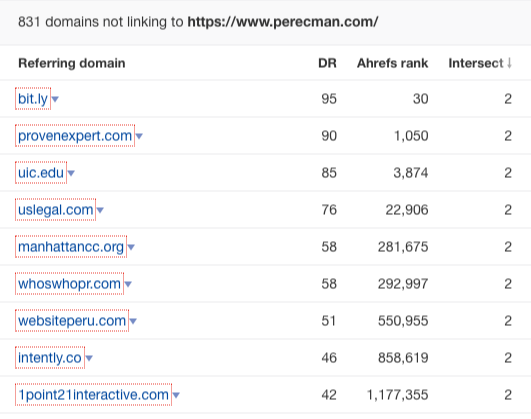
Another good thing here:
You'll find link opportunities that are linked to a 404 page.
What you could do here is to create a better piece of content.
And reach out to all websites that linked to the broken page.
One more creative thing to do:
Get information on what link building tactics your competitors are doing.
This opens up new ideas and backlink opportunities for your local business.
12. Offer Free Content To Local Business Groups
Guest posting is nothing new in SEO.
The typical approach to prospecting industry blogs is through Google search.
Use advanced search operators (i.g. inurl) plus topic. Then you'll see possible websites for content.
But what if you almost run out of guest post targets?
What is an alternative way to find new niche blogs?
A NEW guest post prospecting strategy:
Facebook groups.
Not just generic Facebook groups that explicitly buy/sell or accept guest posts.
But I'm referring to local Facebook groups.
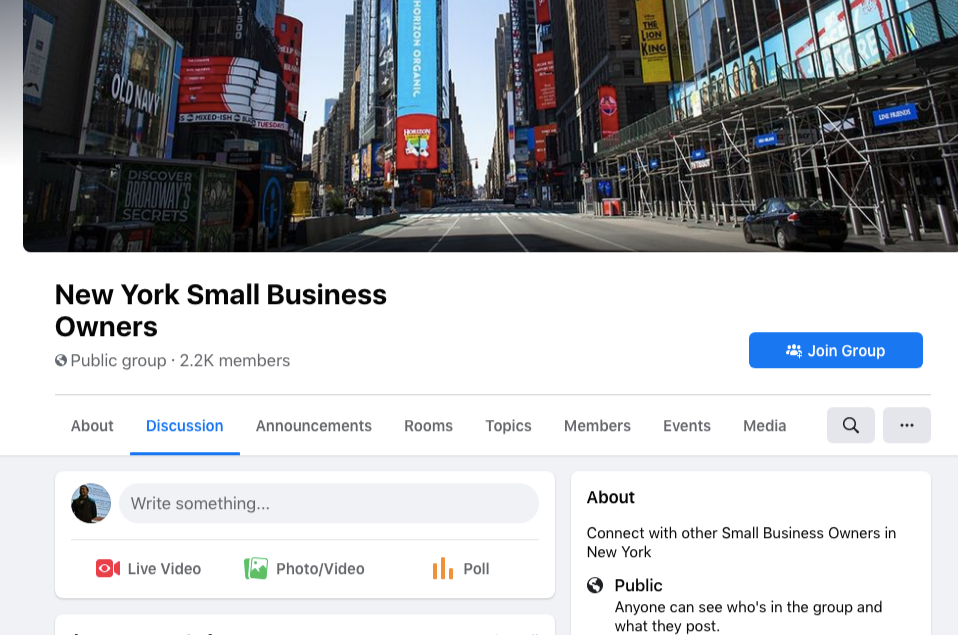
One way to get guest post prospects is to offer an exclusive service to any content writer or SEO person of a local business.
By posting on specific local business groups, you open an opportunity for anyone interested in free content in their niche.
You can start with specific niche local businesses to make your content offer appeal to members of the group.
Then once you get comments and personal messages from local business content creators, you can check the quality of the blogs.
See if it passes your blog standards. Then, write and publish an article to their blogs with editorial links.
13. Pitch Statistics Content To Local and Regional Publishers
Getting attention from local media isn't that difficult.
Create content with a story appealing to local publishers, and you pick up great backlinks.
How can you do that?
Think of statistics content.
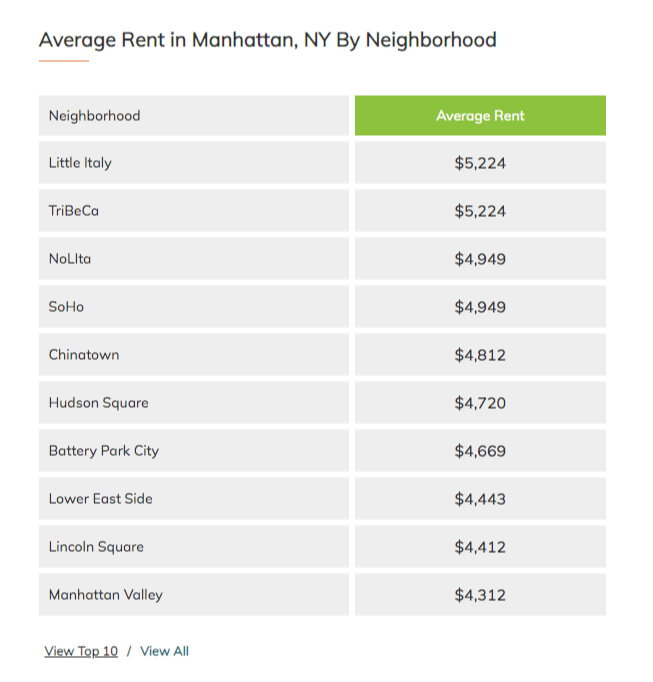
Local publishers often cite this type of content as they have information not usually found elsewhere.
Especially if points and stories are interesting or unique.
One angle you can look at is state-by-state local data.
For example, "During Covid, Rental Rates in X States were % more expensive than in Y States".
While you can pitch this content directly to national publishers, pack some data points for local media attention.
14. Get Strategy Inspiration From Other Markets
Running out of link prospects is normal.
It often happens for local link-building campaigns where only a few websites are discovered in a specific city.
How do you come up with new targets for links?
The answer:
Outside your market, take the time to look at any other markets.
Maybe, you've been thinking:
What sense would it make to see your websites from different marketers when they don't work directly with your website?
The answer is pretty simple:
You get inspiration for new link building ideas.
So if you're in a smaller metro area, try to find other similar businesses from a large metro — to see what's working for them.
If you're in a large metro area, analyze backlink profiles from other larger metro areas.
You can also explore other niches, not just local businesses from other metro areas.
Let's say you're building backlinks for attorneys. Maybe you can see what's working for other industries like pest control.
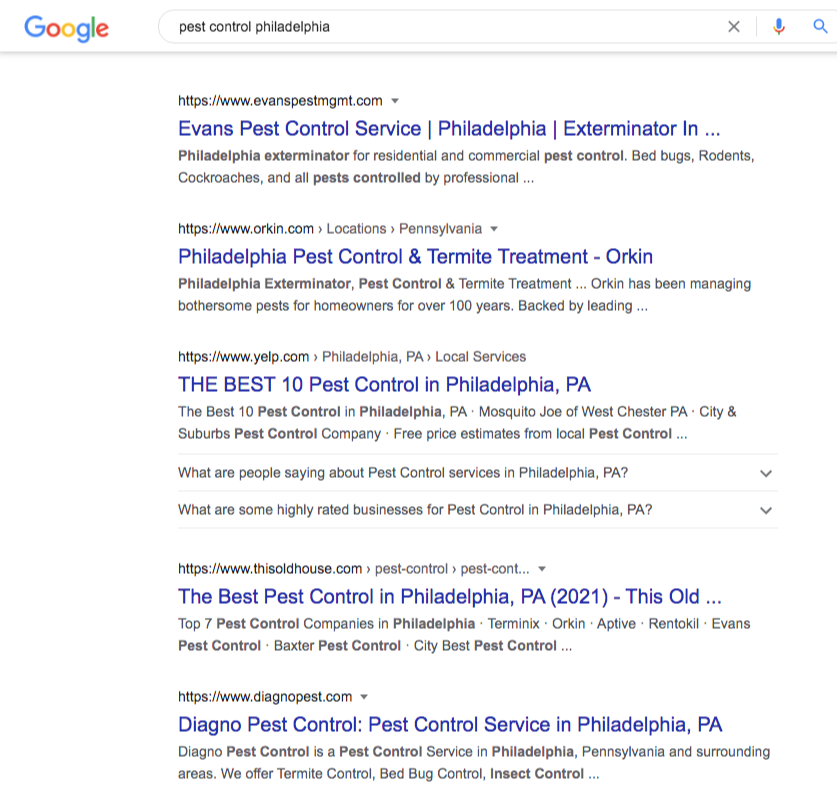
One tactic in a niche can be used differently in your local business niche.
If everyone in the legal market is doing scholarship link building, you won't see it being effective if it's adopted by many, including your competition.
When you discover a link building technique that's not being abused yet by many…
You stay ahead of the competition.
Different markets have different search landscapes, so every backlink profile from ranking websites opens up other link building techniques.
15. Build Backlinks From Alumni Directories
One common type of local backlink is alumni links.
They are easy to spot and acquire for your local business.
How?
You start by looking for local schools.
Then see if they have alumni directory pages with links.
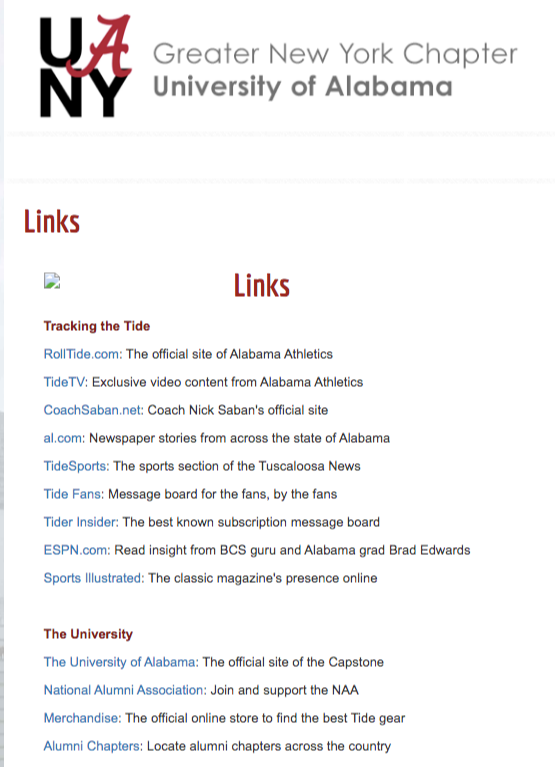
From there, you use either two of these creative ways:
Provide discounts to community members to get links from their sites' member benefits page.
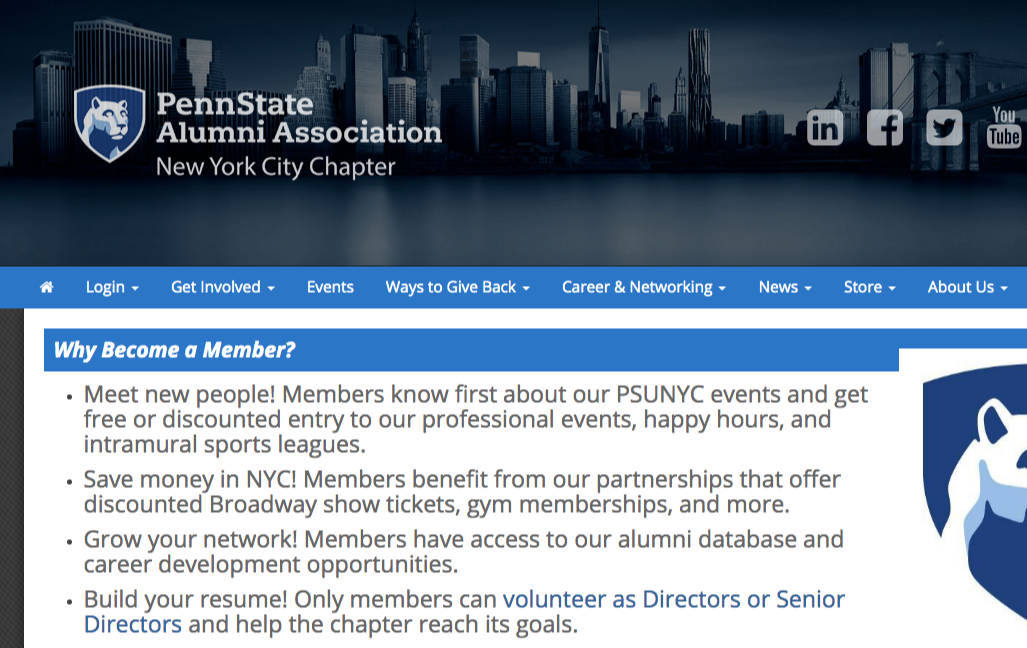
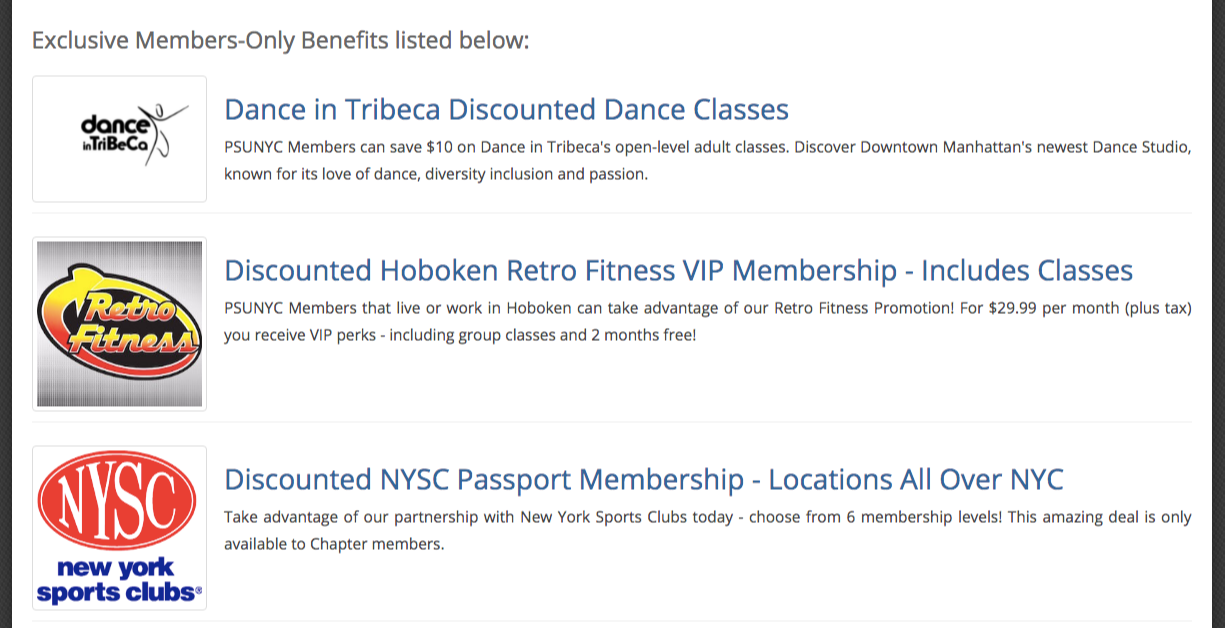
Or offer a free event space for org meetings.
If you're an eCommerce, the first one perfectly works.
If you have extra office space (or an events hall), the second idea gives you links.
16. Acquire Gov Links Using the "Bait and Switch Strategy"
Gov links aren't easy to acquire.
Especially for local businesses, you’ll have a competitive advantage if you can get those authority links.
Bait and switch strategy.
This is a budgeted local link building campaign to land gov links.
Here is a seven-step process to execute this creative link building strategy.
Step 1: Find 30 to 50 local councils.
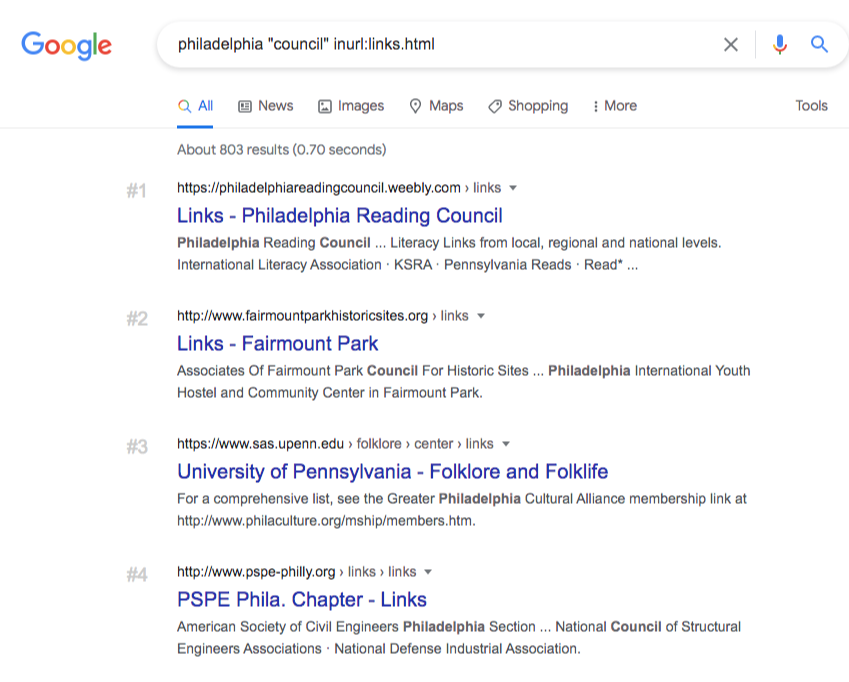
Step 2: Think about what to offer to council members. It could be a yoga class or giving away gym equipment.
Step 3: Purchase and create a .org domain. Then create a website based on your offer. For example, make a community yoga class website with a council finder if it’s a yoga class. It has no commercial intent but purely includes community information.
Step 4: Create a landing page related to the value offer (e.g., a yoga class landing page on your website).
Step 5: Reach out to all local councils and other websites to promote your new .org site.
Step 6: Create a landing page related to the value offer (e.g., a yoga class landing page on your website).
Step 7: Redirect the .org to your landing page with links to your money pages.
Win.
17. Find Local Businesses That Feature Non-Competing Brands
A strategic partnership is an excellent way to think about local link building.
There are great link opportunities when two or more non-competing brands collaborate.
For example, if you're doing SEO for a photography website, you can find ways to get featured on wedding and event organizer sites.
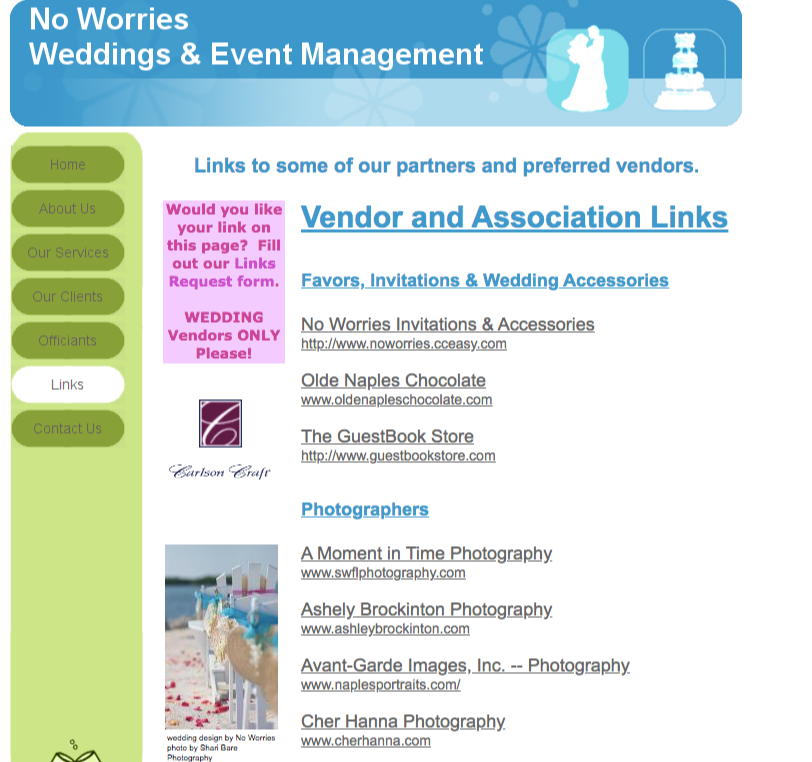
It may be from their blog section or their page listing local partner brands.
If you're a wedding organizer, one of the best links you might get is from wedding photography sites. They might feature weddings shot at their venue.
Think of your brand.
Identify your non-competing brands.
Reach out and ask to get featured on specific pages or articles.
18. Find Local Government Programs For Certifications
Certifications help build up the credibility of an individual or business.
But did you know it's also an excellent way to earn good local links?
Here is how to get started with this:
Find resources or programs your business needs to enroll in or get certified in.
If you've been certified in a few places, check those certification websites and see if they linked to people or businesses they are certified in.
Invest your resources in these certification programs for additional credibility or brand exposure, especially if your local business needs them.
19. Offer Unique Testimonials To Local Businesses
One of the best social proofs is testimonials.
If a customer gives you a testimonial in written or video format, it increases the perceived value of your products/services.
Potential customers will likely see the results from using your offer.
Think testimonials not only for conversions but also for local backlinks.
Local businesses won't ignore an honest testimonial from a customer.
Significantly if it adds proof of results for potential customers.
So, how can you use testimonials for link building?
Step 1: Find local vendors your local business/client uses, likes, and shares.
Step 2: Offer a long-form testimonial on their website. It includes how the local vendor helped your local business.
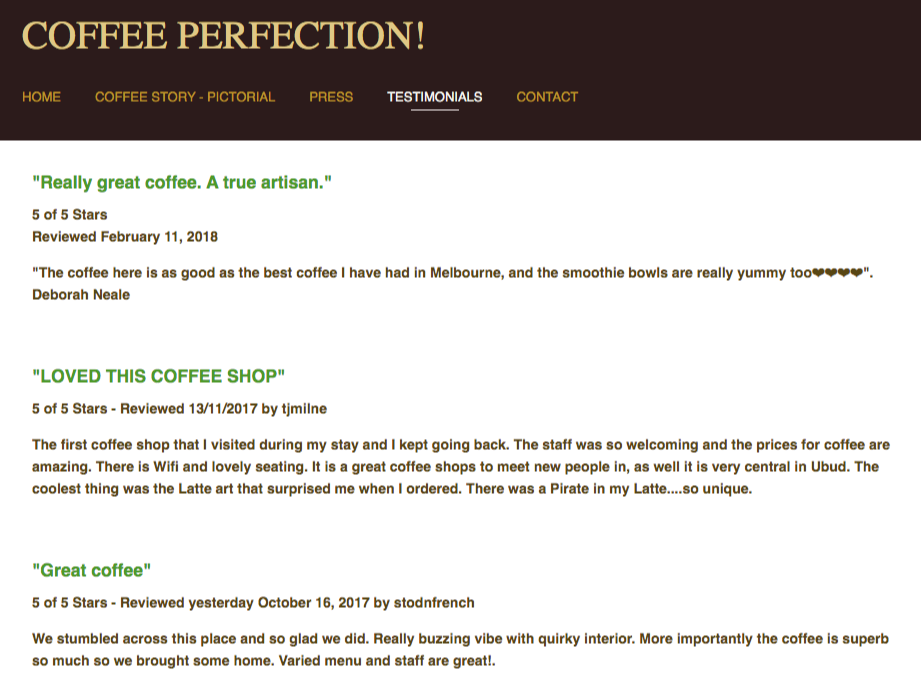
Pro tip: You can format the testimonial in a basic block of HTML, so your contact person can forward it straight to the web developer to implement the changes.
Testimonial link building is helping other local businesses grow through your words.
Then links become a by-product.
20. Publish Relevant Top X City Posts With Lead Generation In Mind
You see local content in most local business blogs.
It's for traffic — they say.
So, for example, publishing a "Top X city" article helps drive people from your target location.
Nothing bad here.
But what if you want, as a local business, not just traffic but also potential customers?
Here's the thing:
You can get both.
Traffic and leads.
So whenever you publish local content, think of lead generation.
Will this content I will create drive traffic and potential customers to my local business?
So instead of just creating content like:
- Top 10 things you should know about in [city]
- Best [cuisine] spots in [city]
- 5 things to do in [city]

You create content that ties into your products or services.
Let's use local vets as our example.
People interested in pet care services would usually read content like:
- 10 pet-friendly restaurants in [city]
- Pet laws in [city] you don't know, but you should
- Dog-friendly hikes in [city] rated by a veterinarian
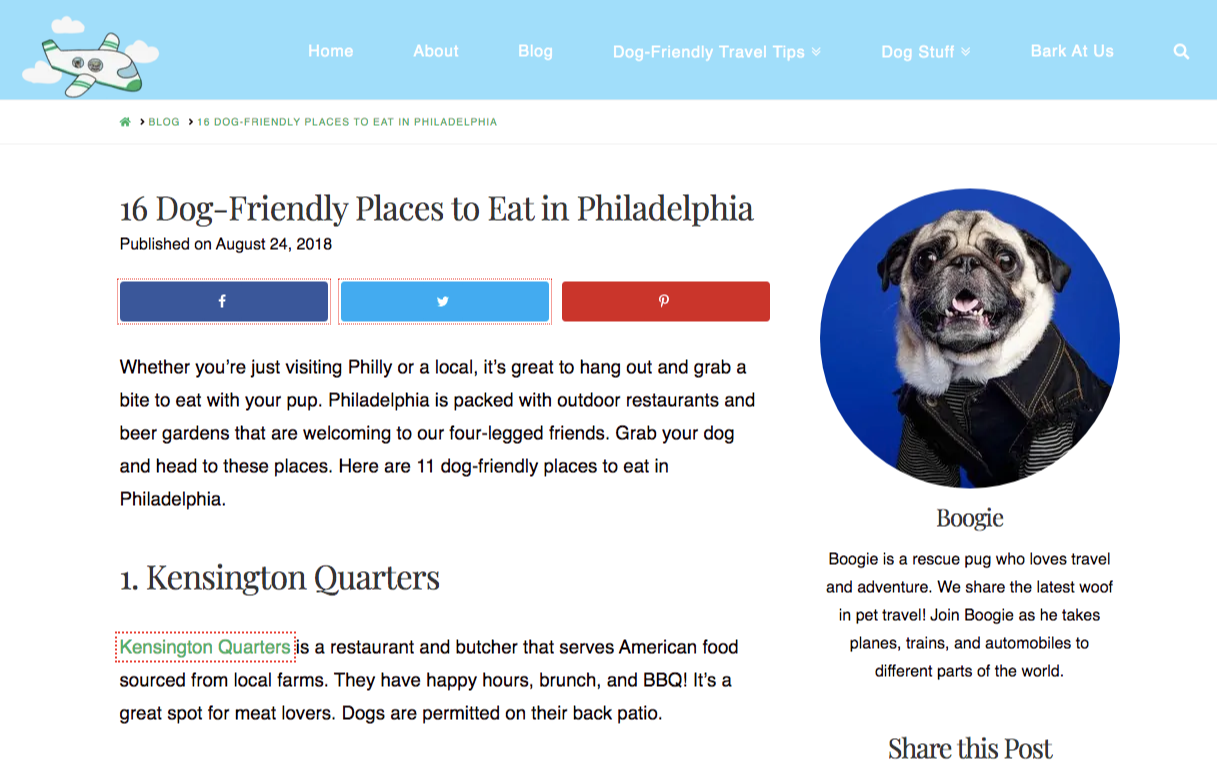
Did you get the idea?
So regardless of whether you publish it on your blog or distribute it elsewhere (i.e., guest posts), you're also thinking about how that local content can drive conversions to your local business.
21. Discover Local HOAs & Neighborhoods Using This One Search Operator
HOA - Homeowner's Association.
And neighborhoods.
You won't find much of this in every city.
But consider this as one of your link building techniques.
If your local business engages physically with local town members of associations, you can benefit from this.
How can you find link opportunities from HOAs and neighborhoods?
You need to use a search function that gives you the results of a specific page.
Take a look at this search query.
"homeowners association" "florida" inurl:links.html
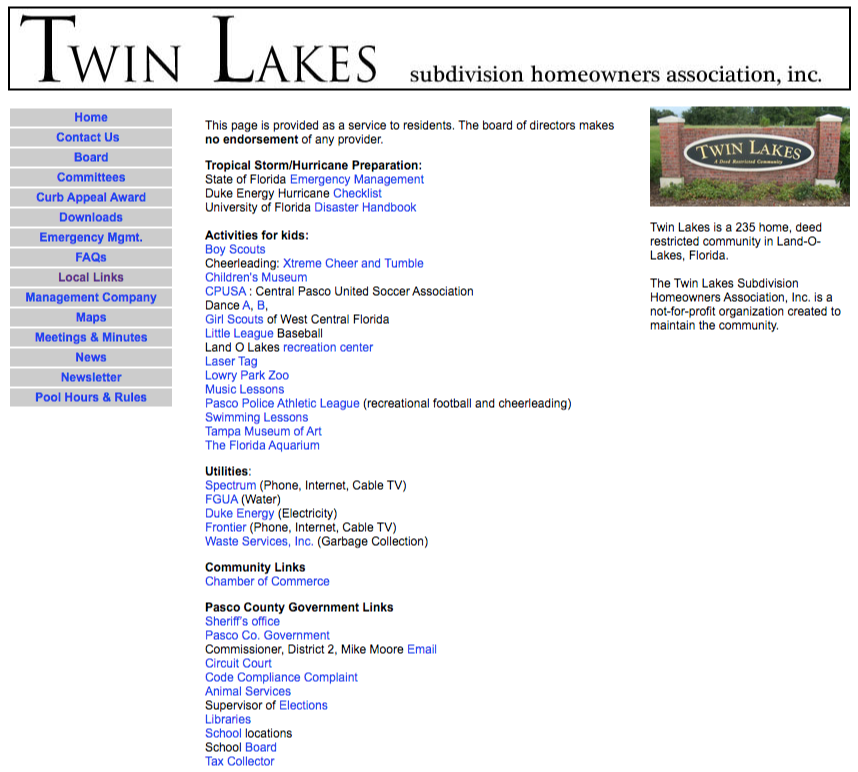
At the time of this writing, it will show links pages (in other terms, resource pages) for homeowners in New York.
You’ll have to look for links/resource pages and not just any type of page because you want to know if they have a history of linking to external resources or businesses.
So try it out for your target location.
See if there are any HOAs and neighborhood sites you can discover.
Then check if they have links/resources pages you can get listed in. Or better yet, start the search using "[city]" "homeowners" links.html
22. Build A Useful Tool For Local and Niche-Targeted Entities
One way to drive high authority links is by creating a helpful tool for your audience.
For example, Shopify created a business name generator that generated 1.9K+ in referring domains and $500K+ in traffic value.

The cost of creating tools depends on the complexity of the functions.
But what about local businesses?
Brainstorm an idea where a tool is needed.
It doesn't have to be specific to the niche you're in.
We are looking at the relevance of local links for this matter — as this is what we're aiming for.
Are there any tasks or projects other businesses in your location need that you can create and generate links from it?
23. Approach Journalists With a Local Angle Of Content
Could you get journalists to cover your local business story?
The answer is yes.
But what makes journalists tick when accepting stories from businesses?
It's the angle and hook of your stories.
If you've published a content piece (news, story, data, etc..) that has worked for the national press, start thinking about how you can tweak it for local media attention.
Perhaps, you can add rankings (top 5 cities or any location thereof) to your interactive world map to get that local business angle.
So if you're looking for excellent links from local publications, always think about how to pitch local journalists with a local angle of your story, data, or any content piece.
24. Acquire Donation Links From Decent Authoritative Local Organizations
Donation isn't a new thing in local link building.
Most local businesses with enough resources invest in donations to scale links quickly in the first months of a link building campaign.
How to start with donation link building?
Check your resources and determine your estimated budget for this link building project.
Typically, a decent donation link can cost around $500~. Some links from organizations can have lower pricing for the $200 range — but you'd have to check if it's worth the site’s quality.
Find local organizations using two metrics:
Relevance.
The sites should be locally relevant and potentially drive potential customers to your website.
So if you're a veterinarian in Philadelphia, try to find local pet clubs, health organizations, etc.

You can also go far from niche targeting and check from just a local standpoint.
From a recent vet example, donating to small software projects isn't bad (as long as it's still in Philadelphia).
The second metric is decent authority.
You can use Ahrefs' DR (Domain Rating) to measure the website’s authority.
Try to look for sites with DR40+.
If you don't have time for this type of link building strategy, you can hire agencies that do solely — local sponsorship marketing.
One good example is Zipsprout, founded by Garett French.
So, you can get sponsor links DIY or hire a sponsorship service like Zipsprout.
25. Use Local Linkbait Strategy To Get More Targeted Traffic
Linkbait is a type of content that gets natural links.
It benefits your local business as you create a 'flywheel' effect.
Where you publish a few comprehensive linkbait contents, and these handfuls of posts repeatedly hand you new backlinks over time, it becomes a natural link acquisition system for your brand.
In local link building:
There is one local linkbait strategy that you can use.
Here is how it works:
Step 1: Think of a topic that will bait local businesses to be featured on a list.
For example, if you pitch "Best 15 Coffee Shops in Philadelphia" to an owner of a local coffee shop, it's a no-brainer the person would help with the content promotion.
Step 2: List all potential local businesses you'll partner with for the blog post.
Step 3: Reach out to these people and let them know you are about to publish an article.
The pitch value here is that they'll be featured in an article that will attract new leads for their local business.
Plus, it would also have more visibility for their brand and possible website links.
Pro tip: If you've got a solid base of social media followers, include it as part of your value pitch, "We could share the blog article across XXX followers.”
Step 4: Publish your "Top/Best X in [City]" post.
Step 5: Send the link to the blog post to your partner local businesses.
Expect local backlinks from those business blogs and other websites.
26. Write New Segment For Link Insertions
Outreach is one of the crucial phases of a link building campaign.
You connect to your target linkers with your email pitch.
That's the reason why:
If you write an email that speaks to your linkers' needs, you can persuade them to link to you.
How will that happen?
You encourage the outcome that you want in your initial email.
For example:
In most link insertions and outreach campaigns, you contact bloggers or publishers to include a link to your content from one of their existing articles.
This is commonly known as "niche edits.”
The way to encourage the outcome here is to write the passage with the link in the same format, existing voice, and style as the article.
This offloads the work on the part of the blogger.
The good thing here:
You help these publishers to copy-paste the new segment out of your email simply.
What's the added value?
The easier for them to place your link somewhere on their articles, the more likely you'll get the link.
27. Create Your Own Link Building Playbook
Here's one thing about scaling backlinks:
You need processes to do that.
One tip here is to create your link building playbook.
This is where you'll input all the necessary details about your link building campaign.
The playbook includes:
Backlink profile data:
Questionnaire:
Order of priorities (for link building strategies):
Procedure documents:
Reports:
Link building playbook helps you scale your link building team.
Got a new hire?
You hand it over to the playbook. Let them learn what's inside.
The more you develop your playbook, the more you increase the efficiency and effectiveness of your campaign.
Here’s The Next Step…
Which of the 27 local link building tactics will you execute for your campaign?
Will you build backlinks from alumni directories? How about publishing relevant top X city posts to generate leads for local businesses in local link building?
Either way, let me know by leaving a comment below right now.
FAQs: Learn More About Link Building for Local SEO
1. What is link building for local SEO?
Link building for local SEO involves acquiring backlinks from websites, directories, and online platforms within a specific geographic area. These links connect your website to other trusted local sources, signaling relevance and authority to search engines. The goal is to improve your visibility in local search results and attract customers from your community or target location.
2. Why is link building important for local SEO?
Link building is crucial for local SEO because it strengthens your website’s credibility and relevance for local search terms. Search engines view backlinks from local sources as endorsements, making your website more likely to appear in searches conducted by nearby users. For example, a restaurant with backlinks from local food blogs and directories will rank higher for “best restaurants near me” searches.
3. How do local links differ from regular backlinks?
Local links come from geographically relevant sources to your business, such as local news outlets, business directories, or community websites. These links have a direct impact on your rankings in location-specific search results. Regular backlinks, while valuable, do not provide the same localized relevance and may not help improve your visibility in searches targeting your specific area.
4. What types of websites are good sources for local links?
Ideal sources for local links include:
- Local News Websites: Articles or mentions on local news platforms increase credibility and visibility.
- Business Directories: Listings on platforms like Yelp, TripAdvisor, or local directories help boost rankings.
- Community Blogs: Collaborations with bloggers focusing on your city or region can generate valuable backlinks.
- Chambers of Commerce: Membership listings and links from local business organizations establish authority.
- Nonprofits and Events: Sponsoring local charities, events, or fundraisers can lead to mentions and backlinks from their websites.
5. How do you build links for local SEO?
We use proven strategies to build high-quality local links, such as:
- Directory Submissions: Listing your business on reputable local and industry-specific directories.
- Sponsorships: Partnering with local events or organizations to earn mentions and backlinks.
- Content Marketing: Creating locally-focused content, such as guides, blogs, or videos, to attract backlinks from regional sources.
- Press Releases: Distributing press releases to local news outlets to gain coverage and links.
- Outreach: Building relationships with local bloggers, influencers, and businesses to secure partnerships or guest posts.
6. Are citations considered a part of link building?
Yes, citations are an essential aspect of link building for local SEO. Citations include your business name, address, and phone number (NAP) on other websites, such as directories or review platforms. When these citations include backlinks, they become even more valuable by driving traffic and increasing your local search authority.
7. How does link building help my Google Business Profile?
Link building enhances your Google Business Profile by boosting your website’s authority, which helps your business appear more prominently in Google’s local 3-pack (top three map results). Backlinks from trusted local sources strengthen your overall SEO and drive more traffic to both your website and Google Business listing.
8. How do backlinks improve rankings in Google Maps?
Backlinks improve Google Maps rankings by signaling to Google that your website is trustworthy and relevant for local searches. When combined with other factors, such as accurate NAP information and positive reviews, backlinks from local websites increase your chances of ranking higher in Google Maps for searches like “plumber near me” or “coffee shop in [city].”
9. How long does it take to see results from local link building?
Results from local link building typically appear within 3 to 6 months, depending on factors such as competition, the number of links built, and the strength of your current SEO. The process requires consistency and quality-focused efforts. While some improvements may be visible sooner, achieving sustained success takes time and continuous optimization.
10. What are some examples of content that attract local backlinks?
Creating localized content is a powerful way to earn backlinks from nearby sources. Examples include:
- Local Guides: Write about “Top Attractions in [City]” or “Best Restaurants in [Neighborhood].”
- Event Coverage: Create content about local festivals, fairs, or charity events.
- Customer Success Stories: Share case studies or testimonials from local customers.
- Resource Lists: Publish lists like “Top Resources for Homebuyers in [City].”
- Community Spotlights: Highlight partnerships with local businesses or nonprofits.
This type of content engages local audiences and naturally attracts backlinks from community websites and organizations.
11. Are all local backlinks beneficial for SEO?
Not all backlinks are beneficial. High-quality backlinks from trusted local sources improve your SEO and drive relevant traffic to your website. However, backlinks from spammy or low-authority sites can harm your rankings. We prioritize earning backlinks from reputable sources, ensuring that they positively impact your local SEO performance.
12. Can local link building work for service-based businesses?
Yes, local link building is especially effective for service-based businesses like plumbers, electricians, real estate agents, and healthcare providers. By earning backlinks from local directories, community blogs, and industry associations, service-based businesses can increase their visibility among nearby customers actively searching for their services.
13. Do reviews count as part of local link building?
While reviews are not backlinks, they are a critical part of local SEO. Reviews on platforms like Google, Yelp, and industry-specific sites improve local visibility and establish trust with potential customers. Positive reviews also increase the likelihood of earning backlinks when bloggers or websites mention your business.
14. Is link building for local SEO different from traditional link building?
Yes, link building for local SEO focuses on geographic relevance. The goal is to earn backlinks from sources that are local to your area or connected to your community. Traditional link building may target high-authority domains without regard for location, which may not help improve rankings for location-specific searches. Local link building ensures your business stands out in regional searches.
How to Use Ahrefs For Link Building (Like A Pro)
In this new guide, you'll learn how to use Ahrefs for link building.
Even without experience using the SEO tool.
Even if you've been using Ahrefs for quite a while.
(I'll include lots of advanced strategies that I've never shared anywhere before).
Here's everything you'll discover in this guide:
Let's dive right in.
What is Ahrefs SEO Tool?
Ahrefs is a robust tool that can be used to perform backlink audits, conduct keyword research, analyze competitors, track organic visibility and find and quality link prospects.
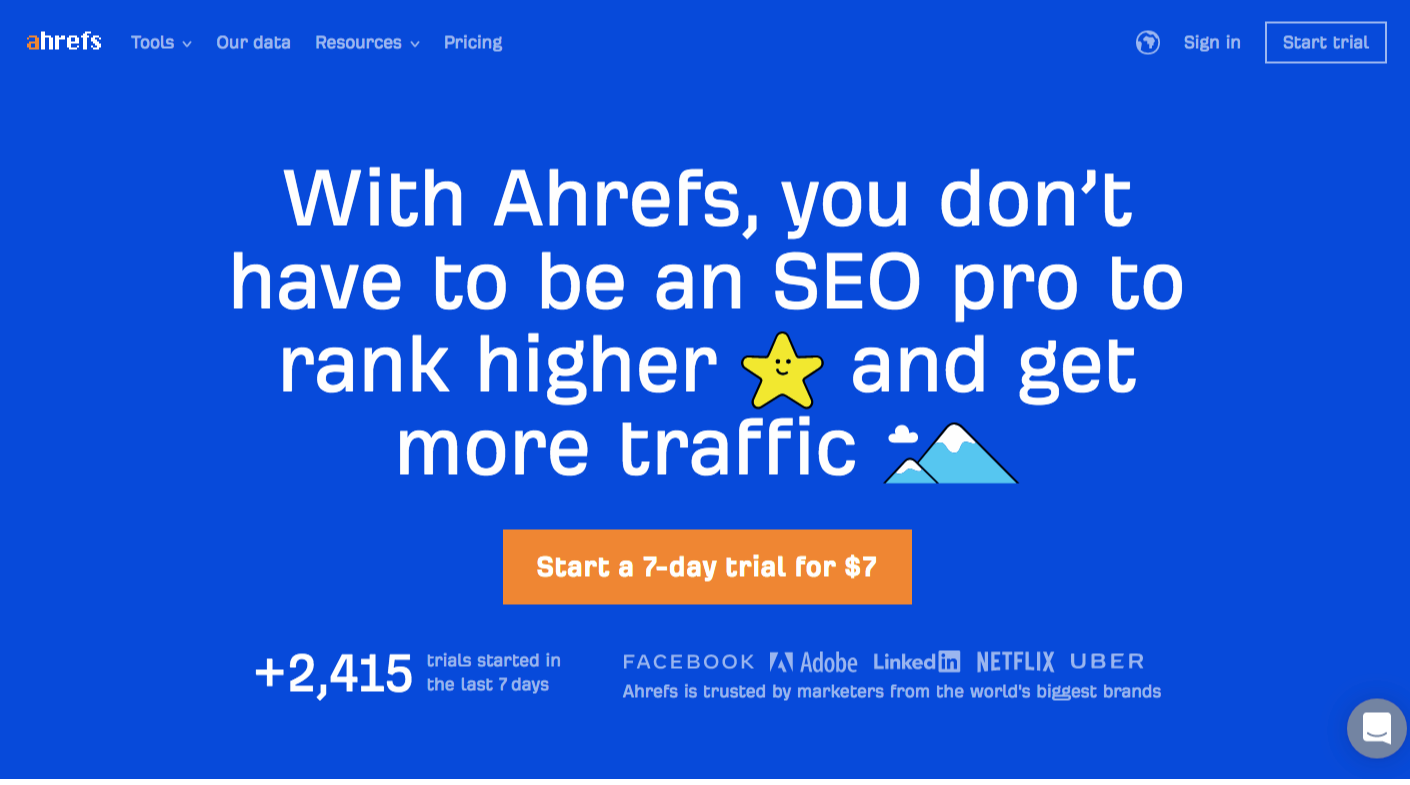
For this guide, we'll focus on activities related to link building.
If you don't what link building is, start first by reading this beginner's link building guide.
How to Find Backlink Prospects Using Ahrefs Link Explorer
Every link building campaign starts with finding websites that can potentially link to your business.
When finding link prospects, you can use Google and advanced search operators to discover blogs and websites to look after for links.
You'll surely discover hundreds of websites following this process.
But if you're looking for a scalable way of link prospecting:
You use Ahrefs.
Ahrefs has a Link Explorer feature to help you find websites linking to the URL or domain you've entered.

The URL you will enter can be a competitor of your business.
Since you'll enter a relevant competitor, you also find backlink prospects that are relevant to your business.

You'll then see a bunch of websites linking to your competitor's website. This could be your possible backlink prospects for your business.
That's how simple it is.
You do this to every website of your competitors. And you'll find thousands, if not hundreds of link opportunities (e.g. guest posts).
Now, if you lack ideas of who your competitors are.
You go to one feature of Ahrefs: competing domains.
Click "Competing domains".

You'll see all websites competing with your business.
Going back.
If you want to get all the backlink opportunities (websites linking to your competitor's website), click Export in the Backlinks feature.
How to Find Guest Blogging Opportunities Using Ahrefs
Guest blogging is the practice of contributing a content piece to another blog, whether that piece is an article, visual assets like an infographic, video, or any other content format. And get backlinks in return for that value.
Here's how to find guest blogging prospects using Ahrefs.
Enter a keyword in Content Explorer.

Add a filter for Domain Rating and toggle to see only "One page per domain".
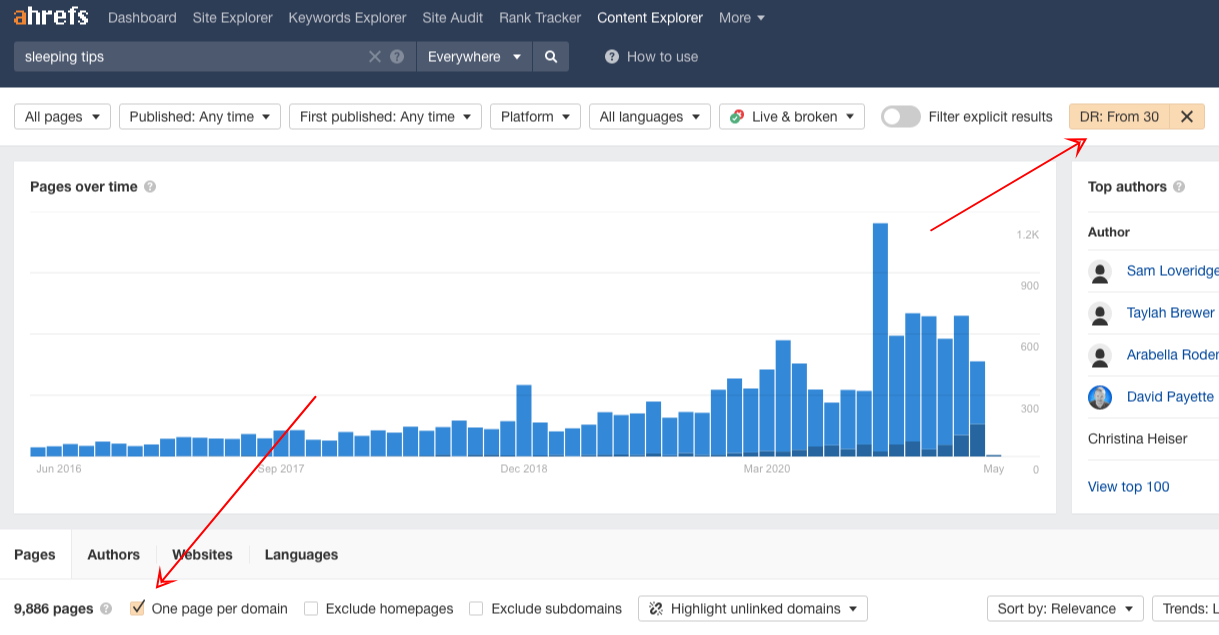
Use the "highlight unlinked domains" function to highlight results from websites that haven't linked to you before.
Now, that gives you a list of blogs you can consider as guest blogging prospects.
How to Find Unlinked Mentions Of Your Brand Using Ahrefs
Not all websites that mentioned your brand would link to you. Some will do, others do not.
But for those who didn't link to you, what you can do is reach out to them and ask to link back.
Given that they've mentioned you, you have leverage for links by simply asking them.
So, how do you find these "unlinked mentions"?
Search your brand name in Content Explorer.

Click the "highlight unlinked domains" button. And enter your domain.

Then, you'll see websites that mentioned your brand on one of their pages.
You can check out this guide on link reclamation to know how to qualify these brand mention pages and reach out to them effectively to acquire links to your site.
How to Find Podcast Opportunities Using Ahrefs
Podcasts are everywhere.
In your industry, there are podcasts you can get interviewed in, to bring your message out there to your target audience.
Using Ahrefs, you can find these podcast backlinks opportunities.
Find a thought leader or someone who've been guested on many podcast in your industry. This will be your starting point.
Look for his website and enter it into Ahrefs' Site Explorer. Go to the Backlinks report and search for their name.

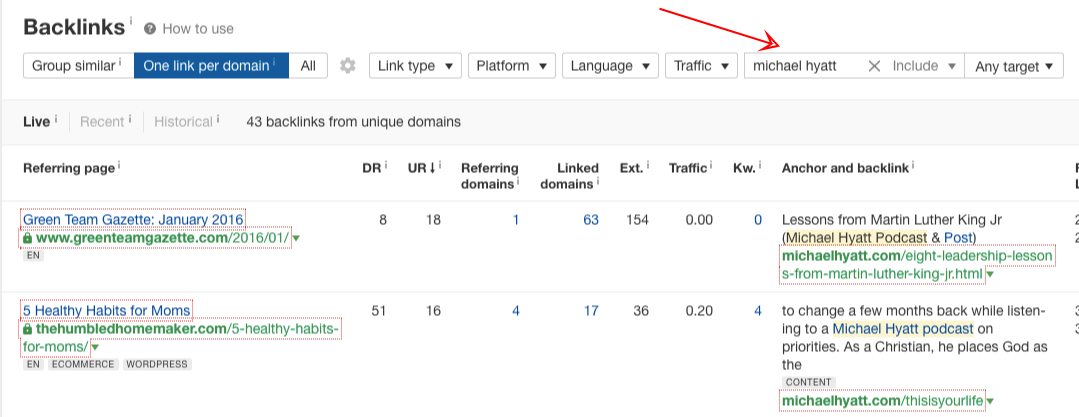
This will give you websites where the person has appeared on.
You can learn more about this from this guide on getting podcast link opportunities.
How to Find Broken LInk Opportunities Using Ahrefs
Deadrot is something link builders can take advantage of.
Broken links on other websites are link building opportunities for your website.
Using Ahrefs, you can discover these broken links.
There are two approaches you can apply here.
First is by entering a competing website into Ahrefs' Site Explorer.
Then go to "Best By Links" and filter for "404 not found".
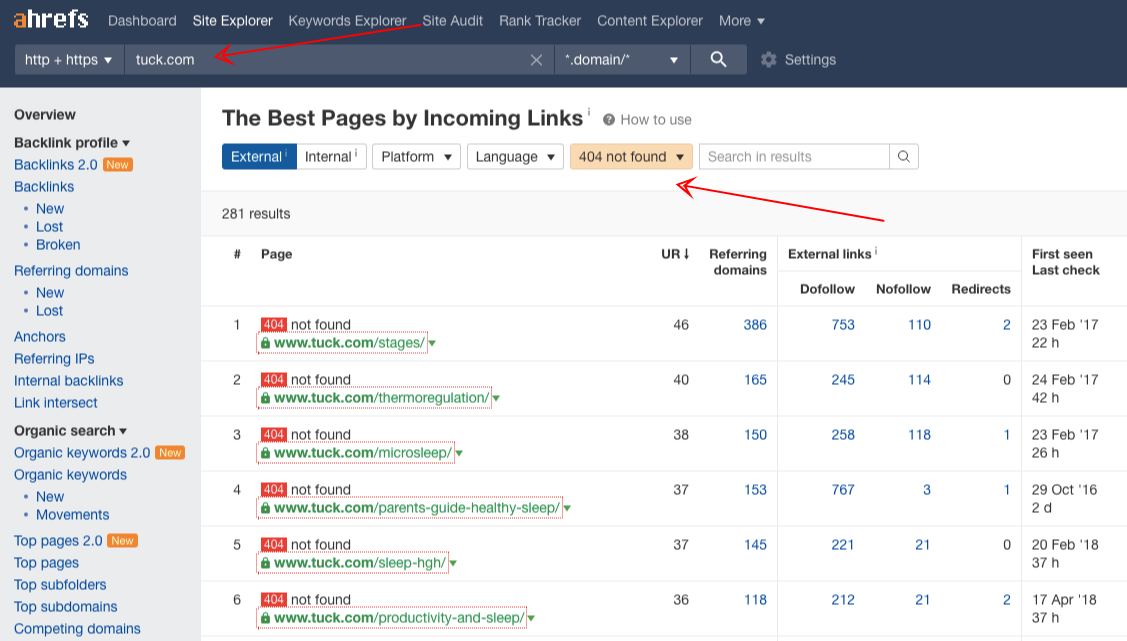
Find any pages that linked to the 404 page by plugging it into Ahrefs' Site Explorer.
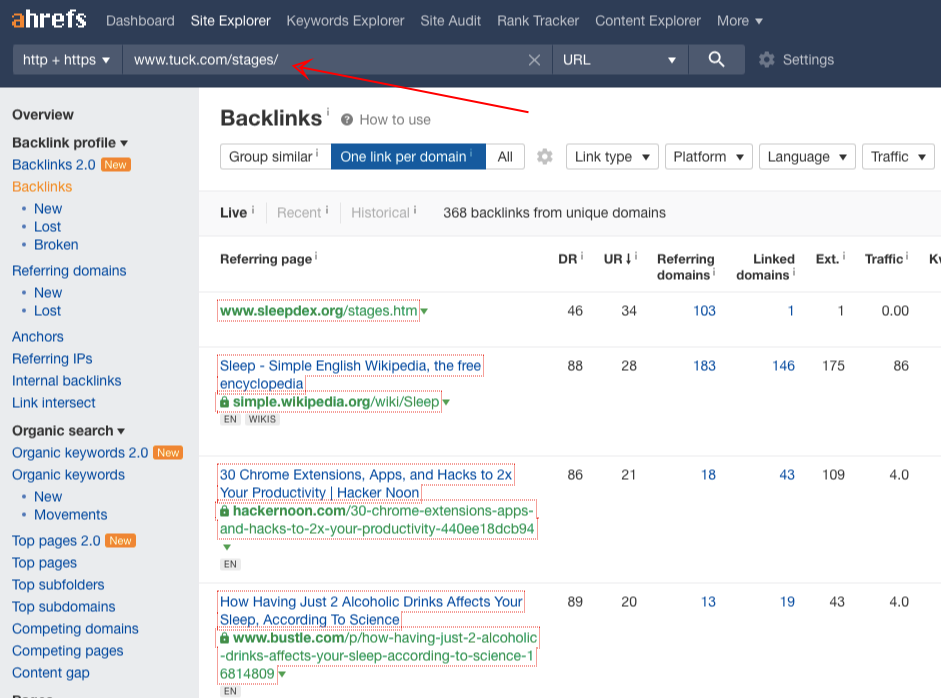
These will surface you link opportunities you can reach out, and offer your resource as a replacement to their broken link.
Another way to find broken link building opportunities is by using Ahrefs' Content Explorer.
Enter a topic or keyword.
Then filter for "Only broken".
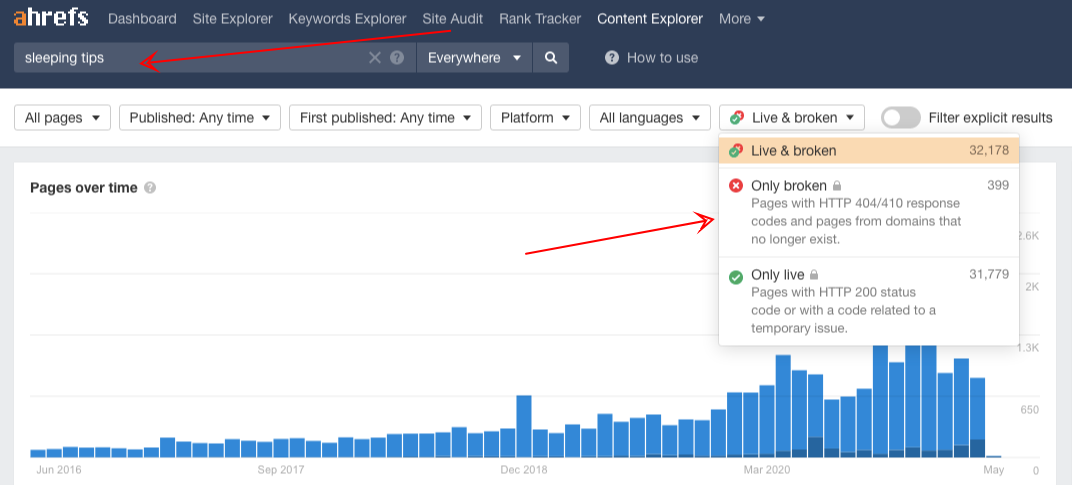
Set the filter for referring domains for a minimum of 50. This will give you linkable pages that you can recreate and publish on your website.

How to Prospect For Resource Page Link Targets Using Ahrefs
There are a lot of resource pages available on the web.
Use Ahrefs to find them.
Enter a relevant keyword into Content Explorer plus a search operator, "inurl:resources" to find only pages with resources on its title or content.

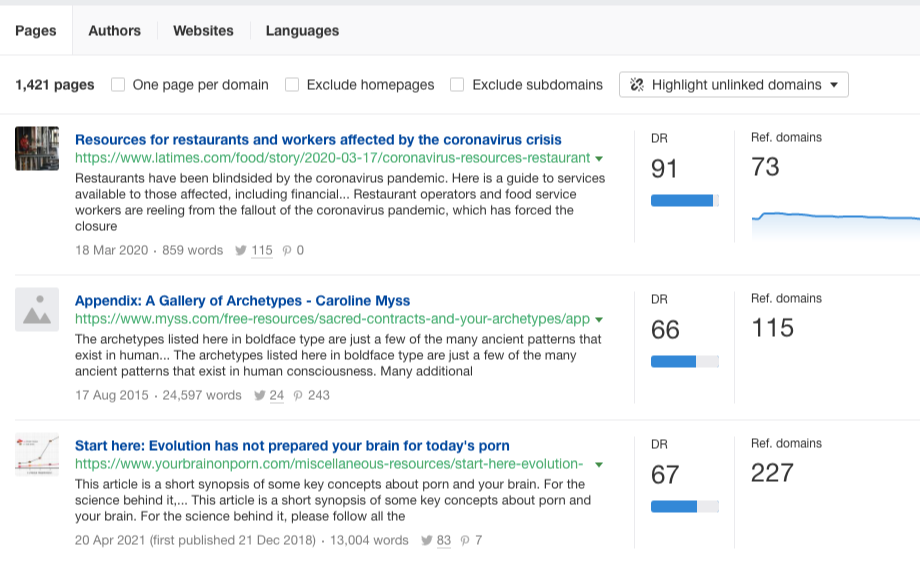
How to Discover Content Syndication Opportunities Using Ahrefs
Content syndication happens when a content is re-published by other third-party websites.
As the content is automatically being republished, it gets more visibility on other more web places.
How do you find these content syndication opportunities?
First thing to do is to find a website that gets syndicated regularly. You can also find an author, content creator, or blogger who gets his article republished elsewhere.
Ahrefs now has an author feature to help you discover authors in your space.
Simply type any keywords in Content Explorer. And go to the Authors tab.

Once you find an author who has a blog that gets syndicated. Paste the domain into Ahrefs' Site Explorer and go to the Backlinks report.
Search for "originally appeared on" in the "Include" box to filter the pages with titles, and content that includes that phrase.
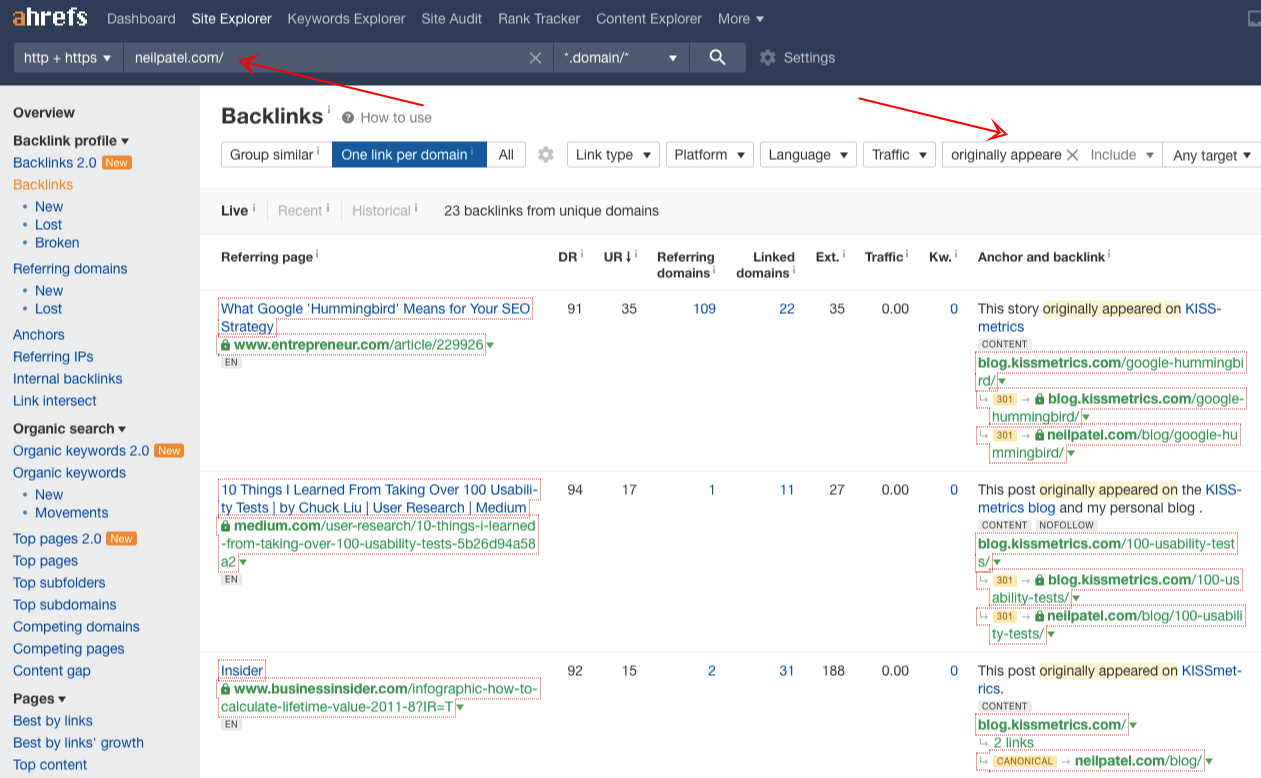
Now, these are content syndication opportunities you can leverage for links.
How to Find Industry Authors Using Ahrefs
When people use guest blogging, they opt to look for websites and blogs.
A more strategic way of doing this is to find industry authors.
There are many things you can do when you find them, either you hire these industry authors to create content for you and distribute third-party content on other niche blogs.
Or get these industry authors to promote content published on your website.
Now, how to find authors in your space using Ahrefs?
Go to Content Explorer.
Click on Authors tab.
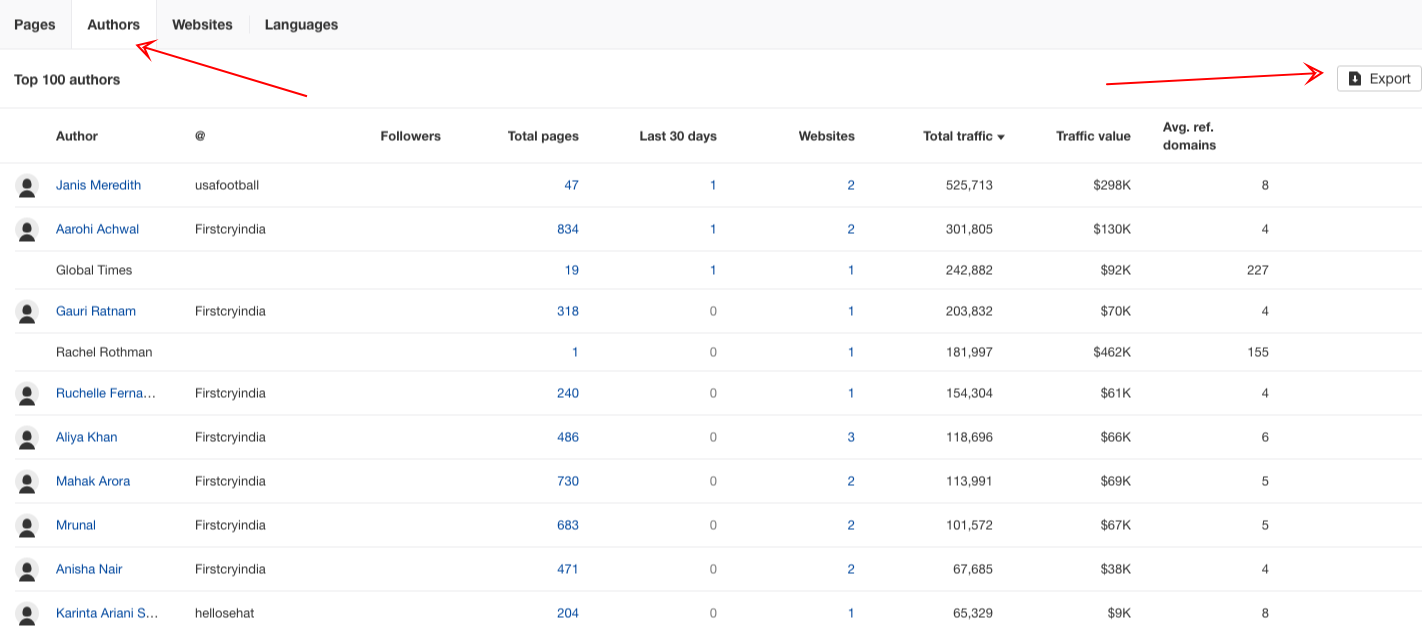
You can export the list to further assess each author.
You can then filter them by their number of followers, traffic value of their website, and average referring domains.
How to Monitor People Linking To Less-Deserved Content Using Ahrefs
Link building is a matter of giving value to a target audience.
If you can more value to linkerati, you get these people to link to you without hesitation.
If your ranking page isn't getting its deserved spot (not yet ranking number one), then either the competition for that keyword is too difficult, or your competititors' pages have more high-quality backlinks than you.
Besides making your content better to serve both search engines and search users, you would want to build more backlinks to your page.
You can reach out to people who linked to the top-ranking page.
A more strategic approach is to find any less-deserved content (people with lesser backlinks than the top-ranking page), but are getting continuously links from publishers.
Use Alerts feature of Ahrefs to send you alerts whenever people link to those pages.
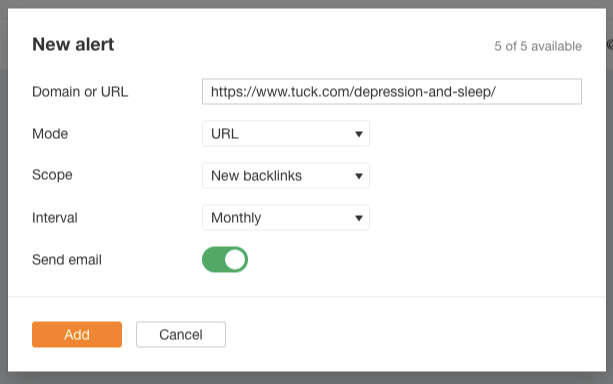
As soon as you receive alerts, check each of them and see if your content deserves more of getting the link than your competitor.
Whenever you find it relevant and more feasible for your content to get links, consider reaching out to the linker and share your content.
How to Find Fresh Outreach Prospects In Your Industry Using Ahrefs
You need to find an outreach angle when reaching out to potential linkers.
Whether that's an interest of the prospect you're tapping into, or as simple as describing your content from a unique angle.
One way to get more responses and link placements from your outreach campaign is to ping them about their most recent content piece.
Oftentimes, people reach out to bloggers about their old articles (most of the time, articles from years back).
Those bloggers obviously may or may not care about their old articles, unless they find it interesting to update them.
So you want to be looking for people who've recently just published their content.
Why is the case?
These are people who are more receptive to suggestions as they're in the positive mode of receiving feedback for their recent content. So that means you have a higher likelihood of receiving responses from them.
How to find fresh outreach prospects in your industry?
Enter a relevant topic (a topic of your content) in Ahrefs' Content Explorer.
Set filter for "Published last 90 days". Then, set a minimum "Website Traffic" from 1K, and "Domain Rating" of 60-90.
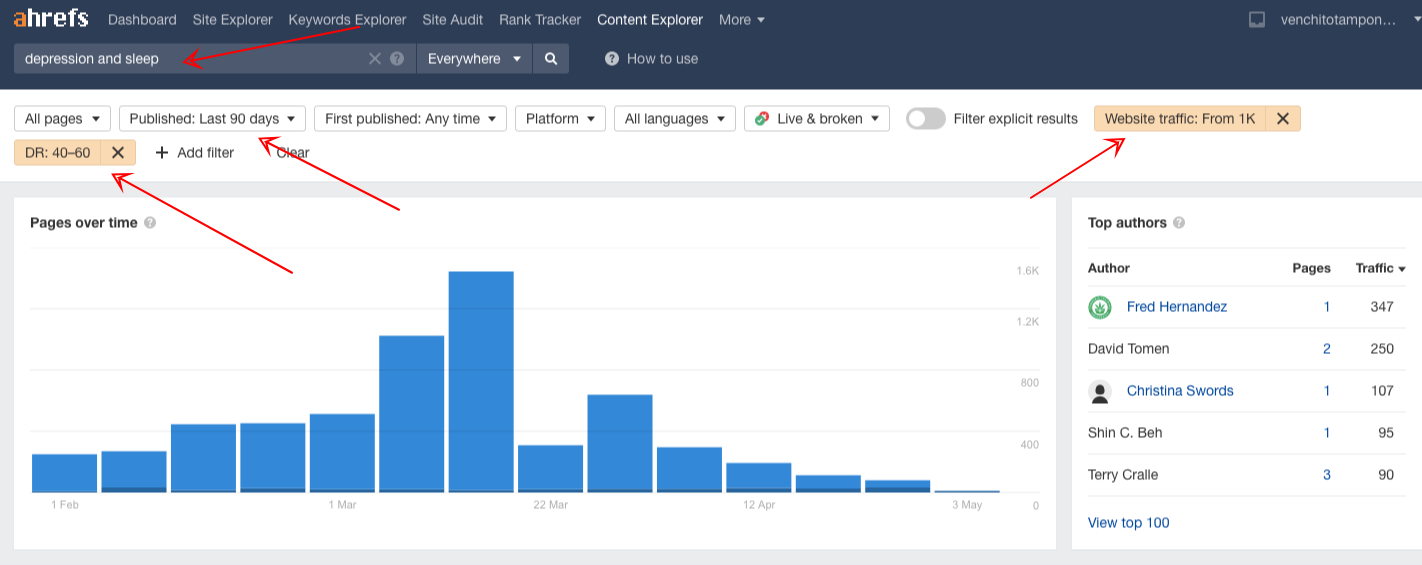
Check "Exclude Homepage" to avoid seeing multiple pages from the same website.
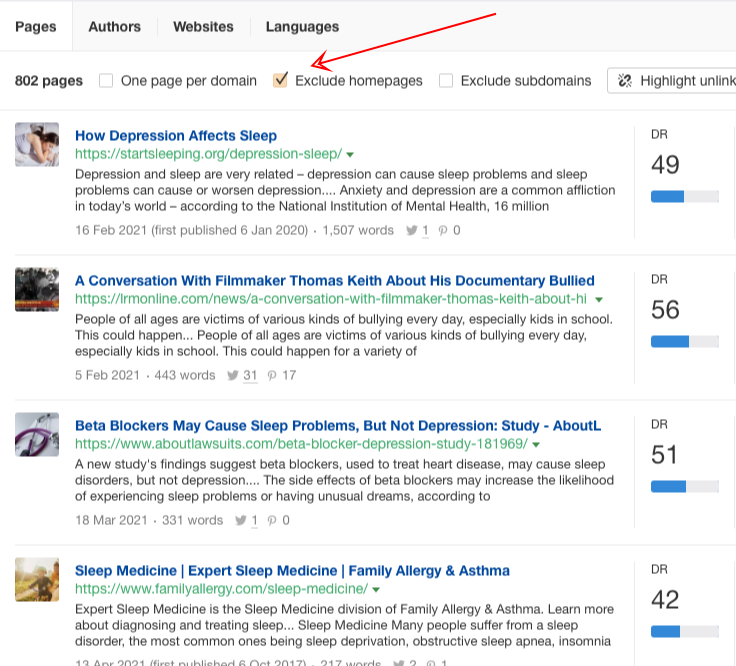
These are fresh outreach prospects in your industry that you can reach out to for content promotion.
How to Discover Link Targets With Potential To Bring Referral Traffic
One of the best types of links is links that can generate referral traffic to your website.
Not only you'll get the benefit of link juice from a relevant website to help you rank in search, but you'll also receive relevant traffic who can be your potential customers.
Now, how would you be able to find these link targets?
Enter a relevant topic on Ahrefs' Content Explorer to see pages that mention your topic.
Then set the minimum search traffic filter to 500.

Export the list and consider them as your link prospects.
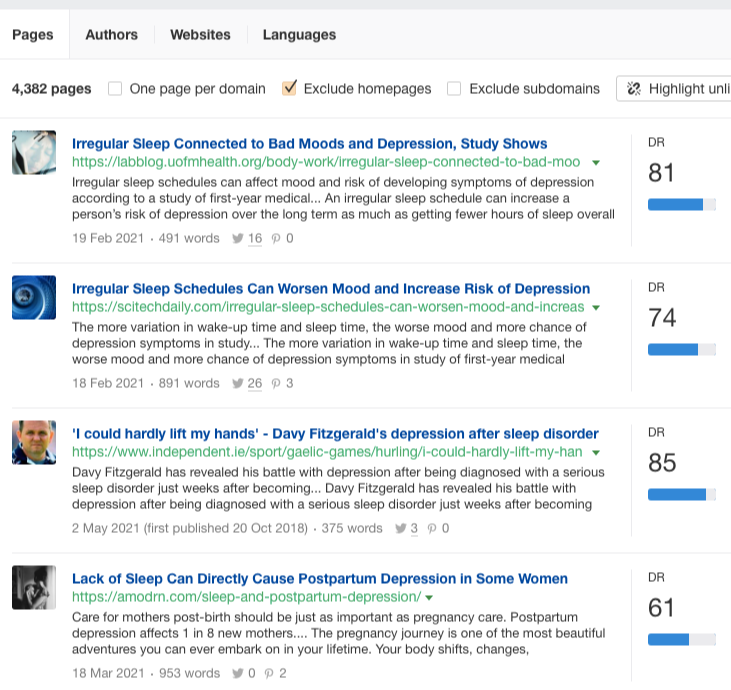
How to Qualify Backlink Opportunities Using Ahrefs
Not all backlink opportunities are relevant to your business.
Not every website is worth pursuing.
That's the reason why you have to qualify sites or specific pages before you reach out to people who own them.
Link qualification helps you to maximize your resources and efforts in link building.
The better you qualify, the less time you spend reaching out to websites with no relevance and business value to your site.
What are some criteria to consider when qualifying backlink opportunities?
First is contextual relevance.
Check the website and see for yourself if the website is topically relevant to your business.
Let's say you're looking for a guest blogging opportunity in the personal injury space.
The most relevant opportunities are personal injury blogs.
If you sell beauty products, your most relevant backlink opportunities are beauty blogs, lifestyle blogs, and mommy blogs (with topics on beauty for mommies).
Second thing you should be looking at is: Authority
This is where Ahrefs comes in.
Ahrefs has an authority metric, called Domain Rating (DR) and URL Rating (UR) that shows you how authoritative a website is (measured on a scale from 0 to 100).

There are two things you can do when qualifying backlink opportunities using Ahrefs:
Manual approach and Ahrefs' Batch Analysis feature.
You can qualify websites manually. Go to the website. Click on Ahrefs tool button (make sure you install it on your Google Chrome Extension).
Or do it using Batch Analysis.
Collect all URLs of your backlink opportunities.
Copy and paste them in the Batch Analysis box. You can enter up to 200 URLs.
Let's say I'm going after guest blogging opportunities, what I'll be pasting in the box are all websites I'm going after for guest blogging.
After pasting all these URLs, click the dropdown and choose "domain with all its subdomains" option.
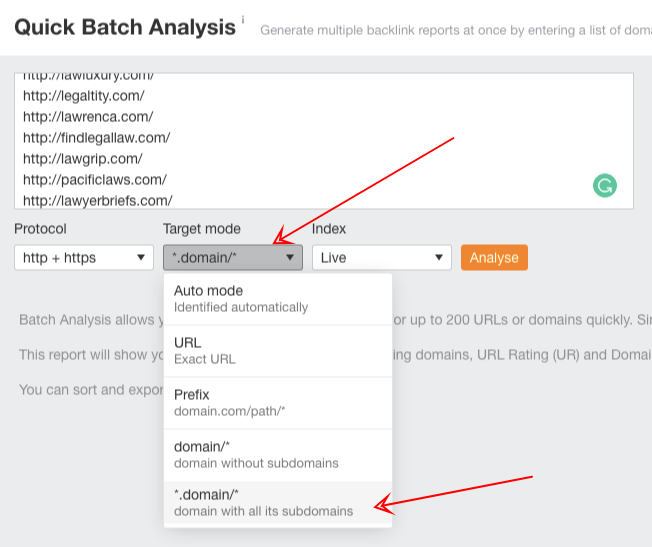
This is important if you want to qualify a backlink opportunity as a whole (not just as a single page).
Now then, you'll see a bunch of data you can use to assess whether a website is good or not.
Basic metrics you can look at from this Ahrefs data:
Organic Search (Traffic)
The monthly organic of the website from search. The higher this metric, the better opportunity because you know that it ranks for its target keywords in Google. This means that if you get backlinks from the website, it could bring visitors to your site through the link.
Ahrefs Ratings (DR)
The higher this metric is, the better. We recommend as a link building agency to have a benchmark of at least 30 (DR of 30 and above). Not too high, but not too low to see if there is enough authority on the website.
Referring Domains (Total)
The total number of unique domains linking to the target. The higher it is, the better. This means that there are other websites that have votes of confidence in your backlink opportunity.
There are a lot of other factors you have to consider when qualifying backlink opportunities, but what I've shared would be enough to help you start with link qualification.
How to Qualify Link Prospects Better Using Ahrefs
Besides using contextual relevance and authority metrics (like Ahrefs' Domain Rating), you can qualify link prospects in a more detailed way.
Using Ahrefs, you can check websites if they have been penalized.
While we don't have data to see if they have been hit by a penalty unless we got a direct access the website's Google Analytics.
However, there are clues when you assess further the website.
You can use Ahrefs to see the website's search organic trends or performance.
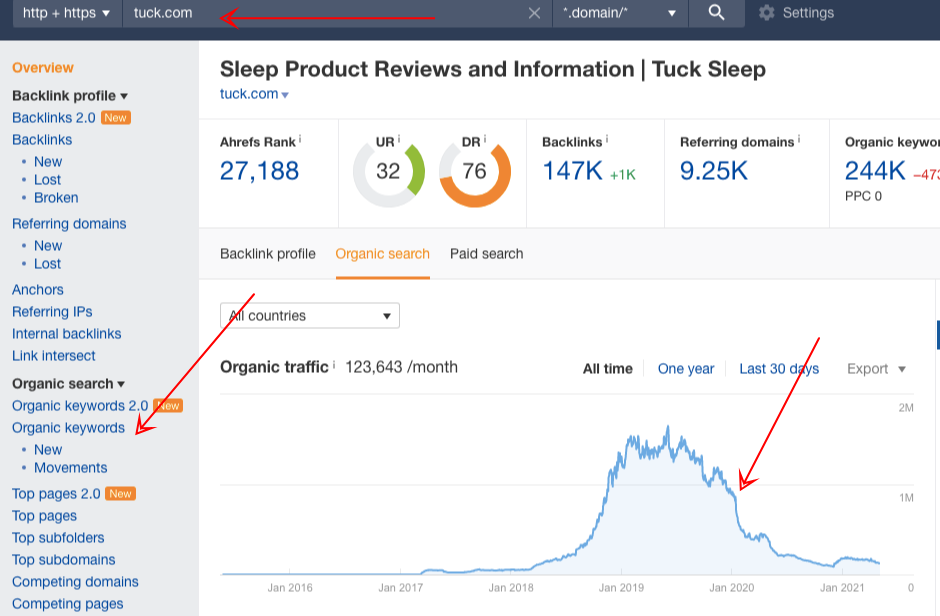
If you see drops in search traffic, you may want to investigate further.
You can't simply conclude the website has been penalized.
Look through the date where the drop began.
Check using Moz calendar of algorithm updates to see if there are any big updates on that date.
Remember that Google is constantly changing its algorithms to serve its search users better.
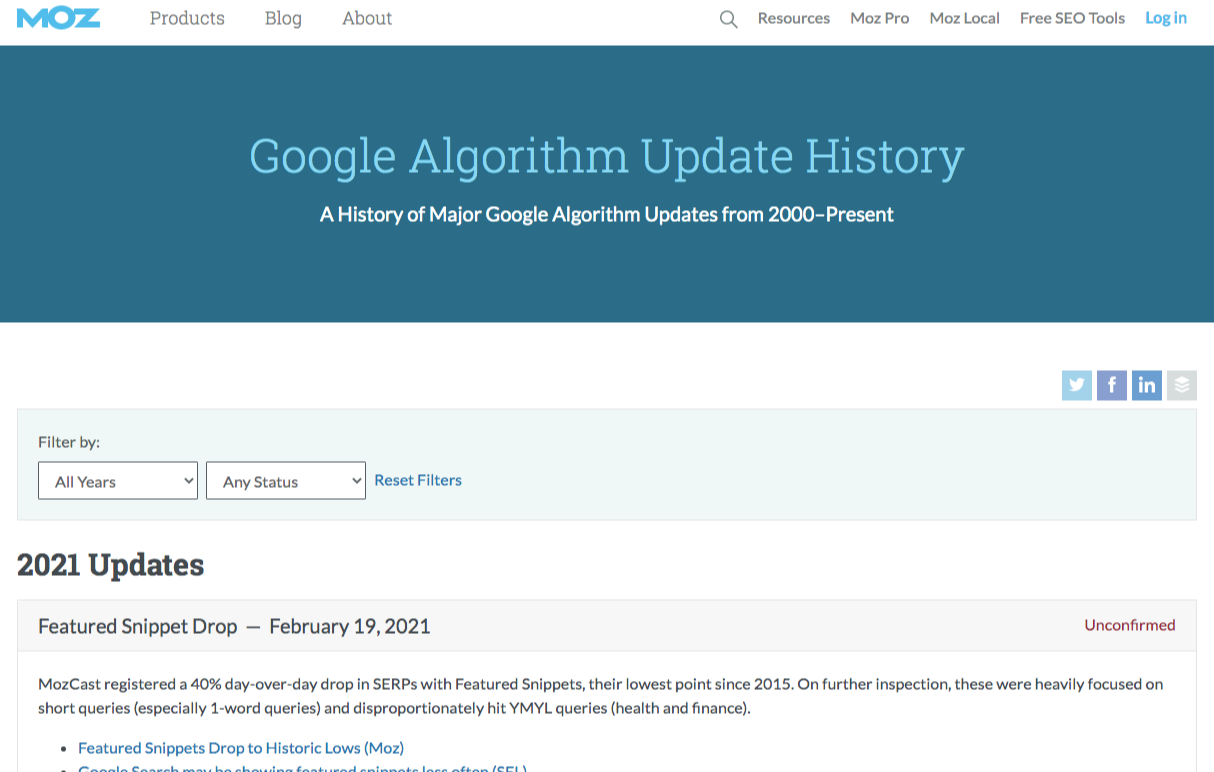
Another thing you need to check is if there are any website revisions during that date.
If there is a website redesign, it may have caused technical errors that led to a traffic drop. Use Wayback Machine and go through the date when you've seen the search drop-in Ahrefs.

One last thing:
Know the seasonality of the website's traffic. There are on and off seasons in certain markets. This means that if a website sells seasonal products, it's understandable the website will experience drops in its search performance.

How to Know If Your Outreach Prospect Has Linked To You Before?
In outreach, it is best if you can identify if your prospects have linked to you in the past.
There are two reasons for this:
First, you may reach out to them later, if you prefer to prioritize websites that haven't given you links yet.
Second, if you see that getting recurring backlinks from them benefits you, consider them as your current outreach prospects.
Now if you need to see if a website has linked to you before.
Enter the website of your outreach prospect in Ahrefs' Site Explorer.
Go to "Referring domains" report. And include your brand or website in the search bar.
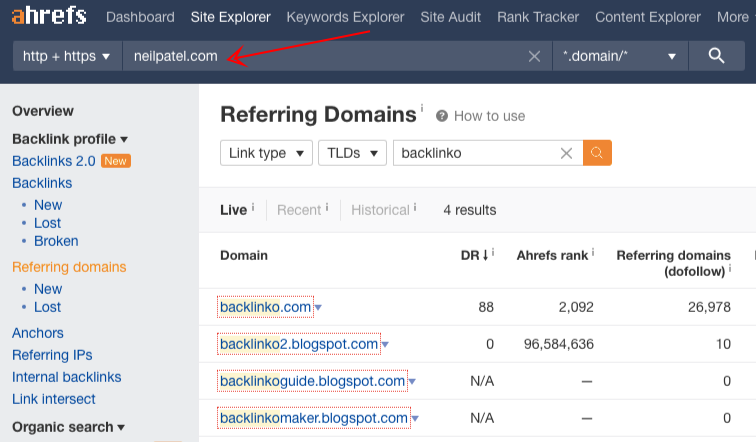
There you'll quickly find all the pages linking to your website or have mentioned you.
How to Discover Linkable Content Topics Using Ahrefs
One reason why people link to a website is they see content worth referencing on their pages.
So creating content that people would love linking to is a great way to increase backlinks to your website.
Content creation is not a requirement all the time. But if you want to scale link building, do it with a strategy.
Use Content Explorer feature of Ahrefs to find linkable topics in your industry.
Start by entering a keyword or phrase (your topic) to search for their database of over one billion web pages.
Your query matches what you choose in the dropdown options:

If you're starting out, it is best to choose "Everywhere" to let the tool explore more pages on the topic.
Go to the bottom section and "Sort by referring domains". This allows pages to sort from highest to lowest referring domains.
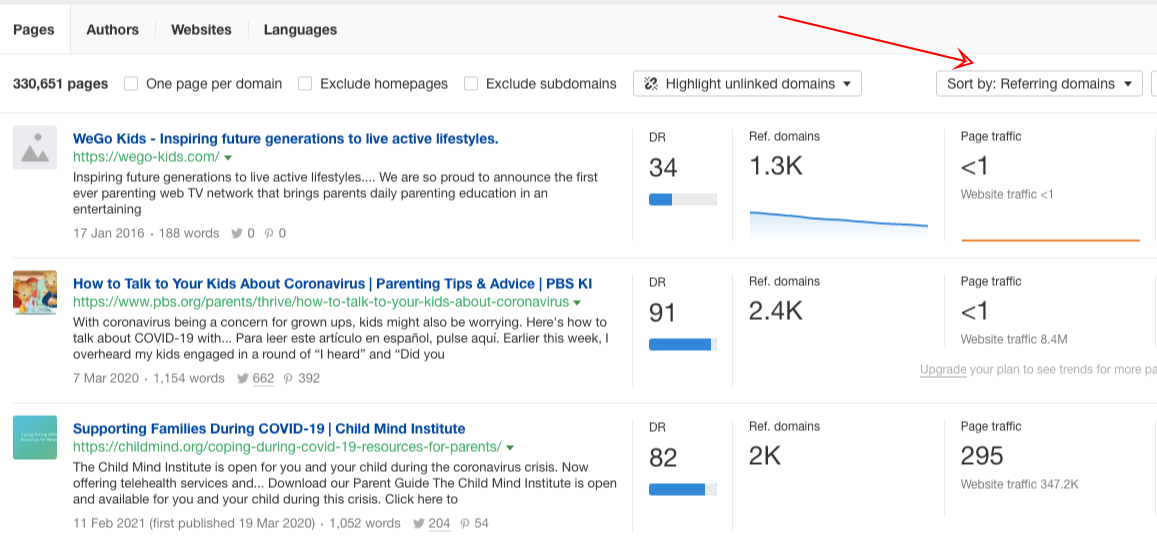
To say that a topic is linkable, a good count is at least 100 referring domains.
For other industries, you may not able to find more than the number, but you get the point.
You should be able to find topics with a good number of referring domains.
How to Find Skyscraper Content Opportunities Using Ahrefs
Skyscraper technique.
Creating a 10x content that's better, longer, and more comprehensive than other competing content on the topic.
It starts with finding what topics you can create yourself.
Use any of the three features of Ahrefs.
A. Ahrefs' Content Explorer
Enter a relevant topic into Ahrefs' Content Explorer.
Set the minimum 'Referring Domains' filter to 50, to give you websites.
You can add a language filter to get only pages in your target language.

Consider checking the Traffic Value of each page in the list, as it gives you an idea of the value of the topic and page related to your business.
B. Ahrefs' Site Explorer
Plug in the URL of an authoritative website (in your industry) into Ahrefs' Site Explorer.
Go to Best By Links section. Set the filter to "200 ok". And sort the list by Referring Domains.
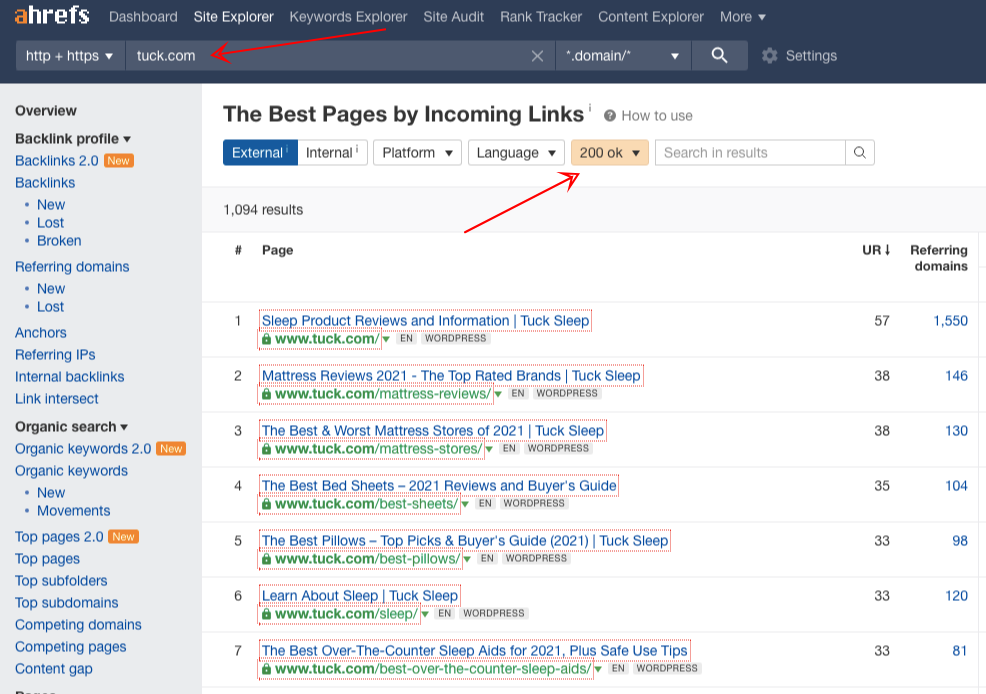
This will give you an idea of what topics are linkable in your industry based on the highest linkable pages of an industry website.
C. Ahrefs' Keyword Explorer
Enter a broad industry keyword into Ahrefs' Keyword Explorer.
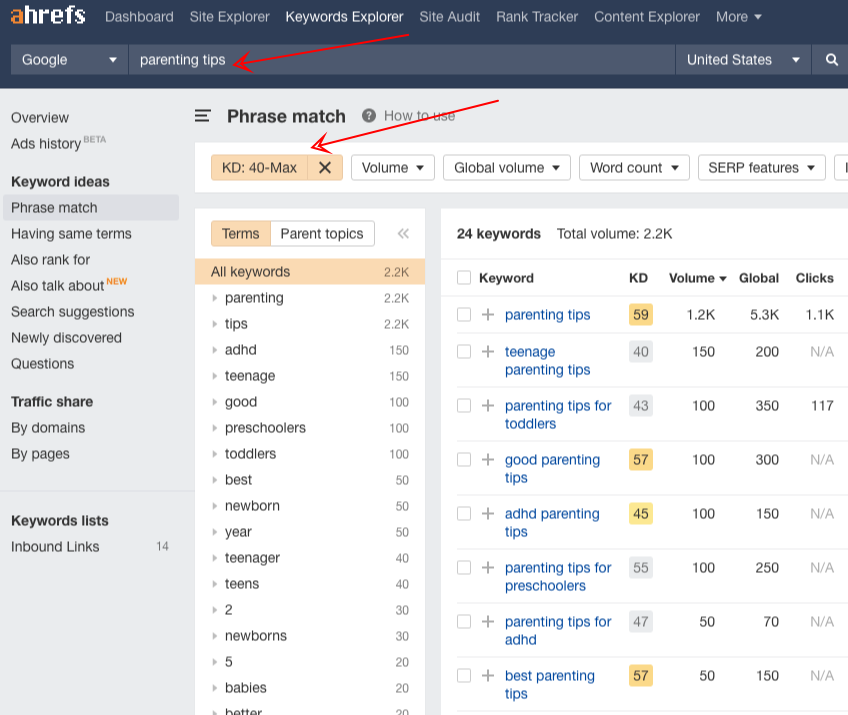
Set a minimum of Keyword Difficulty to ~40. Based on Ahrefs' calculation on KD, the top-ranking pages for high-KD keywords have lots of backlinks.
You can check ranking pages for each of the high-KD keywords. See if they have a good number of referring domains.
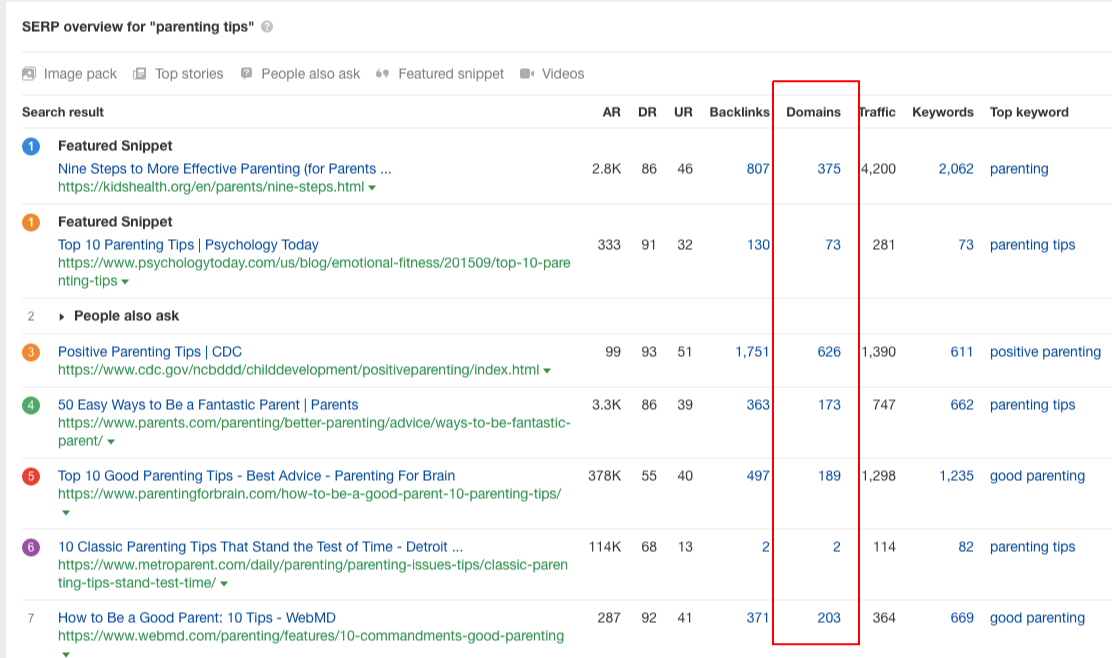
How to Look For "Definition" Keywords Using Ahrefs
Today, most searches for definitions show a featured snippet.
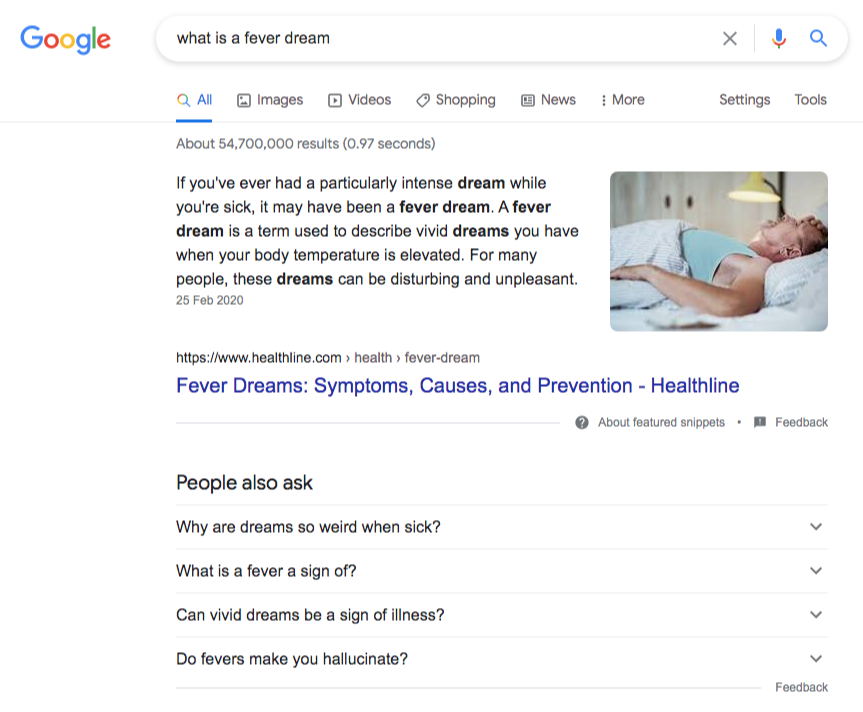
Google pulls this information out from one of the top-ranking pages.
Now, that is an opportunity you can maximize in your content. You could appear in the snippet section if you have a definition of a term on your page.
If you have pages currently ranking for your target keywords, you may want to look if they rank for the definition of terms.
Here's what you can do:
You can enter your domain into Ahrefs' Site Explorer.
Go to the Organic Keywords section, then filter for top 10 rankings with featured snippets.
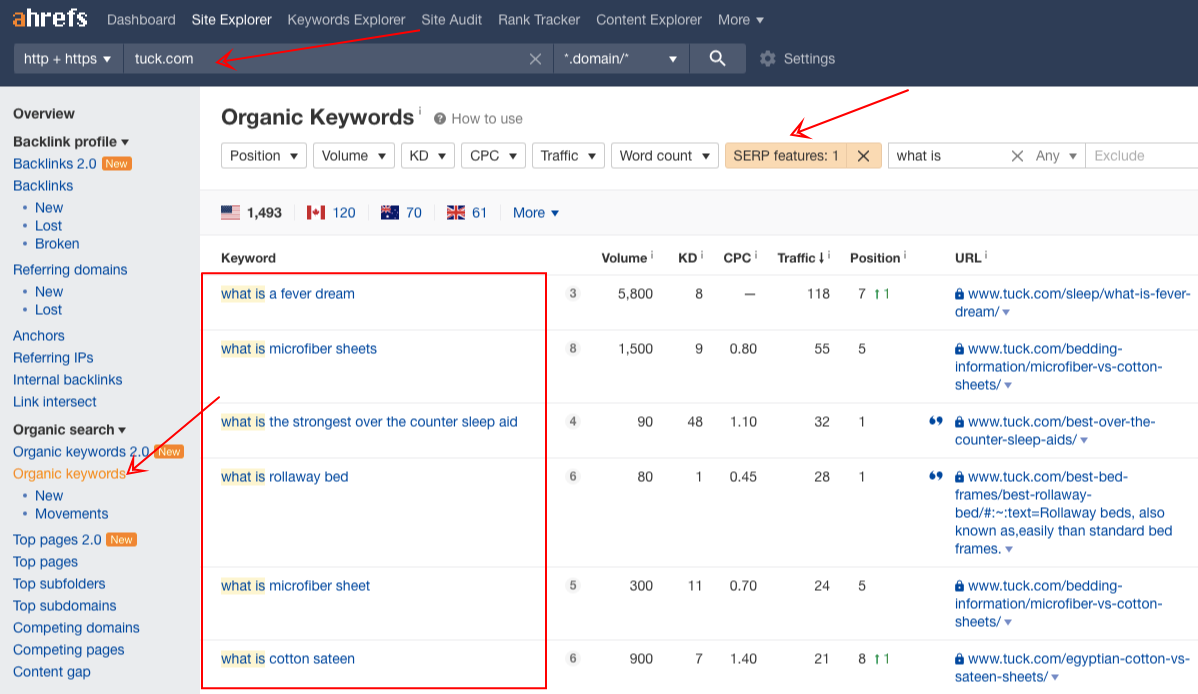
Next thing is you filter for "what is" and "what are" keywords using the Include filter.
Check through your pages that are currently ranking for these definition keywords. Add sections for "what is" or "what are" content. Make sure there's a relevant definition of those terms on your page.
How to Discover Content Types That Get Links In Your Industry
When you look for content topics to write, you also want to know what content types or formats that receive the most backlinks.
That way you can create a content piece that is both consumed best by your target audience and best linked by other people.
How will you know content types that work?
First, find any big publishers in your industry.
Then enter the domain URL into Ahrefs' Link Explorer.
Go to the Best Pages by Link report.
Look for any patterns of the content format that gets links most often.
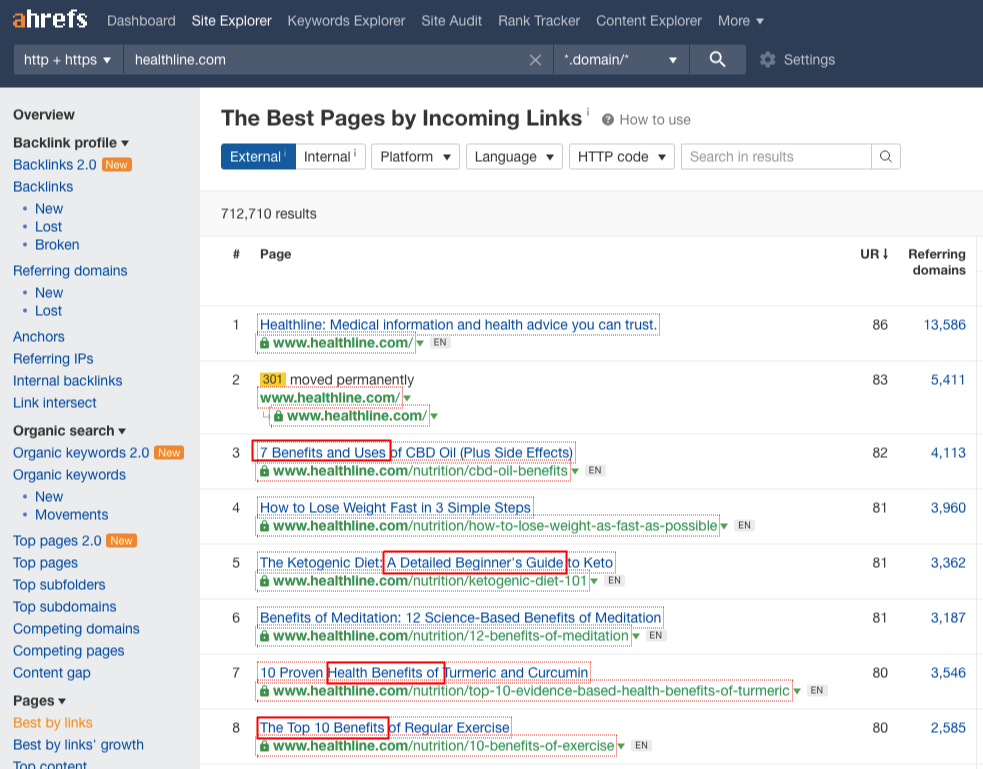
How to Find Videos With Potential To Attract Search Visibility Using Ahrefs
Video marketing gives one of the highest yields in terms of building brand awareness and gaining new followers and visitors for your website.
Here is how you can look for videos that have the potential to attract views from Google.
Go to Ahrefs' Site Explorer and enter Youtube.
Go to the "Organic Keywords" report. Then add a relevant keyword or topics to the "Include" filter.
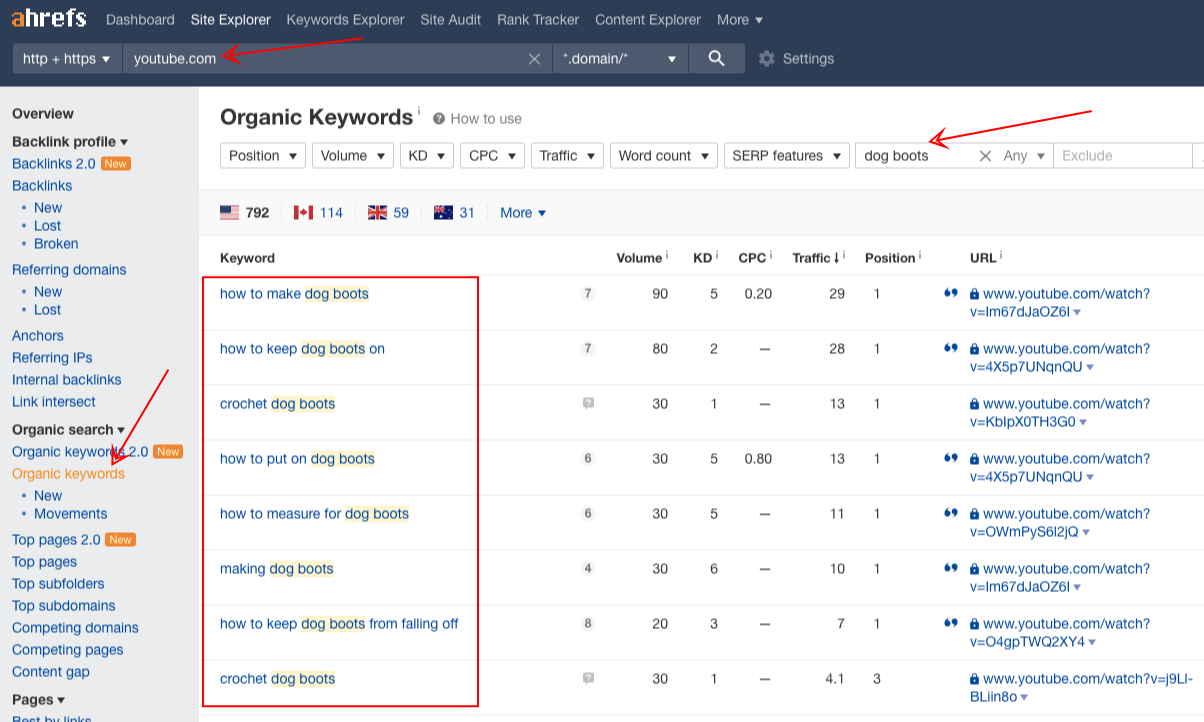
There you'll surface video topics that get on the top of Google when you search for them.
How to Know What Attracts The Linkerati
There are certain pages and topics that receive the most attention from linkers.
A more advanced way of finding what makes them tick is not only looking at the "Best By Links" section of Ahrefs.
If you enter a website into the tool, you'll find what pages they get the most number of links.
However, that's not to account for the velocity of their link building campaign. That means, if they're doing link building effectively, you'll likely see a steady growth of links.
You don't just see the Best By Links section, but also find some time to get more insights from the Best By Links growth.
If you try to reverse engineer a competitive content to know what attracts the linkerati, use Best By LInks growth for that. This feature of Ahrefs doesn't just show you what worked in the past in terms of link attraction, but what also works today.
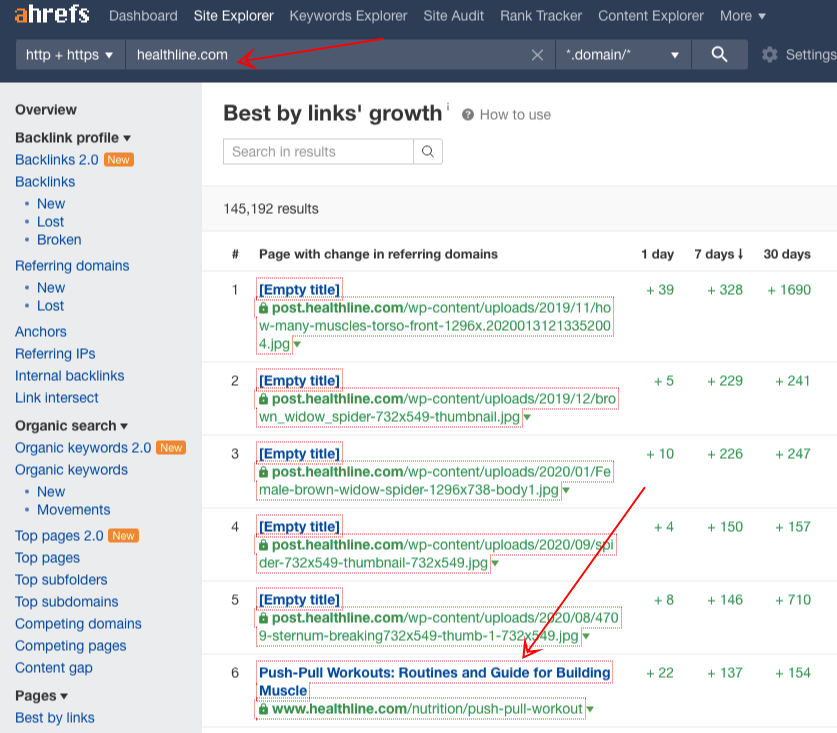
A steady link growth implies you have a content type and topic that captures attention from linkerati continuously.
How to Make Your Content Better By Knowing Why People Link To Ranking Pages
Content creation is not a one-time hit wonder.
You don't stop just because you create one.
But you continuously update it to better serve your target readers.
One way to make your content more powerful is to understand why people are linking to your competitor pages.
When you get insights as to why link to them, you can go back to your content and add insights to your page.
Here's how to do it.
Get one of the ranking pages for the target keywords you're trying to rank for. Enter the domain into Site Explorer.
Go to Anchors report. In here, you'll see what anchor texts people are using when they link to this page.

You'll then see anchor texts not commonly used by other people.
Look deeper and try to understand why by going through each of the pages linking to the content.
For instance, one reason the page gets a different anchor text because the author has a new section for the page he needs more references on a sub-topic.
You see:
Knowing why people link to certain pages can give you insights as to what sections to add to your content to make it better for your target audience.
Conclusion
I hope you got a ton of value from Actionable Tips On Using Ahrefs For Link Building.
Now I’d like to hear from you.
What tip from today’s post are you going to try first?
Do you want to try discovering linkable content topics using Ahrefs?
Or maybe want to try knowing if an outreach prospect has linked to you before?
Either way, let me know by leaving a comment below.
7 Insanely Actionable Tactics to Build Contextual Links
What is a contextual link?
Here's a good definition from Jason Acidre:
A contextual link is a type of link that’s usually found within the body of content and is in context with the idea surrounding the link. It can be both natural (voluntary links from other websites – ex: link bait) and artificial (manually built – ex: one of your guest posts that links back to your blog/content).
Building contextual links can benefit you in so many ways, which include:
Targeted traffic. Leads. Online brand presence.
They are all good, but they only seem " too good to be true" if you don't know the exact how-tos of building the right contextual links.
Today, I want to give you 7 ways to get contextual links for your website.
How to Build Contextual Links?
1. Maximize Targeted Outreach
Targeted outreach is basically sending out emails to prospect linkers of a very specific content - most are existing articles with the same topic, with a hope to get reference links back to the site.
Let's say you have published a post on "how to stop my husband from snoring". If you want to get contextual links, you may reach out to articles that rank for terms like, "how to stop snoring", "how to stop snoring of your partner", or even "top snoring apps".
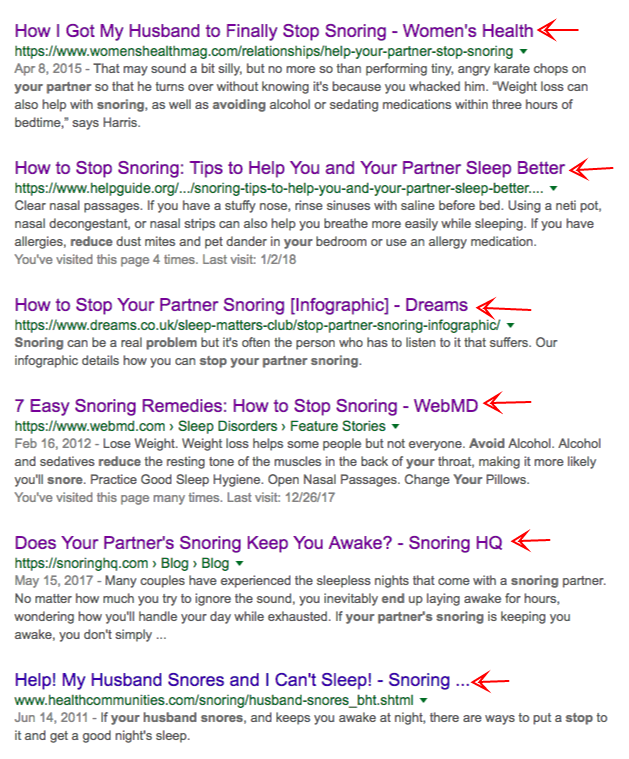
Because they'll find your article to be relevant to use as an additional resource (i.e. including your content on "you may also check out this article on" or "for further reading"), there's a good chance you'll acquire a link.
But it's not a guarantee that it works all the time. You have to understand the context of the linking page and your content, so you can determine if there's a good linking chance.
Here are some tips to guide you when assessing these link opportunities:
First, check the primary focus topic of the article/page.
Ask yourself, "Does the prospect article I'm trying to get a link from cover a much larger subject compared to the topic of the content I'm pitching with?".
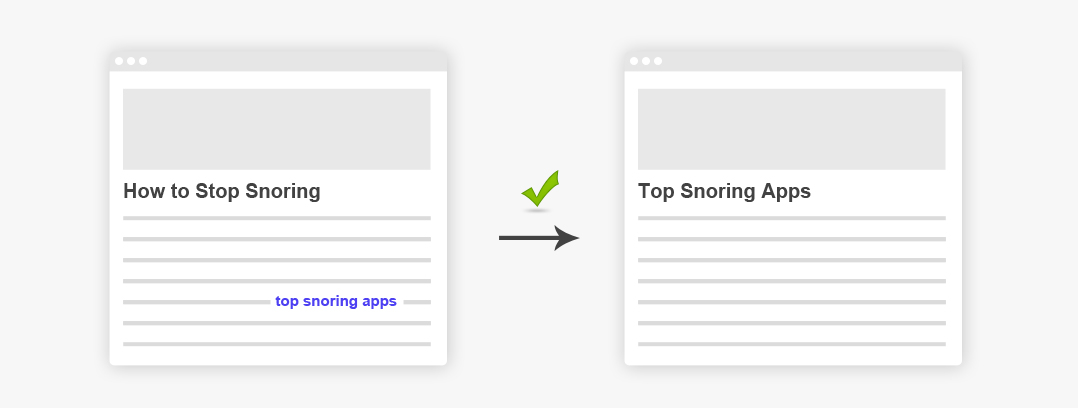
If you are pitching your "top snoring apps" to an article about generic "how to stop snoring" content, there's a good chance to get a link from that because the linking page covers a wider subject and perhaps has a subsection about snoring apps - which then provides you an opportunity now for a link.
But how about if it's vice versa? "how to stop snoring" to "top snoring apps," would you get a link?
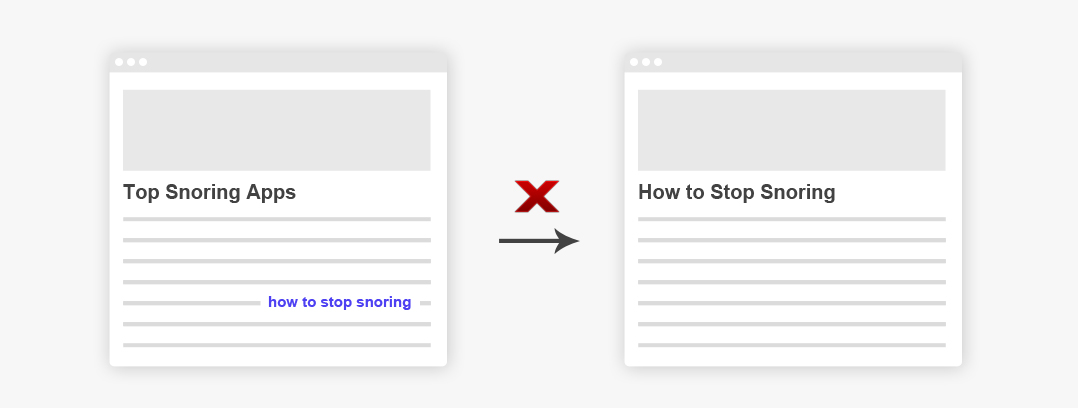
The answer is, "it depends."
Depending on how the article is structured, if the article covers exactly "top snoring apps" and your page isn't about apps, there'll be misalignment on his part to link to you. But it's not always the case.
If your article discusses a subsection on snoring apps that haven't been discussed/included in the prospect existing article, there's a good chance you'll get an external backlink.
The logic is that the blogger would want to give a reference link to a page that explains more about a topic/word/phrase mentioned in his article but have yet to be expounded.
Second, you need to assess external links on a page.
If you see a homepage link on an article referencing a product/service, not as a recommendation, just like brand mention (see example below) or a product review that links built to a commercial page, there's a less organic linking chance to it.
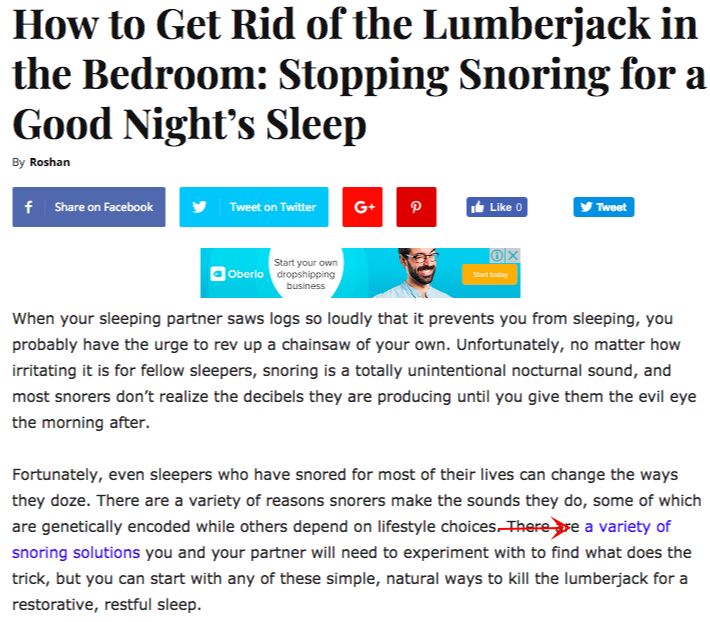
The reason there's a link there is either the webmaster/blogger is affiliated, partnered, or is compensated for the effort of linking, or simply, the product/service is an authority in the space - undoubtedly being linked to in most blogs.
The third thing is to identify if the page is dynamic or static.

What I mean by dynamic is some pages frequently update over time, and other pages are not. Those pages that require updates of links are dynamic.
If you're reaching out to a dynamic page, there's a high probability to acquire a high authority link, as the need itself looks for new resources or references. In other words, they'll be linking to your content if it improves their content piece.
For example, a blog post on snoring apps for 2017 can be dynamic if its URL isn't targeting the snoring apps 2017 phrase. If it's just snoring apps resource articles, it allows new links to resources.
The more dynamic the existing page is, the more likely you'll get a link juice. Otherwise, if it's static, they should have reasons to link other than the topic's timeliness.
So, there are three ways to check if an existing article/page can link to you.
Second tip:
2. Generate Easy Links From Relatively New and Low Authority Publications
You aim for links from DA30+ blogs, but from sites with lower metrics (<DA30), you probably don't.
Not pitching low-authority sites is kind of short-sighted thinking.
If you aim for traffic and clicks from links, there are low-authority sites with upward trends in organic growth that you should be getting because they increase the value of links when you get them.

More importantly, if these blogs are still new in the industry (use archive.org to check), you'll find that after a few months or years, they'll have increased their followers and linkers.
Thus, if you have built relationships with them upfront, it will not be difficult to convince them for you to contribute posts on their blogs.
Note: If you have an authority brand, you should aim for top-tier industry blogs. But if you're starting to grow your link profile, pursuing even low-authority blogs can be effective.
To check if a low authority blog is worthy of your link efforts, you can use Ahrefs or SEMRush to check the site's estimated organic traffic.
The slope of the organic traffic trend signals the site's growth. The steeper the slope upward, the better.
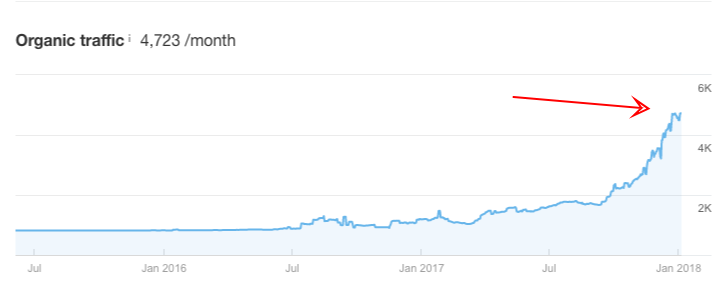
Once identified if a low authority blog is link-worthy, you'll reach out to them with whatever offer you have - either a content asset worthy of a link or a visual asset ready to be republished.
3. Evaluate Similar Page Links for Homepage Ask
You probably heard that tip from Ross if you religiously consume content from SiegeMedia.
In my experience, that's one way to assess your chance of getting the link.
If there are commercial links (i.e., one link pointing to a product page) on a page, you can get a homepage or commercial link.
The history of linking to similar page types is one true sign of a possible link.
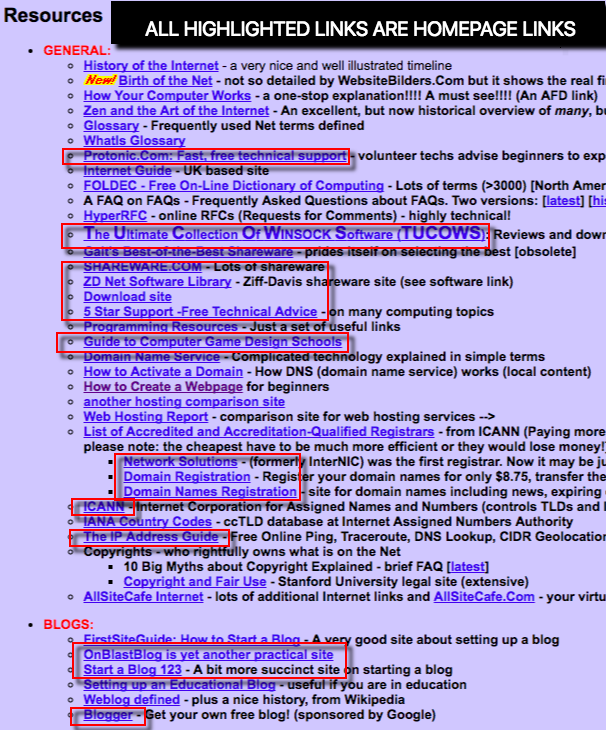
However, that's not to say that it is always a guarantee. Proper assessment lets you know if a homepage ask is worth pursuable.
Here are some true signs of a potential homepage link:
- Keyword-optimized anchor text - very few you'll find a link with the exact target keyword/phrase as the anchor text. So seeing one (except for Exact-match-domains where brand names are exact ranking keywords) is an intent to link to a commercial page.
- List of partners - you normally see this in eCommerce; retailers, manufacturers, suppliers, and other business partner types are mostly homepage as linked pages.
- Recommended products/services - top X tools in 2018 is one example where the homepage ask is feasible
Even if you've got a great content piece published recently, if you think a homepage would be the best fit, that's something you should pursue to be linked to. The opportunity cost is high if it's not, given that a homepage link is way more difficult to acquire than top-of-the-funnel pages like industry guides.
4. Link Exchange Exclusively For Linkable Assets
When you have a great linkable environment, you'll start receiving emails from other bloggers or webmasters wanting to get their links to their own sites.

Every month, three or five asks of this kind is a good opportunity to link exchange.
Depending on the cases, you'll find it okay to link exchange for both linkable assets exclusively.
It's natural to find a page that references good content, and a web page from another site links to your good content.
Here, you don't get links mutually to the same pages (page A to page B, page B to page A). That's a 2008 link exchange. Rather, your content A gets a link from his page A, and his content B is linked to your page C.
Below are more tips to guide you with this tactic:
A. Check if the linking partner is a good fit.
You will receive different emails of an ask-to-link (link exchange): some pitches include direct links to their preferred pages/content, while others don't.
If the email is handcrafted well (with your name personalized), it's a sign of a good linking fit.
However, some emails start with Dear Ma'am/Sir but still have a good relevant content piece. The person reaching out just doesn't know how to outreach properly.
So, always check the email and the website they have. Assess if the page or website itself is semantically fit for your brand.
B. Assess their preferred linking page.
If it's a content page, they're building links to it. It's a potential fit.
Otherwise, for commercial pages, consider if the product/service could be highly recommended on your website.
As Ross Hudgens says, "Building natural links to landing pages with commerciality built in is pretty close to impossible with cold outreach."
C. Identify which page you could put their link.
Unless you're willing to put a new page/article to give them a link, you could simply search for an existing page on your own website that best fits them.
If you have a recommended readings page, that's one choice you can pick, as you can simply include a link to their content if there's a section that fits their topic.
D. Check if you could also get a link.
I suggest you choose one page that you'd like to improve keyword rankings visibility by getting more links to. Then by doing a site search on Google for their domain, site:hisdomain.com "topic", check if they have a page that fits the topic.
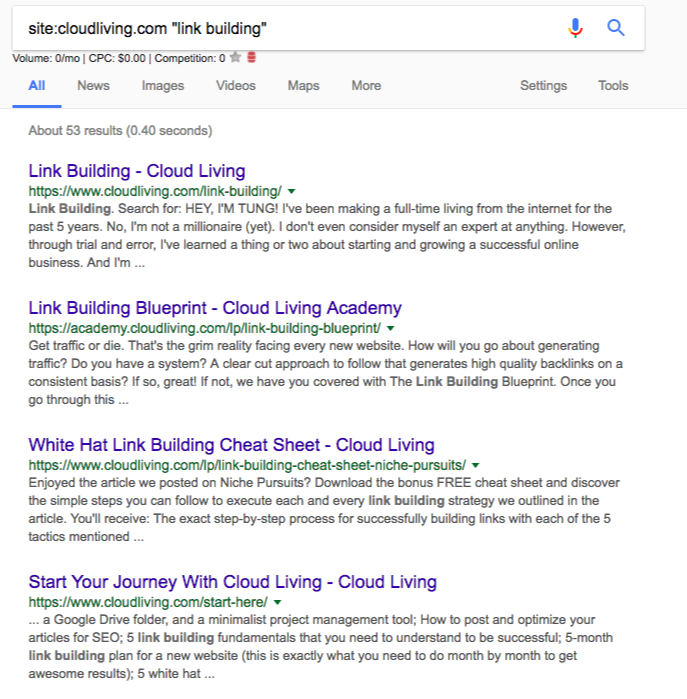
Once you start attracting potential linkers, link exchange exclusively for linkable assets can be a low-hanging fruit tactic that can add new links to your website,
5. Use Twitter to Nudge Bloggers About Broken Links
Perhaps you've found broken links on a target resource page, and you thought, "Maybe I could tell this to the webmaster to connect easily, hoping to get a link".
So you easily go to your outreach tool and craft an email to the webmaster with the note, "I've found errors on your page".
He doesn't respond, so you send a follow-up.
Nothing happens, so you proceed to your next outreach prospect.
This is an opportunity cost.
No response doesn't mean there's a huge problem with your link prospecting and outreach approach. There may just be a little tweak needed to connect to your outreach prospect properly.
How about sending a direct message on Twitter to connect?
Most bloggers are active on social because they care about their community (their followers) and consistently curate industry posts through social posting.
For that reason, if you send a direct message to a blogger about their broken links, there's a high chance you'll get noticed.
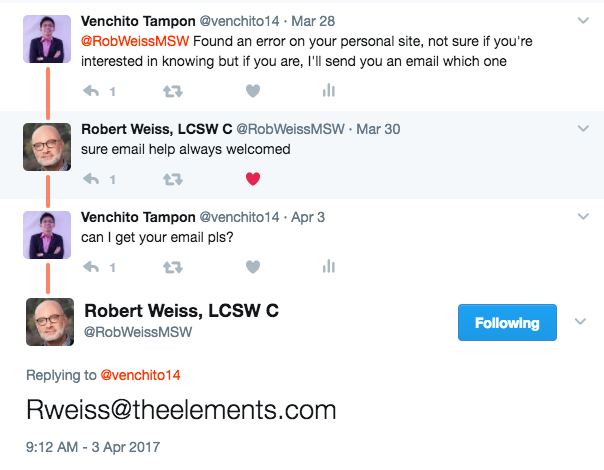
The methodology isn't perfect, but it could make you stand out in a world of really basic, boring email templates, even a messy BLB pitch like this one:
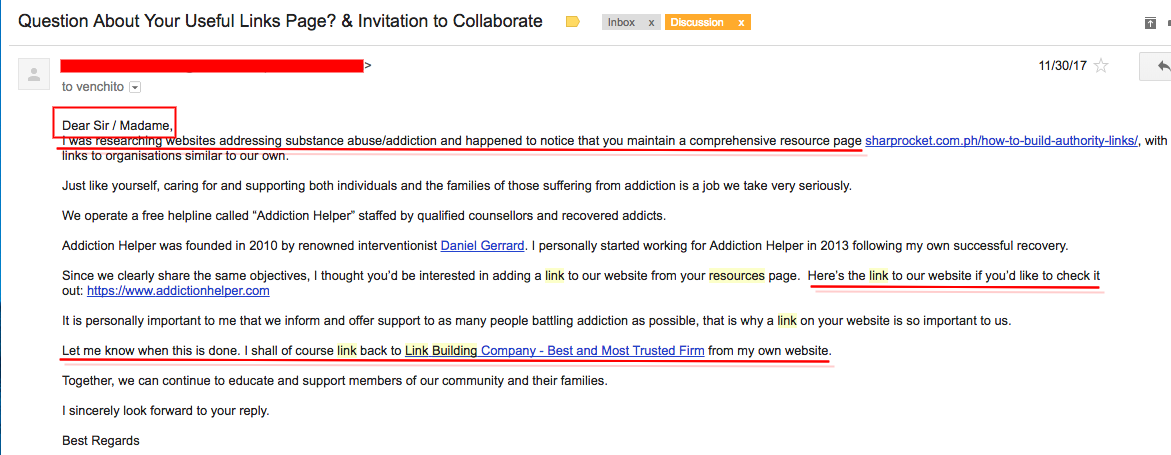
Once you've connected on social media, you can stay in the medium for the conversation or redirect messaging to email. The latter best works if you've asked the person about his personal email.
6. Find Industry Link Roundup Terms to Increase Conversion Rates
Right when you search "contextual link building" or "contextual links", you'll find articles on the first page of search engine results pages that say, "get links from link roundups."
You know the tactic has been written several times in many SEO articles, so you know how the process works.
Step 1: Use search operator, "link roundup" "INDUSTRY" or "roundup" "weekly" OR "monthly" "INDUSTRY" to find industry-specific link roundup opportunities.
Step 2: Create a list of blogs with link roundups and find contact emails of webmasters.
Step 3: Reach out to them with an email template that says, "I've found your "ROUNDUP NAME" .. and thought you might be interested to see this recently published on TOPIC — <insert your link to the post>" or anything similar to that.
It's an effective tactic, but not everyone can get results from it immediately.
What's missing in this tactic is optimizing prospecting for industries with little-to-no outreach markets for this rare link target.
What do I mean?
Not all link roundups have titles of "best links of week/day/month" or "industry link roundup", most of you would discover that sites named their roundup series with weird names, i.e. "blog party," "link party," or "blog hop."
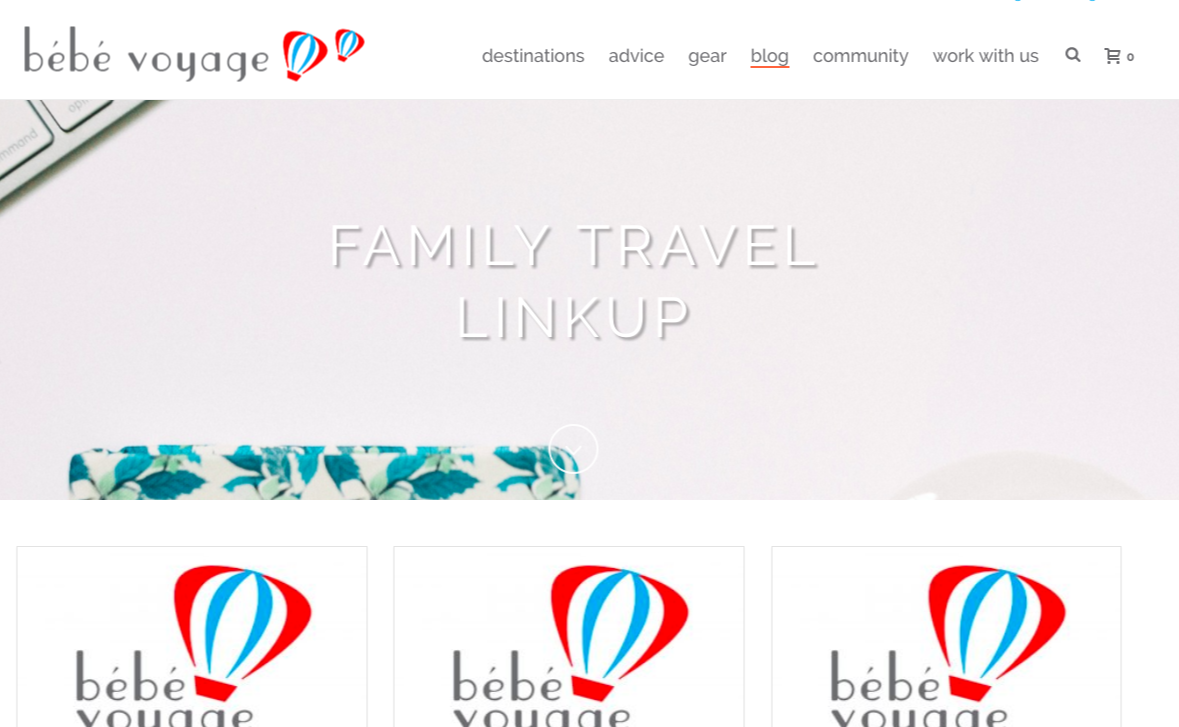
They may sound black hat 2008, but these are the terms bloggers use about "link roundups."
So, how do you find exact link roundup titles in your industry?
I recommend you start identifying an authoritative industry blog (one with DA60+) that publishes regular high-quality content pieces.
For example, if you're in the wine industry, one popular wine blog that consistently produces high-quality content is WineFolly.
They publish a diversity of content assets - from 10x guides to visuals, and they do it regularly.
You will see this post on pairing wine and cheese by checking their top content of all time (top content with the highest number of social shares, not by # of links). Take a deeper look at its referring internal link. You can immediately see roundup links, including this roundup post - GrapeCollective Wine News.

Dig into other top content's links, and you'll find more roundup links like Grape Wall Daily.
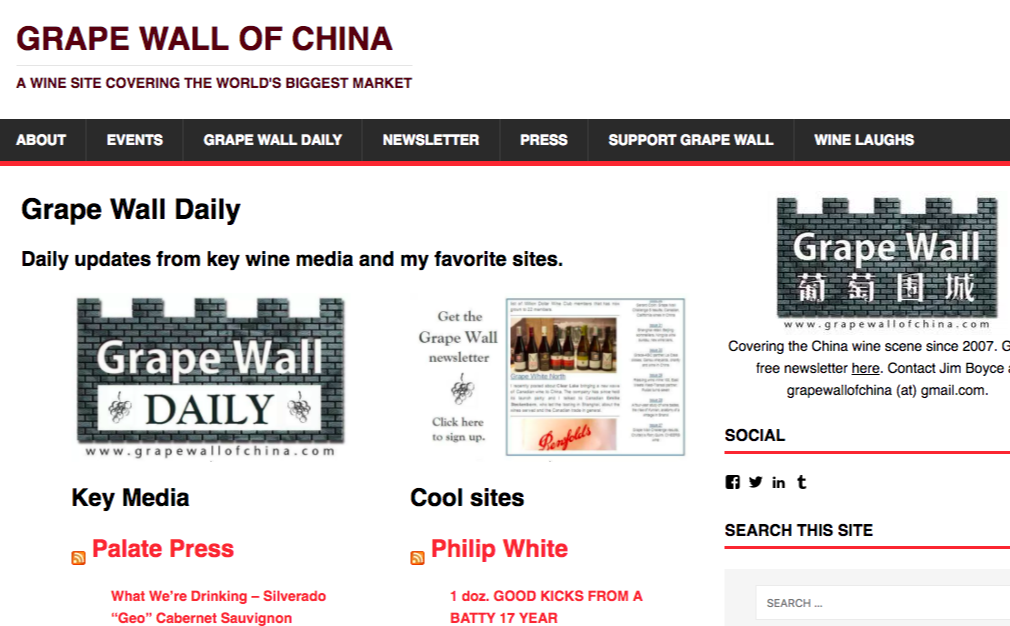
You understand the pattern. Find a top industry blog that produces high-quality content pieces. Check the site's top pages based on social shares (you can use Ahref's top content feature, not top pages). Check if the most-shared content has gained roundup links. If yes, grab those link opportunities and gather more link round targets by reverse engineering the site's other content pieces.
7. Invite Contributors Using Different Offers
It has been proven repeatedly that getting contributors for your blog can help increase the number of referring domains.
For example, Joshua Dorkin grew his real estate blog - BiggerPockets- by creating high-quality content pieces from regular contributors.
That strategy allows his blog to become one of the real estate authorities today.
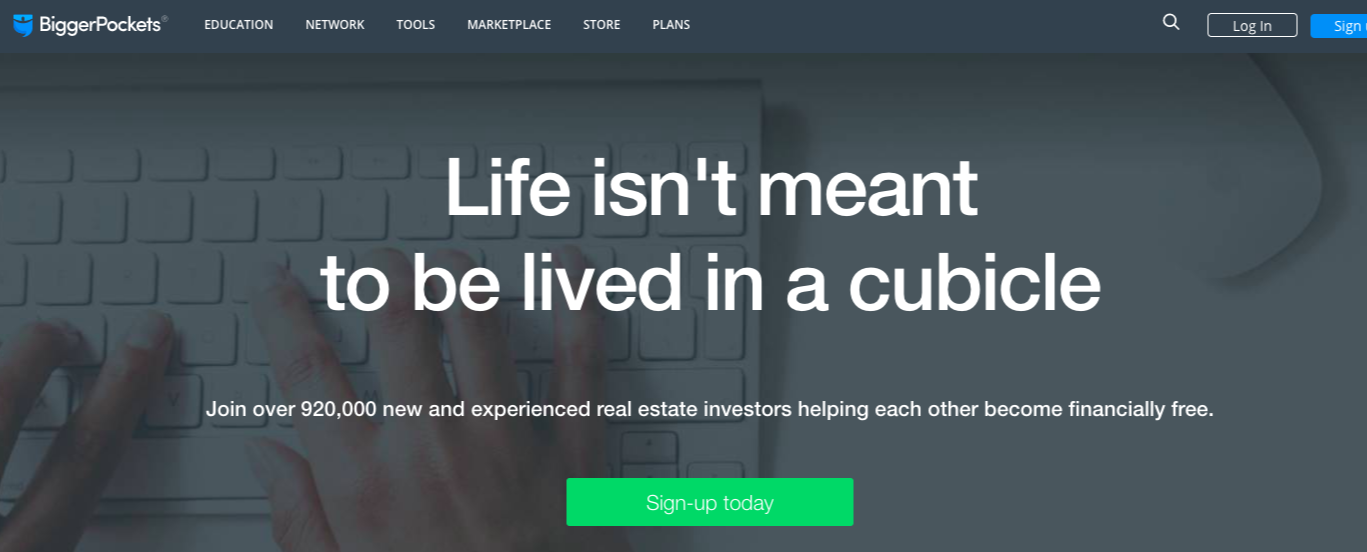
In his comment at Kaiserthesage's blog, he said that he gets 30+ contributors to write for BiggerPockets weekly while he ensures that they put out 2-3 good pieces of content through his content marketing team.
Today, BiggerPockets for sure has more blog contributors. Maybe double, triple, or 10x their site traffic because of that strategy.
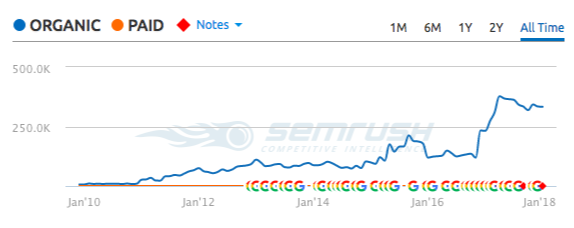
That's just for one industry, but other niches with massive blog communities have gained more exposure and links simply by getting regular blog contributors.
Getting started with inviting contributors is easy. You email potential contributors and ask if they're interested in writing for you.
The hardest part is getting them onboard.
If you can answer "what's in it for me" for bloggers, you'll have a high chance of enticing them to become your regular contributors.
Below are some valuable offers to make for bloggers:
- Increased exposure to the blog through the additional social following, email subs, and referral traffic. Got a DA45+ blog? Reach out to new bloggers (DA20 or less). This is more realistic than pitching top authority bloggers like Brian Dean's blog (DA70+ blog).
- Premium product subscription. I wrote for Ahrefs in 2013 in exchange for a monthly standard subscription plan for their product. This works for your niche, too, if you have a great product to offer.
- Content collaboration. Less work for the blogger. Gets more credibility for both parties if both of your blogs have an immense following on social and emails.
- Compensation. The best is to target part-time bloggers. They charge cheaper than full-time ones. One tip is to check if their about/media/press/hire-me page. They won't go cheaper than that if they include a $ per article/hour rate.
- Relationships. This matters most if you want to bait bloggers to write for you. There is no need for additional offers, as they would write for your blog.
Once you have invited bloggers to write for your blog, you may constantly check new bloggers in your industry you can potentially reach out to be added to your contributors' list.

So those are 7 ways to build contextual backlinks to your website.
If you don’t have the time or inclination to do them, you should probably find someone who can. Learn more about our link building service.
Contextual Links Frequently Asked Questions
So those are 7 ways to build contextual backlinks to your website.
What is an example of a contextual link?
An example of a contextual link is when a blog post about red apples mentions other types of apples, like green apples. Contextual links connect related content to provide additional information and enhance the user experience. These links contribute to a more comprehensive understanding of the topic. By creating contextual links, website owners can improve the relevance and authority of their content.
What are the different types of contextual links?
The three primary types of contextual links are external links, internal links, and reciprocal links. While implementing contextual linking can be challenging, it yields significant value when executed effectively.
What are contextual and formal links?
Contextual features refer to elements of language that exist beyond physical manifestations, whether in the real world or the minds of individuals. Texts are segments of language that are treated formally, and cohesive devices are formal connections between sentences and clauses. Contextual and formal links serve to establish meaning and coherence in language.
How Many Backlinks Do I Need to Rank?
How many backlinks do I need to rank?
The number of backlinks you need to rank for your website can vary from 0 to 300+ backlinks.
The difference between a website that needs zero backlinks to rank for its target keywords and a website that requires hundreds of inbound backlinks is its domain and topical authority, full technical and on-page relevance and optimization, and the backlink gap between the site and its competitors.
In this post, you’ll learn how many backlinks you need to rank by determining it yourself and how you can qualify if your site can rank for the topic you’ve chosen.
How Many Backlinks Does It Take To Rank High in Search Results?
To rank high in search results, you must look at different on-site and off-site factors and determine the backlink gap between you and your competitors.
Let’s first take a look at your on-site factors.
On-Site Factors
Ideally, your website must be on the first page for your target keyword if it has all on-site relevance factors.
If you’re doing SEO for a new website, there’s a lot more to work on your site’s topical relevance and trust so Google could make your site deserve to rank high in search engine results pages (SERPs).
Compared to a trusted website with DR70+, where it can rank almost any relevant keyword as soon as Google indexes the page.
Look at your website and see if you’ve done the bare minimum optimization to increase your site's topical relevance and trust.
Before you dive into and be aggressive in link building, check if you’ve got the necessary factors to compete over other competitors’ well-optimized sites. Technical SEO to ensure the only needed pages are indexed and crawled by Google. Fast-loading pages for better user experience are trust signals to keep your site in its ideal position on first-page SERPs.
Topic Relevance
Your site’s foundational relevance has a huge factor in rankings. If you’ve built topical authority, the potential to rank for other pages is much easier.
Let’s take our coffee shop blog as an example.
When we started it in 2021, it would take us months to see results in rankings and organic visibility, not to mention it’s difficult to rank for any coffee-related keywords in the Philippines.
As soon as we publish more quality blog posts, it gets more trust, bringing it to another level of authority to rank easily for any coffee-related keywords.
It ranks #3 for “how to start a coffee shop business in the Philippines” and all its variation keywords on the first page - gaining organic visitors daily.

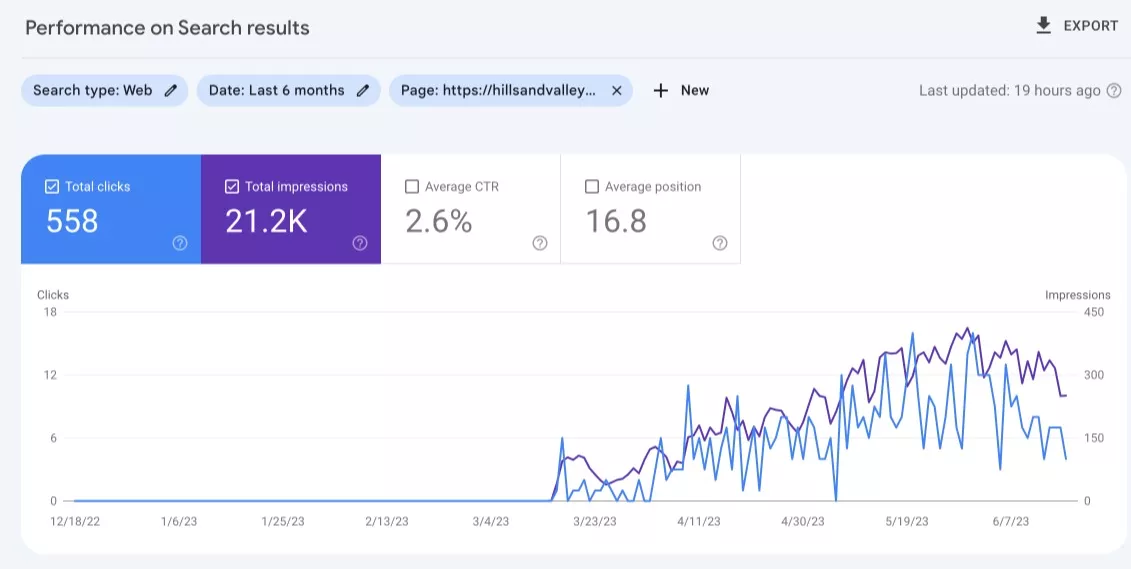
Your site’s topical authority is a huge determining factor in how quickly your site ranks without needing to build more backlinks.
On-page SEO
Put your target keyword in your site’s URL structure, meta title, H1, H2, and first and last sentence of your content - all these can help set up the proper relevance on-page relevance.
Content Optimization
A solid match to search intent. Determine the keyword’s search intent through tools like Ahrefs or SEMRush, or the simplest way is to do a Google search for the keyword. See the types of content of the top rankings pages. Are they product listing pages or blog content showing useful information?
Do you see featured snippets for your target keyword? This can help you optimize your content better.
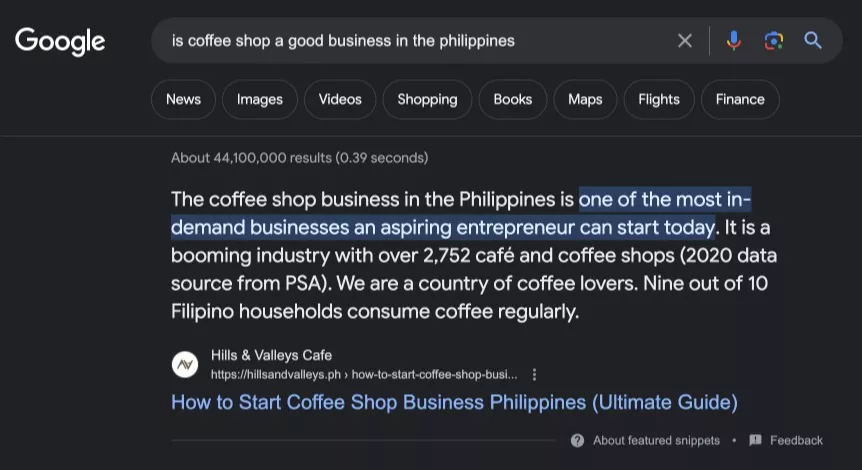
Internal Linking
One of the underrated SEO techniques is internal linking. Before doing any kind of link building campaign, start by leveraging the power of internal linking to boost your page’s ranking.
Check any blog content that is relevant to your target page. You can use a quick inventory of your website through Google search or Ahrefs.
Edit your page to include the link to the page you want to rank higher. Update and index it again.
You should see some ranking improvements by simply doing it. At most, this might decrease the number of links you need to rank higher in SERPs.
SharpRocket’s Backlink Gap Analysis Playbook
Assuming you’ve got everything covered - from technical SEO to content optimization, but you’re still not ranking for position #1 to #3, now all you need to do is build more backlinks to your page.
But first, start by doing a backlink gap analysis.
Backlink gap analysis determines the quantity and quality of your competitors' backlinks and measures them against your site to count how many backlinks you need to beat your competitors.
Doing a backlink gap analysis gives you an estimated number of links you can acquire in a given timeline. This is where strategy takes place, as you can allocate enough resources for the campaign - including your outreach specialists and budget for external content (i.e., guest posts).
Step 1: Collect DR20+, in-content, do-follow backlinks of your target page and its competing ranking pages.
For this process, you need two things:
1. Links data of your target page.
Use Ahrefs to get link data of your target page.
Plug your page URL into Ahrefs’ Site Explorer and click “Exact URL’. Then click the search button.

Go to Backlinks (under Backlink profile). This gives a rough estimate of all linking domains to your target page.
You may get this as the exact number of backlinks to target in link building, but you’re missing some key factors here.
First, only some of these links are equal. It means some links and a few directories you don’t need to consider are easy to replicate.
In other words, you need to qualify all these links first.
Filter links by DR 20+, do-follow, and in-content types of links.
This doesn’t mean other types of links don’t matter at all. It is such that we only see in-content as high-value and hard-to-replicate links.
No-follow and sitewide links obviously may directly impact the site’s ranking performance - but they’re easy to replicate, particularly when the brand has a lot of passive link opportunities in play.
So, click on Dofollow to filter the links by dofollow. And click Backlink type, then choose In content to filter links by backlinks placed in content like blog posts. Filter again by DR20, click DR, and insert max 20.
These will give you all backlinks filtered by DR20+, do-follow, and in-content links.
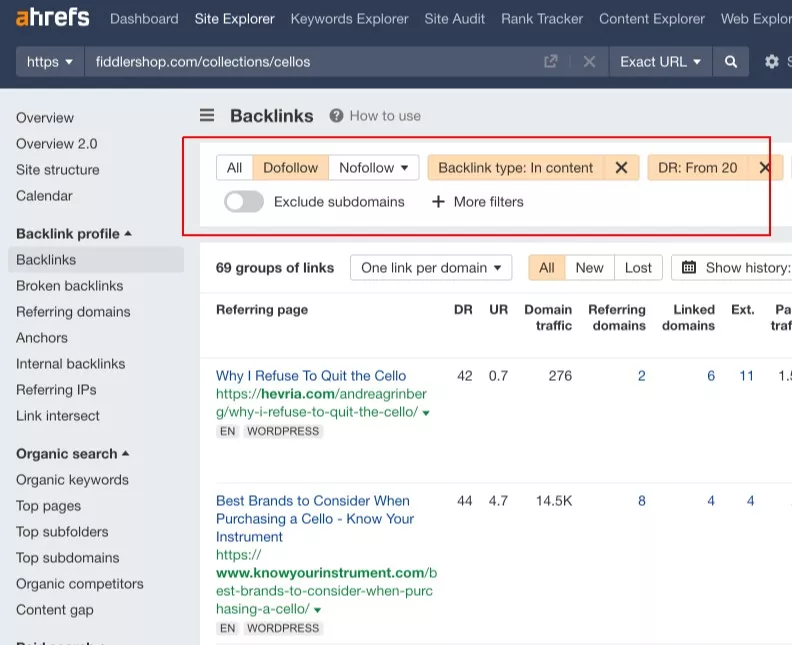
These are the exact links you consider as your weapons to beat your competitors.
Now, let’s review your competing pages and strike their link numbers.
2. Links data of your competing page ranking position #1, #2, and #3 for your target page.
When choosing competing pages, try to look for websites that do not just rank because of authority but have a substantial number of backlinks. Authority sites like Amazon and Etsy don’t need additional links to quickly dominate the SERPs, as they have the inherited domain authority.
You need to look for competing pages from less-authority sites ranking on the top spot in SERPs. This could give you many insights regarding the quality of backlinks they acquire and their exact link-building strategy.
Once you’ve selected the competing page, plug it into Ahrefs’ Site Explore and choose the Exact URL.
Use the above method—filter by DR20+, do-follow, and in-content links.

Now, these are the backlinks you need to beat.
Step 2: Deduct qualified links of your top competing page from your page’s qualified links.
What is the number of backlinks you should beat?
While you can go for the average number of links of your competing pages, let’s say you’ve got 83+ for competitor #1, 56 for competitor #2, and 117 for competitor 3. By average count, you have 85.33 or 83 links as your target to-beat number of links.
While that’s a quick calculation, the difference in the number of links doesn’t share the same context. One or two of your competing pages may have high DR, so they only require a few backlinks to be on their top positions. On the other hand, the ones with lower DR need hundreds of backlinks to compete.
We go for the competing page with the most links in our link building services to clients. In our given example, it is competitor #3 we’re looking after.
The reason is simple. Whether or not you hit the exact number of links, we will likely hit position #1, as our team is aiming too high on our link building campaign. That’s a good mindset to consider when beating competitors with backlinks.
To compute for the total backlinks to beat, deduct your page’s link count from the top competing page’s link count.
So, to answer the question, “How many backlinks do I need to rank?:
The simple answer:
Compute the backlink gap between your page and the top-ranking page with the highest link count, considering only DR20+, do-follow, and in-content backlinks.
Free Resource for Consultants, Freelancers, and SEO Agencies
Below is the exact template we use for our clients to give them an understanding of their current backlink situation using link gap analysis.
You can click directly here to see the exact backlink gap analysis template.
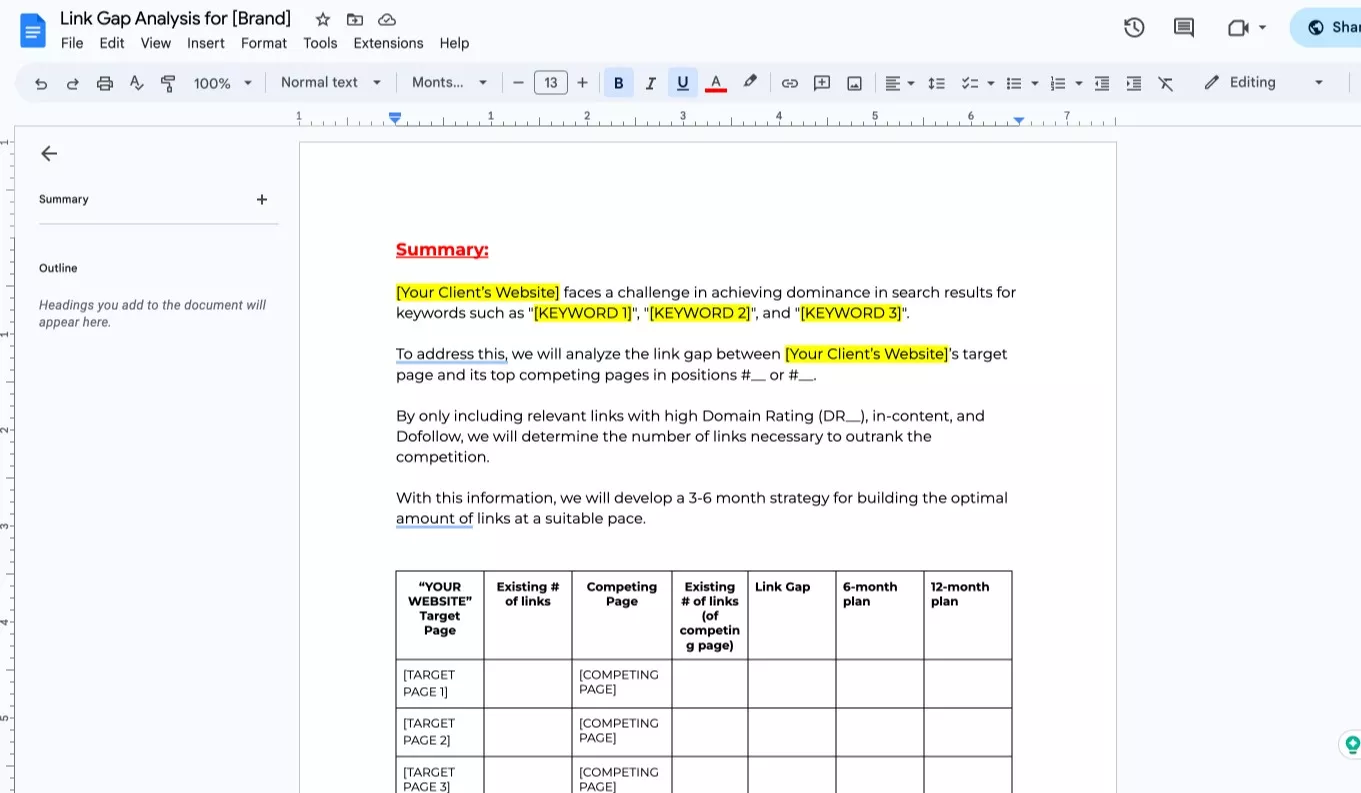
Executive Summary
[Your Client’s Website] faces a challenge in achieving dominance in search results for keywords such as "[KEYWORD 1]", "[KEYWORD 2]", and "[KEYWORD 3]".
We will analyze the link gap between [Your Client’s Website]’s target page and its top competing pages in positions #__ or #__.
By only including relevant links with high Domain Rating (DR__), in-content, and Dofollow, we will determine the number of links necessary to outrank the competition.
With this information, we will develop a 3-6 month strategy for building the optimal backlinks at a suitable pace.
| “YOUR WEBSITE” Target Page | Existing # of links | Competing Page | Existing # of links (of competing page) | Link Gap | 6-month plan | 12-month plan |
| [TARGET PAGE 1] | [COMPETING PAGE] | |||||
| [TARGET PAGE 2] | [COMPETING PAGE] | |||||
| [TARGET PAGE 3] | [COMPETING PAGE] |
[YOUR PAGE 1 TITLE]
[Your Client’s Website] has a high Domain Rating (DR__) and is competitive with top-ranking pages [Competing Page 1] (DR__) and [Competing Page 2] (DR__).
We have assessed [Your Client’s Website]'s ranking against [Competing Page], which currently has a high Domain Rating (DR__) and ___ links with DR__+, Dofollow, and In-content (excluding navigation, sitewide, and footer links).
Strategy:
[Your Client’s Website] currently has __ links while [Competing Page] has ___ links, resulting in a significant link gap of ___ links. Our strategy includes building __ or more links within 6 months and __ links within 12 months to close this gap and improve [Your Client’s Website]'s ranking.
How to rank first page with fewer backlinks?
As I’ve mentioned earlier, there are situations where you don’t need hundreds of backlinks to dominate the first three spots in SERPs.
Here are some techniques to rank first page with fewer backlinks.
Build topical authority
Much has been said about topical authority, particularly from Matt Diggity, who coined this term.
What is topical authority?
Topical authority refers to the website’s perceived expertise in a specific niche or subject, establishing trust by covering in-depth topics.
But topical authority isn’t just mainstream. When you have it on your site, Google trusts you, and it’s now easier to rank for new pages that your competitors would require to build more links just to be on page 1.
After publishing coffee business blog content, your pages can show on the first page results after indexing.
Here are quick, actionable tips for building your site’s topical authority:
- Create a topical map to allocate resources for a single topic or subject.
- Don’t ignore low search volume (10 or 1-10) but semantically-related keywords. You’ll get compounding traffic by targeting hundreds of low-search volume topics.
- Add FAQs at the end of the article and answer many questions about your topic. Use the latest feature of Detailed to scrape deep levels of People Also Ask questions.

Satisfy users with comprehensive content.
Identify the search intent and content structure of every topic.
You can easily judge how the content structure by looking at Ahrefs data. But you’ll find missing pieces on what Google favors pages to rank for each keyword.
One of the good examples of Ross Hudgens is for the query, “Hubspot alternatives.” You can easily create a page solely talking about your product features compared to another product (in this case, Hubspot).
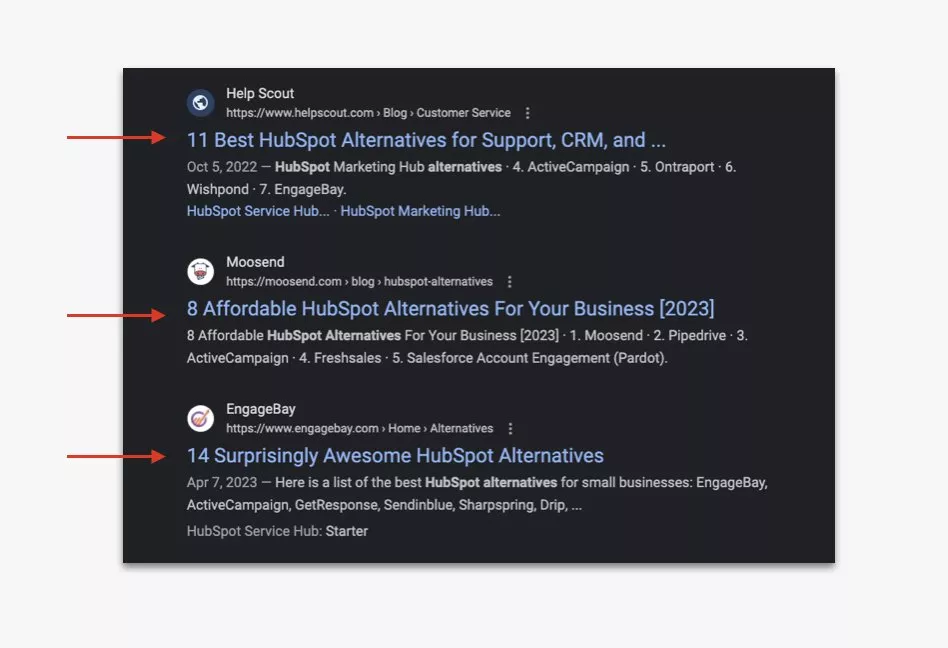
You’ll end up not ranking as the SERPs have ranking pages for list types of content, showing a variety of product alternatives.
This is just one example of how you should attack every content. Do a Google search for your target topic and analyze how the creators structure the top-ranking pages. Different keywords may yield different content structures.
From here, you’ll also have to analyze how to make your content better than the competing blog content in terms of word count, basic on-page optimizations, and questions being answered at the end of the article.
In today’s EEAT for content, it’s essential to make your content comprehensive enough by adding unique experiences. If you’re writing for affiliate niche sites, trying out the product before reviewing it is much more favorable.
You can also ask your internal team or other industry experts to contribute insights to your content for different publications.
All these while ensuring you put basic on-page optimizations on your content.
Include a new page in your site’s navigation menu.
We’ve been working with more eCommerce brands lately, and one of the missing ingredients eCom SEOs is for every page to be indexed fast by Google.
One best way to ensure that is by including your newly published page in your site’s navigation menu.
If it’s a resource guide, you can include it in your blog’s/hub/resource/learn menu, or if it’s a new collection page (for Shopify), best to have it as part of your category menu.
This basic SEO technique allows for faster indexing and crawling of Google on your site’s new pages.
Build more internal links.
While we’re a big proponent of building inbound backlinks to every site, we can’t ignore internal links to flow the site’s link equity to other pages.
If you don’t think of a page to build internal links to, you can check pages of your site sitting on positions 6 to 20. These pages may require more internal links to boost their ranking positions.
Use Ahrefs to find these lower-ranking pages.
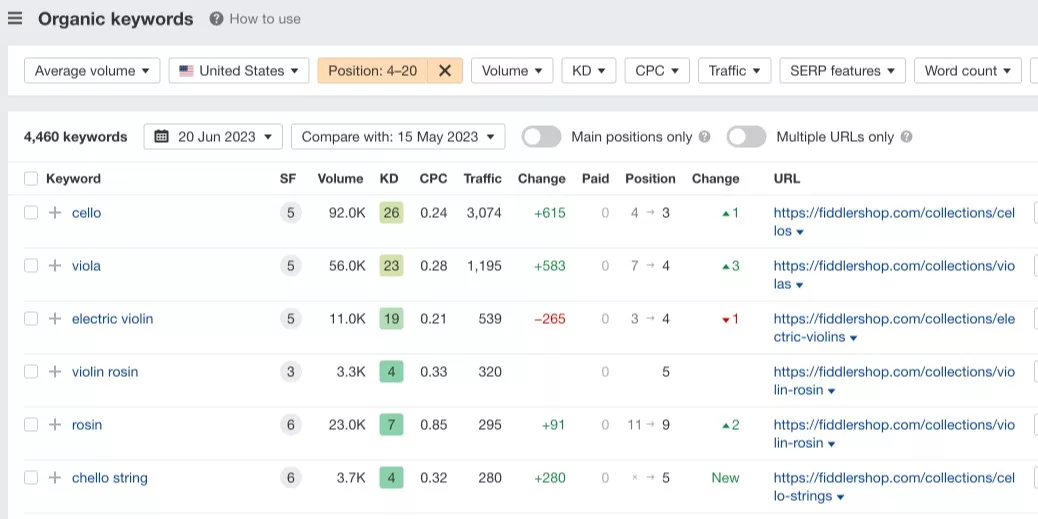
Then, find blog content that has acquired backlinks (top linking pages). Edit your pages and include internal links to your content.
Frequently Asked Questions:
How many backlinks per month is good?
There is no specific number of backlinks per month. It varies depending on your site’s target keyword, topical authority, and your keyword’s search engine results pages (SERPs).
How many backlinks should I create per day?
For starting websites, you should build at least 4 to 6 monthly backlinks.
For larger sites, it can vary up to 50+ backlinks every month (so that’s an 1 to 2 backlinks per day).
Consider looking at your competitors and seeing the average number of backlinks they build monthly. This would give you a rough estimate of your monthly target backlinks.
Is getting 100 backlinks from 100 different websites better?
Yes. Getting backlinks from hundreds of unique referring domains can have a huge impact on your site’s rankings. However, building backlinks from websites that linked to you also conveys trust, that domains refer to your website more often.
How many links should I build a month?
There is no specific number of backlinks you should build in a month.
It is best to analyze your competing pages for your target keyword. See how many links they’ve built and benchmark it against your page. Get the difference between your site’s total # of links vs. your competitors' average # of links. This would give you a rough estimate of the number of backlinks to build for that specific page.
Do more backlinks need to be fixed?
Yes, if it is with high velocity. No, if you are building backlinks to your website gradually. While as you grow your content, you also increase the number of target backlinks to create for your pages.
What is Link Equity? and How Does It Work? [+Examples]
It's 2022 and link building has become more complex than ever before. In order to rank, you need not only great content, but also be strategical about the links you're building to that content.
It's no longer enough to create great content and hope people will link to it; you need to actively seek out links, and ensure that they're of the highest quality. With these backlinks, you need to make sure that you are maximizing your link equity.
Link equity is the term used to describe the value that a backlink passes on to your website. This value is directly related to the quality of the linking website, as well as a few other factors.
In this post, we'll explain everything you need to know about link equity: what it is, how to calculate it, and how to use it to improve your link building strategy.
What is link equity in SEO?
Link equity or mostly referred to as "link juice" is the value that a website passes on to another site through a link. This value is then used by search engines as a ranking factor when determining where a website should rank in search results.
Link equity is determined by many factors, but the most important factor is the quality of the linking website. A high-quality website will pass more link equity than a low-quality website.
The purpose of link equity is to help search engines determine the quality of websites. By looking at the link equity that a website has, search engines can tell if a website is worth ranking highly in search results.
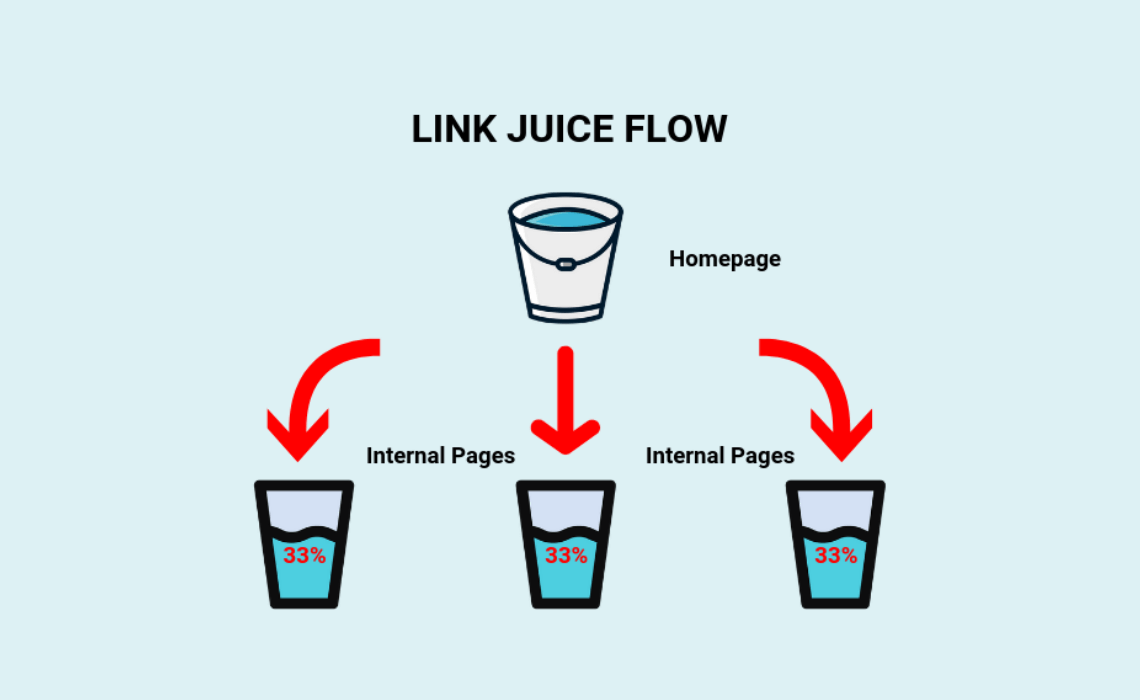
How does link equity work?
Link equity can be calculated using many different methods. The most common method is to use the PageRank algorithm.
The PageRank algorithm was created by Google and is used to determine the quality of a website. The algorithm looks at the number and quality of links pointing to a website to determine its PageRank score.
The higher the PageRank score, the more link equity a website has.
Another method for calculating link equity is Moz's Domain Authority (DA) metric. Domain Authority is similar to PageRank in that it looks at the number and quality of links pointing to a website.
However, Domain Authority also takes into account other factors, such as the age of the domain and the quality of the linking websites.
Domain Authority is a good metric to use when comparing the link equity of two websites.
How do you increase link equity?
There are a few ways to increase the link equity of your website:
1. Publish high-quality content.
This is the most important way to increase the link equity of your website. By publishing great content, you will naturally attract links from other websites. Remember, external links provide more ranking value compared to internal links. With that being said, focus on publishing great content that other websites will want to link to.
2. Determine the quality of the linking website.
Not all links are created equal. A link from a high-quality website will pass more link equity than a link from a low-quality website.
Therefore, it's important to determine the quality of the linking website before you build a link. You can do this by looking at the PageRank or Domain Authority score of the website.
3. Don't forget your internal links.
Internal links are also important for passing link equity. Make sure to include internal links in your content to other pages on your website. This will help increase the link equity of those pages.
Conduct a google site search of your website by using the following query on google: site:[yourdomain.com] + "keyword" to see what pages are being linked to the most, or to find content relevant to your target keyword that you can add internal links to.
4. Reclaim your broken links.
A broken link is a link that points to a page that no longer exists. These links are often the result of a change in website structure or a URL change.
If you find broken links on other websites, you can contact the website owner and ask them to replace the link with a link to your website. This is an easy way to get high-quality links from websites.
5. Delete or disavow low-quality links.
Low-quality links are links from spammy or low-quality websites. These links can hurt your website's ranking in search results.
If you find low-quality links pointing to your website, you can either contact the website owner and ask them to remove the link or use Google's disavow tool to disavow the link.
How do I get link juice?
In the past, getting link juice could simply be done by buying links from other websites. However, this is no longer the case.
Today, the best way to get link juice is to publish great content and build high-quality links naturally. By doing this, you will increase the link equity of your website, which will help improve your website's ranking in search results.
There are a few things to keep in mind when trying to get link juice:
- Quality over quantity: It's better to have a few high-quality links than a bunch of low-quality links.
- Avoid link farms: Link farms are websites that exist solely for the purpose of selling links. These websites often sell links for very low prices, which can hurt your website's ranking.
- Publish great content: As mentioned before, the best way to get link juice is to publish high-quality content that other websites will want to link to.
- Monitor your links: It's important to monitor the links pointing to your website. This will help you identify any low-quality links that could be hurting your website's ranking.
- Use different types of content: In addition to writing great blog posts, you can also get link juice by creating infographics, videos, podcasts, or other types of content that other websites will want to link to.
- Reach out to unlinked brand mentions: If you find that other websites are mentioning your brand but not linking to your website, you can reach out to them and ask them to link to your website. Check out this link reclamation guide.
- Broken link building: If you found a good page that is no longer available, you can reach out to the website owner and ask them to link to your website or content instead. Further reading on broken link building.
- Guest blogging: One of the best ways to get high-quality links is to guest blog on other websites. This is a great way to build relationships with other bloggers in your industry while also getting your name and website in front of a new audience. Learn more about guest post service.
- Infographics: People love visual content, and infographics are a great way to get link juice. Not only do they get shared a lot on social media, but they also tend to be linked to from other websites.
- The Skyscraper Technique: The Skyscraper Technique is a method of link building that involves finding content that is already popular and creating something even better. This is a great way to get links from other websites because you are offering something new and valuable.
- Resource Page Link Building: Resource pages are pages on a website that lists all of the resources related to a certain topic. If you have a piece of content that would be a good fit for a resource page, you can reach out to the website owner and ask them to link to your content.
- Wikipedia link building: Wikipedia is one of the most popular websites in the world, and it's also a great way to get high-quality links. If you have a piece of content that would be a good fit for Wikipedia, you can submit it to the site. Wikipedia will add links in the footnotes and references section, which will help improve your website's ranking.
- Local link building: If you have a local business, you can get links from other local businesses in your area. This is a great way to build relationships with other businesses while also getting your website in front of a new audience.
- Profile link building: Profile link building is a great way to get links from other websites. You can create profiles on social media sites, directory sites, and forums, and include a link to your website in your profile.
- Directory link building: Directory link building is a great way to get links from other websites. You can submit your website to online directories, and include a link to your website in your profile.
- Forum link building: Forum link building is a great way to get links from other websites. You can participate in forums related to your industry, and include a link to your website in your signature.
- Reach out to links will no-follow tags: If you find a link to your website that has a no-follow tag, you can reach out to the website owner and ask them to remove the tag and make a follow attribute.
Generally, website owners are happy to do this if you provide them with value such as a link back to their website from an equally good website.
Frequently Asked Questions
How long does it take link equity to affect a site?
There is no definitive answer to this question, as it can vary depending on a number of factors. However, it is generally agreed that it can take anywhere from a few weeks to a few months for link equity to have an impact on a website's ranking.
How to find out which blog posts have the most link equity?
There are a number of ways to find out which blog posts have the most link equity. One way is to use a tool like Moz's Open Site Explorer, which allows you to see how many links each page on your website has.
Another way is to use a tool like BuzzSumo, which allows you to see how popular each piece of content on your website is.
Finally, you can also ask Google which pages on your website have the most link equity by using the "link:" operator.
How to maintain link equity when updating taxonomy?
When updating your website's taxonomy, it is important to maintain the link equity of your existing pages. One way to do this is to use a tool like Screaming Frog, which allows you to find all of the links on your website and redirect them to the new pages.
Another way to maintain link equity is to use a 301 redirect, which permanently redirects visitors from one page to another.
Finally, you can also use a rel="canonical" tag, which tells search engines that a certain page is the preferred version of a page with duplicate content.
How do links to your site help you?
Links to your website can help improve your website's ranking in search engines, as well as increase traffic to your website.
Links can also help build relationships with other websites, which can lead to opportunities for guest posting, joint ventures, and other partnerships.
How is link equity determined?
Link equity is determined by a number of factors, including the number of links pointing to a page, the quality of the links, and the anchor text of the links.
Here's a quick checklist on determining the value of a link:
1) Is it relevant?
2) Is it coming from a high-quality, authoritative website?
3) Is the link a follow link?
4) Is the link surrounded by other links?
5) Does the status code of the page return a 200 OK?
6) Is the link an exact match to the keyword you're targeting?
7) Is the link surrounded by other links with the same anchor text?
8) Is the link from a website that is in the same country as your target audience?
9) Is the link from a website that is in the same language as your target audience?
10) Does the website linking to you have a similar theme as your website?
If you answered "yes" to all of these questions, then the link is likely to be valuable.
Which types of links are the most valuable?
The most valuable links are those that come from high-quality websites that are relevant to your website.
Links from directories and forums are also valuable, as they can help increase the visibility of your website.
Can I lose link equity if a linking website goes down or removes the link?
Yes, if a linking website goes down or removes the link to your website, you may lose some of the link equity that you gained from that link. Link equity is a measure of the strength or value of a webpage based on the number and quality of the links pointing to it. When a linking website goes down or removes the link, it can negatively impact the link equity of the linked webpage.
This is because the inbound link is no longer available to pass value to the webpage. It is important to monitor the health and quality of your inbound links to ensure that they are helping rather than hindering your search rankings.
Can I transfer link equity from one webpage to another on my website?
Yes, you can transfer link equity from one webpage to another within your website through the use of internal linking. Internal linking is the process of linking from one webpage on your website to another webpage on the same website. This can help to distribute link equity and authority throughout your website, and can also help search engines to better understand the structure and content of your website.
To transfer link equity through internal linking, you can use hyperlinks to link from one webpage to another within your website. The link equity of the linking webpage will be passed to the linked webpage, helping to improve its ranking in search results. It is important to use relevant and high-quality internal links to ensure that the link equity is being passed effectively and to avoid diluting the link equity of your website.
In addition to transferring link equity, internal linking can also help to improve the user experience by making it easier for visitors to navigate your website and find the content they are looking for. It can also help to increase the crawlability of your website by providing search engines with more pathways to discover and index your content.
Can I lose link equity if I change the URL of a webpage?
Yes, if you change the URL of a webpage, you may lose some of the link equity that the page had previously accumulated. Link equity is a measure of the strength or value of a webpage based on the number and quality of the links pointing to it. When you change the URL of a webpage, the inbound links that were pointing to the old URL will no longer be pointing to the page, and the page will need to start building link equity from scratch.
To minimize the loss of link equity when changing the URL of a webpage, it is important to use a 301 redirect. A 301 redirect is a permanent redirect that tells search engines that the old URL has been permanently moved to the new URL. This helps to preserve the link equity of the page by transferring the value of the inbound links from the old URL to the new URL.
It is important to note that changing the URL of a webpage can also have an impact on the ranking of the page in search results. This is because search engines use the URL of a webpage as one of the factors in determining its ranking. As a result, it is important to carefully consider the impact of changing the URL on both the link equity and the ranking of the page.
Can I gain link equity from a nofollow link?
A nofollow link is a type of hyperlink that tells search engines not to follow or count the link as a vote of endorsement for the linked webpage. While nofollow links do not pass link equity in the same way as dofollow links, they can still be valuable for a number of reasons.
One reason is that nofollow links can help to drive traffic to your website. When a user clicks on a nofollow link, they will be directed to your website, which can help to increase your traffic and visibility.
Another reason is that nofollow links can indicate to search engines that your website is being mentioned or referenced by other websites. This can help to improve the credibility and authority of your website, which can in turn help to improve its ranking in search results.
It is important to note that while nofollow links may not directly contribute to link equity, they can still be valuable for other aspects of search engine optimization. As a result, it is important to consider the value of nofollow links in the context of your overall SEO strategy.
Link Exchange: The Proper Way To Do Reciprocal Linking
What is a link exchange?
Link exchange is a process where two websites agree to place each other's links on their respective websites in order to improve their search engine rankings and drive more traffic to their sites.
Though this practice has been abused for many years, e.g. a webmaster tries to rank for terms like “car insurance Australia” will find other webmasters in the same/different industry who would be interested in doing link exchanges.
The approach is to link to another website with exact match anchor text (another webmaster is trying to rank for) and get a link from that other website (for a target keyword he is trying to rank for as well).
Google itself instructed SEOs and webmasters about this approach of trying to manipulate Google search rankings.
“ Excessive link exchanges ("Link to me and I'll link to you") or partner pages exclusively for the sake of cross-linking. “
Does that mean, link exchange isn’t effective anymore these days?
The Rise Of Thematic Link Exchange
I’m sure many SEOs and bloggers will disagree with me that thematic link exchange still works up to this date.
Thematic link exchange is a relationship-based link building strategy that involves intentional or unintentional linking and getting a link to and from another webmaster in the same industry who isn’t a direct competitor of the business.
Here are four thematic link exchange methods that work pretty well in most industries, especially those that are sitting in very competitive ones.
1. Relationship-based Link Acquisition
Link exchange often occurs in an unintentional way. For example, I’ve been blogging for many years now with my first blog and here at SharpRocket.
I’ve built relationships with industry friends who also blog about SEO and link building.
By acknowledging their work through linking to their content assets that serve as additional references or resources in my existing posts, it’s an added value initiated to build trust which strengthens the open relationship with them.
For instance, I linked to Rohit Palit’s post on tiered link building. After a few months, he gave me a backlink pointing to my content creation and promotion guide in his article about increasing the domain authority of a website.
We’re not direct competitors, as he is not accepting sole link building services as his website client offering.
But here’s another case where one of my direct competitors linked to me.
PageOnePower is a link building company that has been in the industry since 2010, they blog about the same topic I’m passionate about.
Here are a few backlinks I gave to PageOnePower.

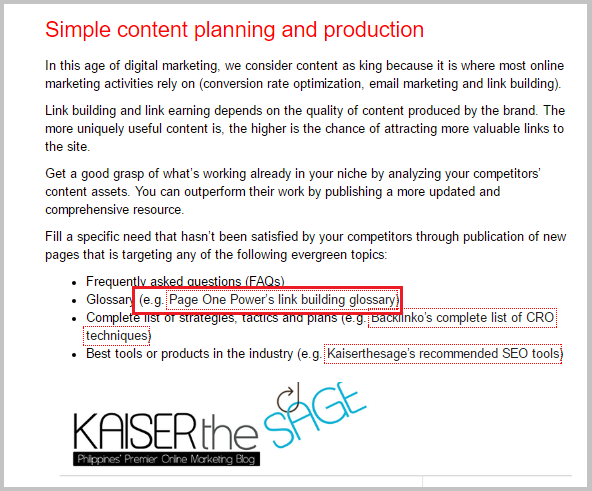
Relationships take time to get some returns. Guys from PageOnePower have give contextual backlinks to DigitalPhilippines many times.
These are backlinks not built through manual outreach, but simply because they’ve known our brand, we have already given them and have established an authority in the link building scene. These backlinks are naturally earned.
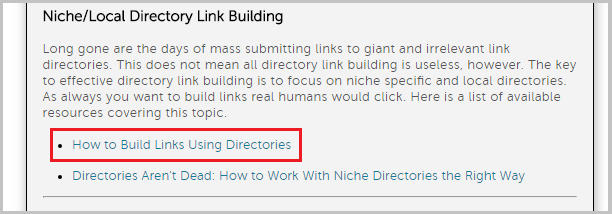
Here is another example of how relationships can be effective for link exchanges. It is a conversation between Rohit Palit and Patrick Coombe.
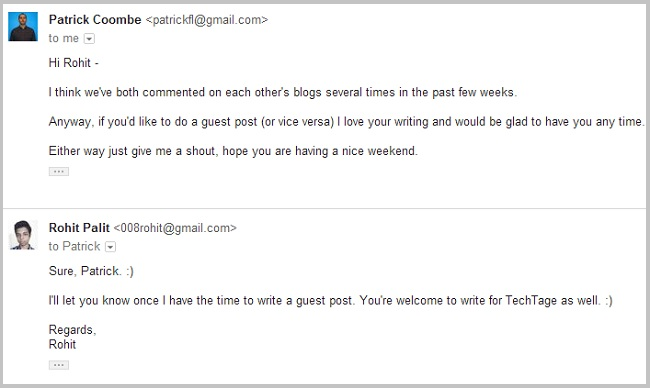
Both have provided value to each other, as they’ve been commenting on each other’s blogs many times (see image above).
If you’re wondering how you can start building relationships with other industry bloggers, here are a few tips you can apply:
- Start showing yourself in the blogosphere. Comment on other people’s blogs. It’d only take you 3 to 5 minutes for each comment per post (only look for relevant content you can give valuable insights to). If each blogger posts once every week, it won’t consume much of your time.
- Send a “thank you” email for sharing his actionable tips on his blog or find a similar interest both of you can relate with. For example, I often receive responses that they’ve visited Manila or some other parts of the country, so I asked them how’s their vacation experience here. It starts a smooth flow of conversation.
- Share other bloggers’ content on other blogs. Don’t use the default Twitter share: TITLE OF POST by TWITTER HANDLE. Add descriptive call-to-actions to let your followers click on the page and start reading it – it’s way to add more value than the simply doing a default Twitter share.
2. Content Swap
Guest posting is still one of the mainstream link building method these days because it’s pretty scalable and can really help skyrocket one website’s traffic even in just a short period. Combined with other link building tactics, it is a robust link building strategy one can ever wish to implement and see results for themselves.
However, there’s one problem I’ve seen with many guest posting inquiries these days -- they aren’t giving any value. Even if the content they intend to provide is relevant to my blog, I won’t see that as high value.
Content swap is the solution. It is a link acquisition process where both bloggers will provide high-value content to each other, with the goal of bringing exposure to a new reading audience for both sides.
This is very helpful when building links to websites in difficult industries like legal.
You can actualize this process by prospecting for a list of local opportunities, where most legal industries focus on local marketing/branding.
You can try Google searches for “Miami” “legal” for example, then find any company websites that have recent blog updates so you’ll know if they are publishing content on a regular basis. Make sure that you don’t include link prospects that are not in direct competition with you – it’ll be close to impossible to get links from them.
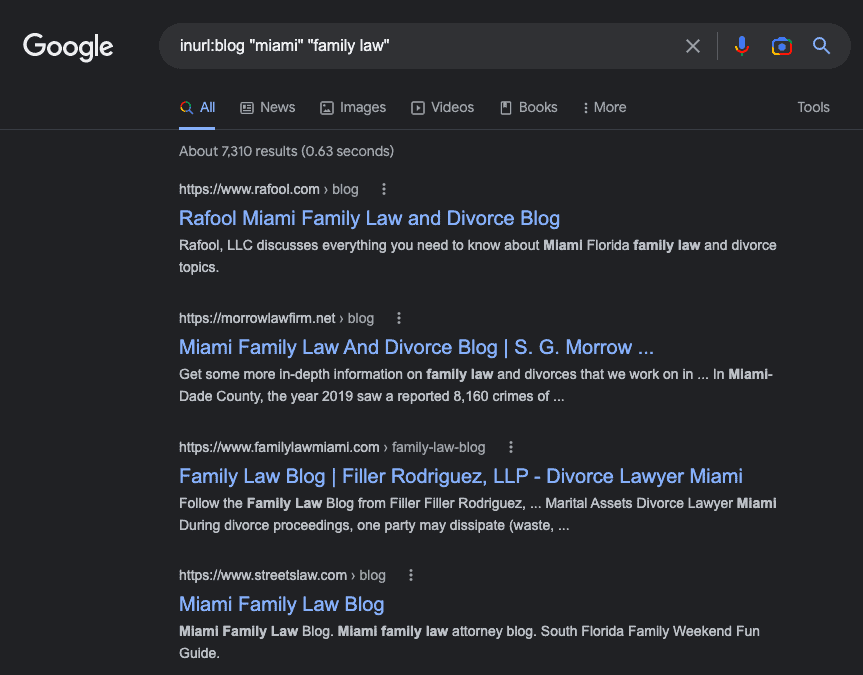
Once you have a list of local industry bloggers, it’s time to reach out to them.
Here’s a template that I used for content swap outreach.
Subject: Content swap for your legal blog, %Name%
Hi %Name%,
My name is Tiffanny Chappels, an immigration lawyer and legal blogger based in Miami.
I came across your website and really like what you recently published. I would like both of our blogs to grow website traffic and would like to know if you'd be interested for a content exchange - I write for your blog, you write for mine.
I'd love to write a post for your blog related to child custody or family law.
If it needs to be in a conversational tone, I'd be happy to do that.
Let me know if your thoughts.
All the best,
Tiffany
A few things why this pitch works:
- Industry-to-industry-based outreach emails is much more effective as they become more relevant to the recipient of the email.
- Adding where you’re located as a company adds a quick connection, with that, you can use a corporate email of your client.
- Propose added value by sharing customized content for your guest post – conversational tone. This helps you get a higher conversion rate.
3. Content Partnership
Another ethical backlink exchange strategy that works is a content partnership, originally discussed by Jason Acidre on his SEO blog.
I’ve found that this is not scalable to all industries, especially in niches where there are no active bloggers.
But the key to making this link building method work is making yourself familiar with the brand you’re reaching out to. After all, you want a partnership that can generate consistent results for both ends.
The difference with this link building technique compared to content swap is that you can offer different types/formats of content based on each party’s needs, options such as:
Conducting a back-to-back interview. See this example at SEO Hacker and Kaiserthesage.
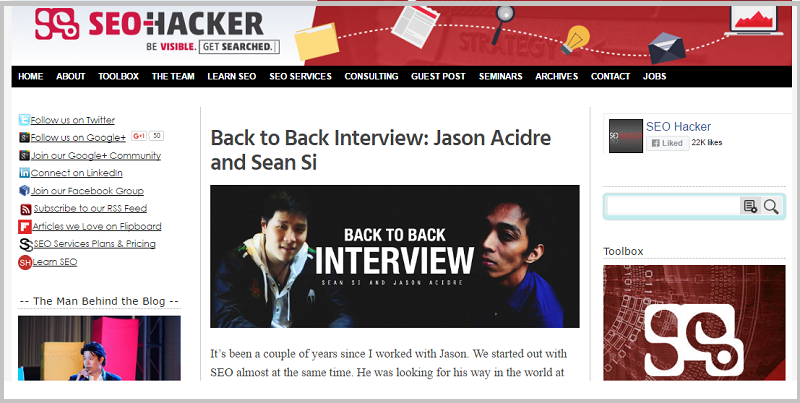
Inviting your content partner to write a guest blog on your site and writing content for them as well (see this guest post at GotchSEO and Webris).
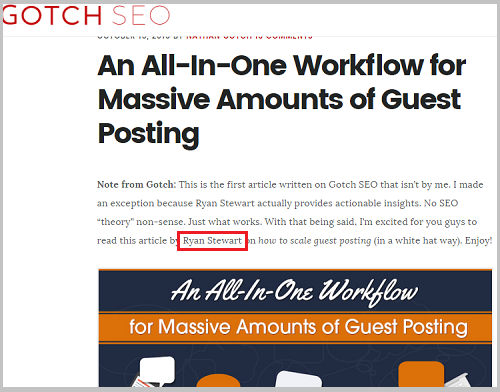
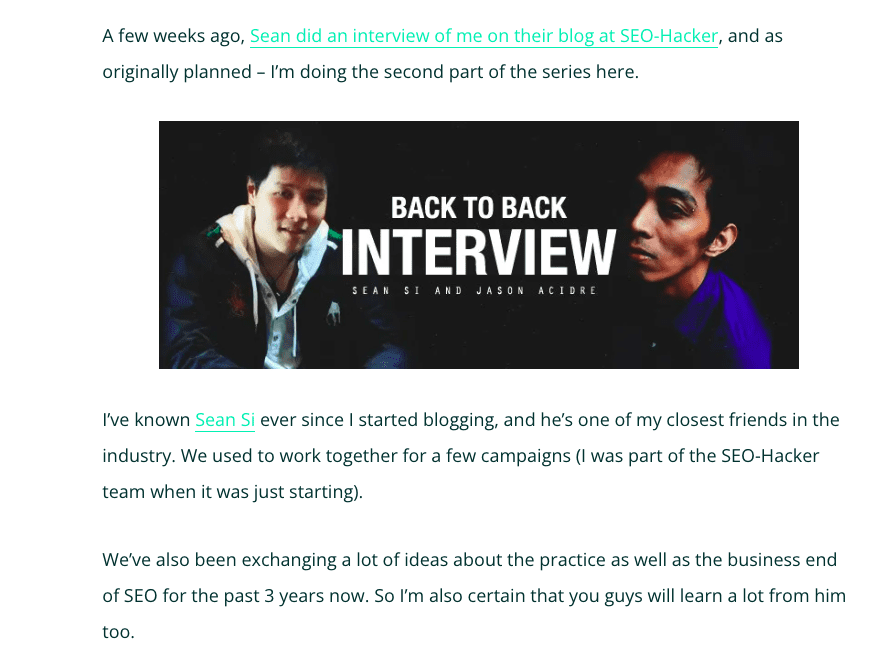
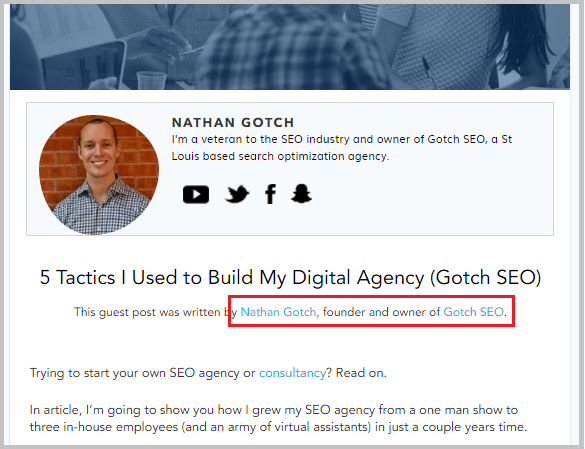
Offering an exclusive write-up or promotion/sponsored post on his site and in exchange, making him as your media partner. I wrote a promotional post for my previous startup workshop for Tycoon, in return, I added him as my media partner for my book.

For the outreach phase, here is an example pitch Jason sent to one of his content partners. You can make variations of it based on the value proposition you’d like to provide to your targeted content partners.
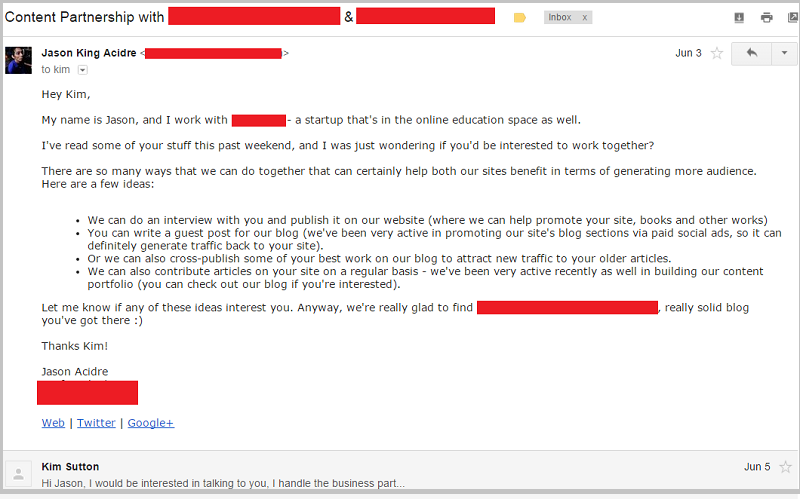
The value of this thematic link exchange strategy is far more beneficial than a single link you’ll get from the typical link exchange, because this content partnership can help generate leads for both parties (of course they shouldn’t be competing with each other), referral traffic, expanded branded exposure/influence and additional following for both social accounts.
Now It’s Your Turn…
Do you have a thematic link exchange strategy that works for you?
Or maybe you have a question about implementing any of the tactics in our above list?
Either way, leave a quick comment below.
I'll be more than happy to reply to comments and answer questions.
Frequently Asked Questions About Link Exchange
Is link exchange still effective for SEO?
Link exchange was once a popular technique for improving search engine rankings, but it is now generally considered to be less effective than it was in the past. This is because search engines have become more sophisticated and can now more easily identify and penalize websites that engage in link exchange solely for the purpose of manipulating search engine rankings.
It's important to note that links from other websites can still be a valuable part of a comprehensive search engine optimization (SEO) strategy, but they should be earned through high-quality content and natural outreach efforts rather than through link exchange agreements.
Search engines like Google use complex algorithms to evaluate the quality and relevance of websites and assign them a ranking in search results. While links from other websites can be one factor that is considered in these algorithms, they are just one of many factors, and they are not as important as they once were.
In general, it is more effective to focus on creating high-quality, informative content that will naturally attract links from other websites rather than trying to manipulate search engine rankings through link exchange. This will provide more value to your website's visitors and will be more sustainable over the long term.
Is link exchange considered spam?
Link exchange is not necessarily considered spam, but it can be if it is done in a way that is considered to be manipulative or deceptive. For example, if a website engages in link exchange with other websites solely for the purpose of boosting its search engine rankings, it could be considered spam.
In general, search engines do not look favorably upon practices that are intended to manipulate search engine rankings or deceive users. This includes link exchange schemes that are designed solely for the purpose of manipulating search engine rankings, rather than for the purpose of providing value to users.
It's important to note that participating in link exchange can be a legitimate and valuable part of a comprehensive SEO strategy, as long as it is done in a way that is transparent and provides value to users. This might include participating in link exchange with other websites in your industry or niche, or creating valuable resources that other websites will want to link to.
However, it's important to avoid participating in link exchange schemes that are designed solely for the purpose of manipulating search engine rankings, as this can be considered spam and could result in penalties from search engines.
What are some alternatives to link exchange?
There are several alternatives to link exchange that can be more effective for improving search engine rankings and driving traffic to your website. These include:
- Creating high-quality, informative content: One of the most effective ways to attract natural links from other websites is to create content that is valuable and informative to your target audience. This might include blog posts, articles, infographics, videos, or other types of content that provide value to your visitors.
- Earning links through public relations and marketing efforts: Another way to earn links is to engage in public relations and marketing efforts that can help to promote your website and its content to a wider audience. This might include guest blogging, speaking at conferences, or participating in industry events.
- Participating in relevant online communities and forums: Building relationships with other professionals and experts in your industry or niche can be a great way to earn links. This can be done by participating in relevant online communities and forums, such as LinkedIn groups or industry-specific forums.
- Building relationships with influencers: Influencer marketing can be a powerful way to earn links and drive traffic to your website. This involves building relationships with influencers in your industry or niche and working with them to promote your website and its content to their followers.
- Using social media to promote your content: Social media platforms like Facebook, Twitter, and Instagram can be powerful tools for promoting your content and earning links. By regularly posting high-quality content and engaging with your followers, you can drive traffic to your website and earn natural links from other websites.
How can I find websites to participate in link exchange with?
There are several ways to find websites to participate in link exchange with:
- Search for websites in your industry or niche: One way to find websites to participate in link exchange with is to search for websites in your industry or niche that may be interested in link exchange. You can use search engines like Google or specialized link exchange directories to find potential partners.
- Use link analysis tools: Tools like Ahrefs or Majestic can help you identify websites that are already linking to similar websites in your industry or niche. You can use these tools to find potential link exchange partners and reach out to them to see if they would be interested in linking to your website as well.
- Join a link exchange network: Another option is to join a link exchange network, which is a group of websites that agree to link to each other in order to improve their search engine rankings. Link exchange networks can be a good way to find potential partners, but it's important to be cautious and make sure that the websites in the network are of high quality and relevant to your own website.
- Consider other types of partnerships: In addition to link exchange, there are other types of partnerships that you can pursue in order to improve your search engine rankings and drive traffic to your website. This might include guest blogging, content syndication, or cross-promotion with other websites.
How do I measure the success of a link exchange?
- Track traffic from the linked website: One way to measure the success of a link exchange is to track the traffic that you receive from the linked website using tools like Google Analytics. By looking at the referral traffic from the linked website, you can get a sense of how effective the link exchange is in driving traffic to your website.
- Check your search engine rankings: Another way to measure the success of a link exchange is to track the search engine rankings of your website and see if there is an improvement after participating in the link exchange. You can use tools like Ahrefs or SEMrush to track your rankings and see if they have improved as a result of the link exchange.
- Check your Domain Authority (DA) and Page Authority (PA): Domain Authority (DA) and Page Authority (PA) are measures of the strength and quality of a website or web page, respectively. Higher scores indicate that a website or page is more likely to rank well in search results. You can use tools like Ahrefs or Moz to check your website's DA and PA and see if they have improved as a result of the link exchange.
- Monitor your website's overall performance: In addition to tracking specific metrics like traffic and search engine rankings, it's also important to monitor your website's overall performance and see if the link exchange is having a positive impact. This might include looking at metrics like website traffic, user engagement, and conversions.
Can I participate in link exchange with websites in different languages?
Yes, you can participate in link exchange with websites in different languages. This can be a good way to reach a wider audience and drive traffic to your website from other countries. However, you should be aware that search engines may treat links from websites in different languages differently, so it's important to carefully consider the potential impact on your search engine rankings before participating in link exchange with websites in different languages.
It's also important to consider the language and cultural differences when participating in link exchange with websites in other countries. For example, you should make sure that the content on your website is appropriate and relevant for the target audience, and that the link exchange is transparent and provides value to users.
Finally, it's a good idea to use a translation tool or professional translation service to ensure that any communication with the website owner or webmaster is clear and accurate. This will help to ensure that the link exchange process goes smoothly and that both parties are able to benefit from the arrangement.

